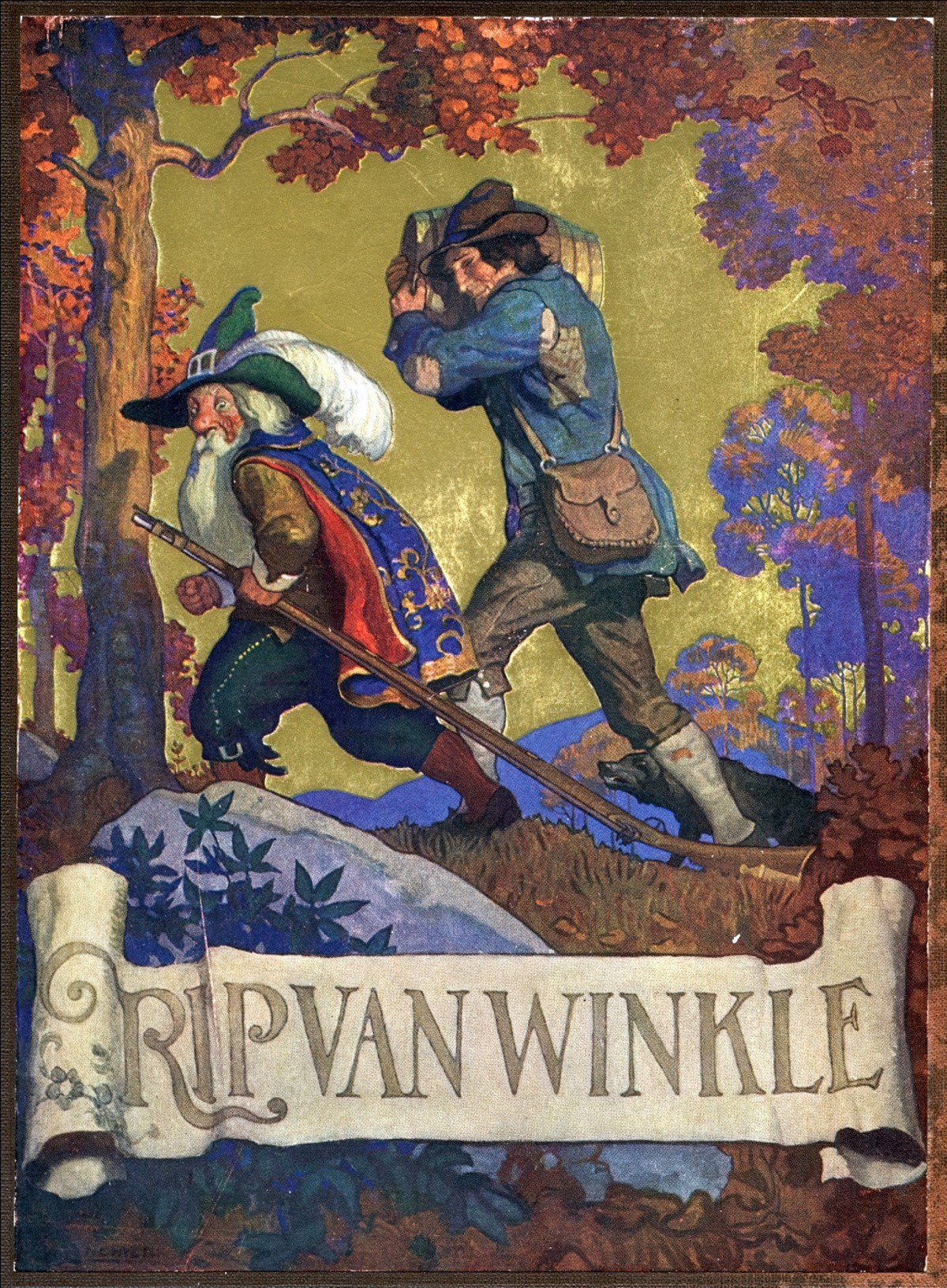I finally read the short story “Rip Van Winkle” (1819), by America’s first well-recognised author, Washington Irving. Some say that Irving invented the American short story. (Nathaniel Hawthorne and Edgar Allan Poe turned it into literary art.) Importantly to the history of literature, “Rip Van Winkle” is one of the first allegories which features an archetype in human form rather than in animal form. It’s easy to miss that this story is allegory. Or satire, for that matter.
This is a misogynistic story, though some argue that since Washington Irvine was well-known for his satire, this is a clearly satirical , and satirical stories can’t possibly be influential in changing people’s thinking for the worse. This camp of reader argues that the satire is so very subtle it is lost on readers who take issue with the misogyny. They tend to argue that the author is as hard on Rip as he is on Rip’s unnamed wife.
My take: Of course a story can be both satirical and misogynistic. Satire has always been a wonderful vehicle for influencing culture and maintaining stereotypes. In fact, satire is built for exactly that.
Also:
- No point arguing about whether Washington Irving was a misogynist himself or not. That is the most uninteresting debate we could possibly have about this story. Misogyny is structural. 1819 America was immensely misogynistic to the point where if a writer tried to ‘come down equally on both husband and wife’, the pendulum sat so far over to the misogynistic side that to go one inch towards fairness would’ve felt left-wing.
- Satire is particularly sensitive to the era in which it’s written. Something which feels genuinely satirical in one century probably won’t two entire centuries later.
- A story is a collaboration between creator and reader. Ergo, even if the satirical tone endures across centuries, a work of art can still function to uphold misogyny rather than challenge it. If a reader enters this story with the preconceived notion that women are typically ‘nags’, that notion will not be challenged by this story, independent of era. This story will confirm a misogynistic worldview.
useful term: heteropessimism
When straight folk hate the opposite gender but stick rigidly to heteronormativity anyway. As a result, straight people end up feeling trapped and held hostage by their sexual orientation.
How to recognise it: Men will start talking about ‘the ball and chain’. Women will find Momlife comics relatable and funny.

WHAT HAPPENS IN THE STORY
“Rip Van Winkle” is basically one long ‘ball-and-chain’ joke, because it’s the story of a man who can’t stand his wife. Yet this story has been bowdlerised for children numerous times over, introducing prepubescent children to the trials of overfamiliarity of a long marriage long before they’ve experienced the rush of excitement of adolescent love. Weird, no? Why tell this tale to kids? Well, it does contain fairies, or goblin-like creatures. And children do need to be taught the gender hierarchy from birth, otherwise HOW WILL THE PATRIARCHY BE UPHELD?
Worth noting: Although this is a well-known American story, the author draws heavily from German folk tale. Irving himself acknowledged that.
In mid-1700s British America, a married father called Rip Van Winkle, importantly: a drunkard, fails to uphold his end of the marital bargain. He doesn’t earn an income. Nor does he work his own farm. This pisses his wife off. Big time. Instead of keeping quiet, she tells him about it. Frequently. Loudly. Before houses had insulation, the whole street would’ve heard her go off.
However, Rip is mighty popular around the village (with everyone but his own wife). Rip’s (unnamed) wife has a loud, shouty voice and chastises him publicly, which, because of misogyny, encourages everyone in town to side with poor, ‘henpecked’ Rip.
Instead of maintaining his own damn household, Rip Van Winkle passive-aggressively does odd-jobs, and even childcare, for other women. He’ll help anyone out, so long as it’s not his own wife. The more she tells him to pull his weight, the more belligerent he becomes. Rip will play with kids, so long as they’re not his own kids. This maintains Rip’s public image as a Nice Guy (TM).
Grooming everyone else in the village is a common tactic of those who abuse their own families in private.
Meanwhile, Rip’s wife keeps everything spick and span on the home front, taking care of the full-time dawn-to-dusk job of 1800s housework as well as somehow earning the family income, we must deduce. I can’t think how the Dame would have earned money for Rip to eat (AND DRINK ALCOHOL) other than doing jobs to lighten the load of the other village women (sewing, washing, butter churning etc.). The other women despise Rip’s wife not only for being the town ‘shrew’, but also for the fact she is of the servant class. A woman who is loud when women aren’t meant to challenge their husbands at all cements the stereotype that ‘women (in general) are nags and shrews’. This doesn’t help the cause of the other women. They don’t understand this isn’t Dame Van Winkle’s fault. Words such as ‘patriarchy’ and ‘misogyny’ and ‘gender’ do not yet exist. Also, they wish their own husbands were as involved with their children as Rip is. Of course, their own husbands are off earning a living, and are not expected to do a single thing with their children. It’s not apparent to these women that Rip does nothing for his own children. They either choose not to see, or do not have the full picture.
One day, Rip buggers off to the wild with his dog instead of getting a damn job or pulling his weight around the house. He drinks a ‘potion’, hallucinates a band of men and falls asleep in the Catskills.
When he awakes, he is very stiff. He ambles towards home but doesn’t recognise his village. Turns out twenty years have passed.
His house has fallen into disrepair, his wife has recently died, his grown son is a layabout just like him, but his daughter is doing well and now has a child of her own.
Rip doesn’t care about losing his own wife. What bothered him most was finding his dog, then realising it wasn’t his dog at all. Wolf has long since died, of course.
Conveniently for himself, Rip also missed the American Revolution (1765 — 1791). No matter. Other men went off to fight on his behalf.
Now that Rip is an old man, and no longer has obligations to his wife and village, no one expects him to do much anyway, other than what he always has done: Sitting around chatting and drinking. And now he has the most magnificent tall story to tell.
He will live the remainder of his life doing not much at all, looked after by his daughter who was never properly parented by him, and in death he will become a legend.
Annotated Rip Van Winkle
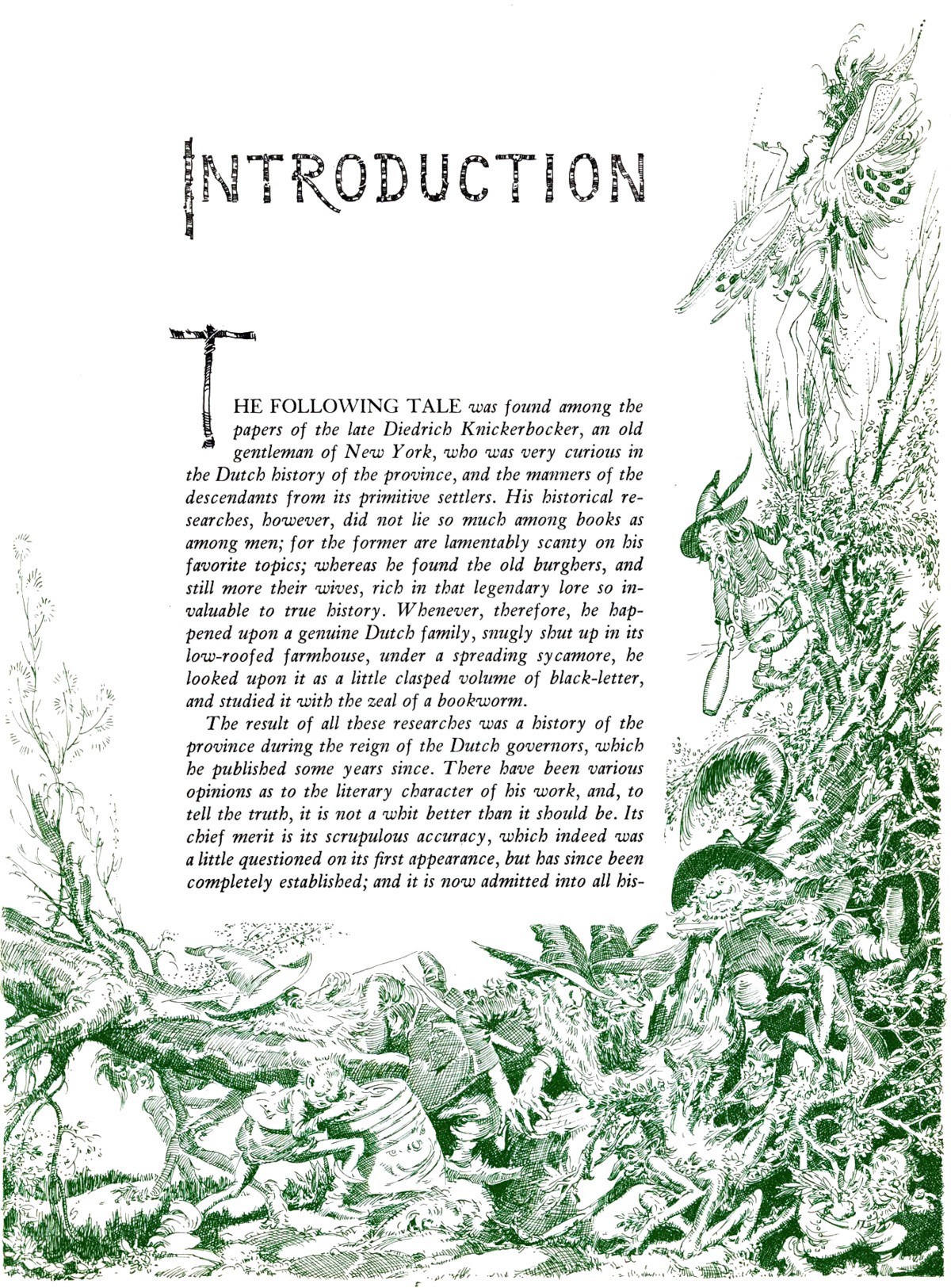
The following tale was found among the papers of the late Diedrich Knickerbocker, an old gentleman of New York, who was very curious in the Dutch history of the province, and the manners of the descendants from its primitive settlers. His historical researches, however, did not lie so much among books as among men; for the former are lamentably scanty on his favourite topics; whereas he found the old burghers, and still more their wives, rich in that legendary lore so invaluable to true history. Whenever, therefore, he happened upon a genuine Dutch family, snugly shut up in its low-roofed farmhouse, under a spreading sycamore, he looked upon it as a little clasped volume of black-letter, and studied it with the zeal of a book-worm.
The result of all these researches was a history of the province during the reign of the Dutch governors, which he published some years since. There have been various opinions as to the literary character of his work, and, to tell the truth, it is not a whit better than it should be. Its chief merit is its scrupulous accuracy, which indeed was a little questioned on its first appearance, but has since been completely established; and it is now admitted into all historical collections as a book of unquestionable authority.
The old gentleman died shortly after the publication of his work; and now that he is dead and gone, it cannot do much harm to his memory to say that his time might have been much better employed in weightier labours. He, however, was apt to ride his hobby in his own way; and though it did now and then kick up the dust a little in the eyes of his neighbours, and grieve the spirit of some friends, for whom he felt the truest deference and affection, yet his errors and follies are remembered “more in sorrow than anger,” and it begins to be suspected that he never intended to injure or offend. But however his memory may be appreciated by critics, it is still held dear by many folks whose good opinion is well worth having; particularly by certain biscuit-bakers, who have gone so far as to imprint his likeness on their new-year cakes; and have thus given him a chance for immortality, almost equal to the being stamped on a Waterloo medal, or a Queen Anne’s farthing.
“Rip Van Winkle” is a story told in tall-tale tradition, a genre typically associated with men. In these stories, the teller tries to persuade his audience that what he’s saying really, truly happened. Tall stories are at heart an oral tradition, but Washington Irving has the weight of the written word behind him here, and he makes full use of it. This whole story is a tale-within-a-tale, relayed by a fictional narrator by the name of Diedrich Knickerbocker. In 1809, Washington Irving had published History of New York under this name.
In modern storytelling, American author Daniel Handler invented the same sort of pseudonym as ‘Diedrich Knickerbocker’ when creating ‘Lemony Snicket’, who serves as Handler’s author persona at promotional events on stage. An author alter ago (rather than just a pseudonym) is almost entirely utilised by writers of satire and parody, which is what we have here. Names are chosen for their inherent comedy. (Scholars have studied what makes some sounds funnier than others. There’s a science behind it.) Knickerbocker is wonderfully onomatopoeic.
I was surprised to learn the name ‘Knickerbocker’ not a total invention of Washington Irving himself; Irving had a friend with the actual last name of Knickerbocker.
In Dutch, the friend’s name (Herman) Knickerbocker means, literally, ‘marble baker’, meaning people who make marbles (for kids to play with). ‘Knicker’ means ‘marble’ and comes from ‘knikken’, an onomatopoeic Dutch word for ‘snap’. So even Dutch speakers probably find the name a little amusing.
When carried over into American English, knickerbocker came to mean a Dutch immigrant to New York, and subsequently those baggy long breeches they tended to wear. Eventually the garment was shortened to ‘knickers’, started to be worn by women, under their huge dresses, and now refers to big, feminine underpants.
Without Washington Irving, we may not have the word ‘knickers’. I kind of wish we didn’t. Like anything to do with women’s outer sex characteristics, the word takes on an uncomfortably humorous, dismissive connotation. We see it in ‘Don’t get your knickers in a twist’.
The feminisation of this idiom becomes even more clear in its alternative, ‘Don’t get your panties in a bunch’, suggesting it is women who make a song and dance over what rational and sensible men are able to, sensibly, put to one side. When said to men (and it is), the insult carries an extra layer: The target is embarrassing himself further by behaving like a woman when he makes a big deal over nothing.
This is exactly the message Washington Irving intended to convey. Ironically, he conveyed that message in this story, and also, not meaning to, in his gift to English language of the word ‘knickers’ (which only became feminised much later).
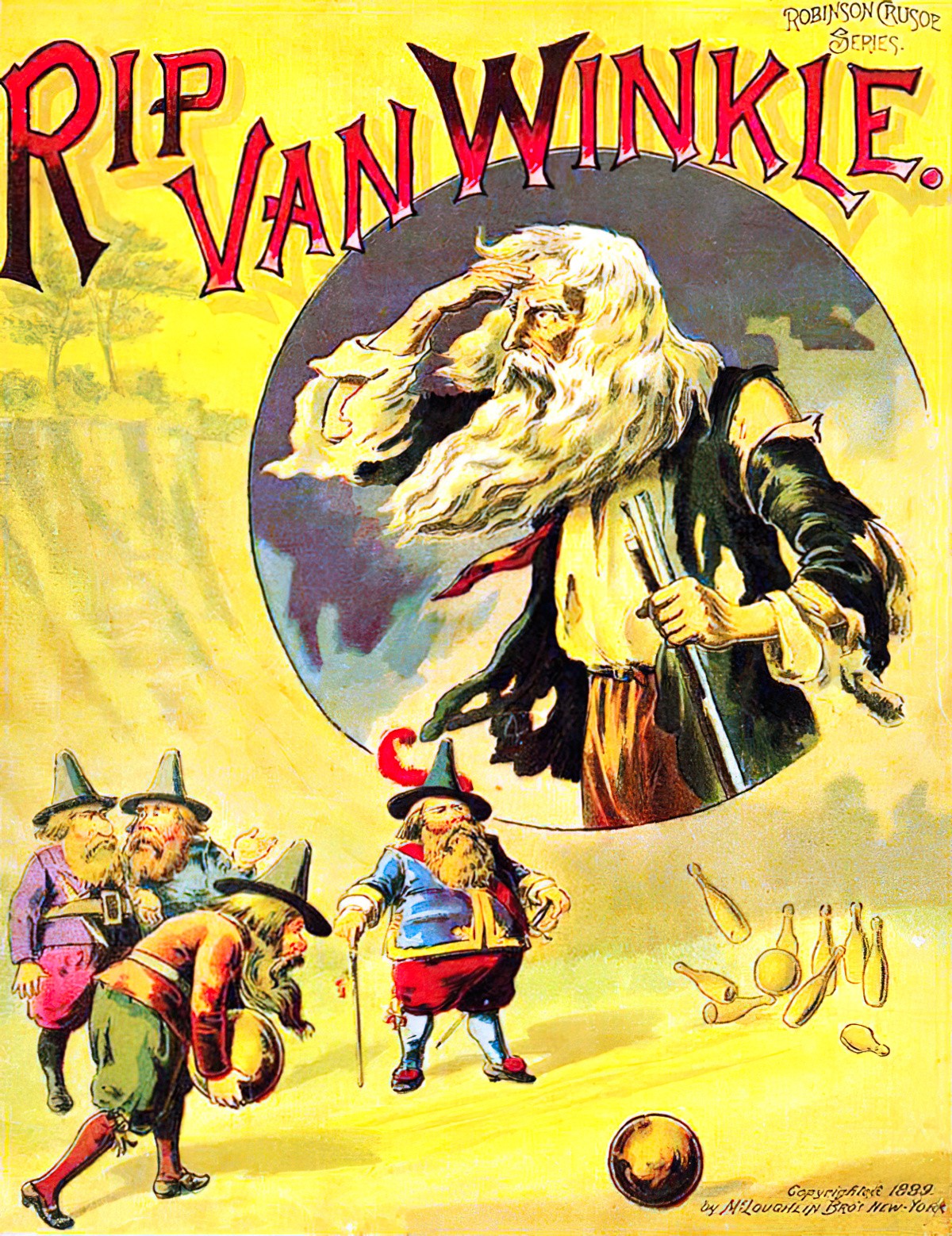
Sometimes foreign words sound hilarious to English speakers, e.g. the Danish word for ‘speed bump’ is Fartsdump.
And in case any English speakers are in doubt, English words can sound hilarious to speakers of other languages. Be mindful when reading “The Three Little Pigs” to Japanese children, or when toasting drinks in Italian, or when talking about the Belgian comic Tintin that the word ‘chin chin’ in Japanese is a cutesy word for ‘penis’.
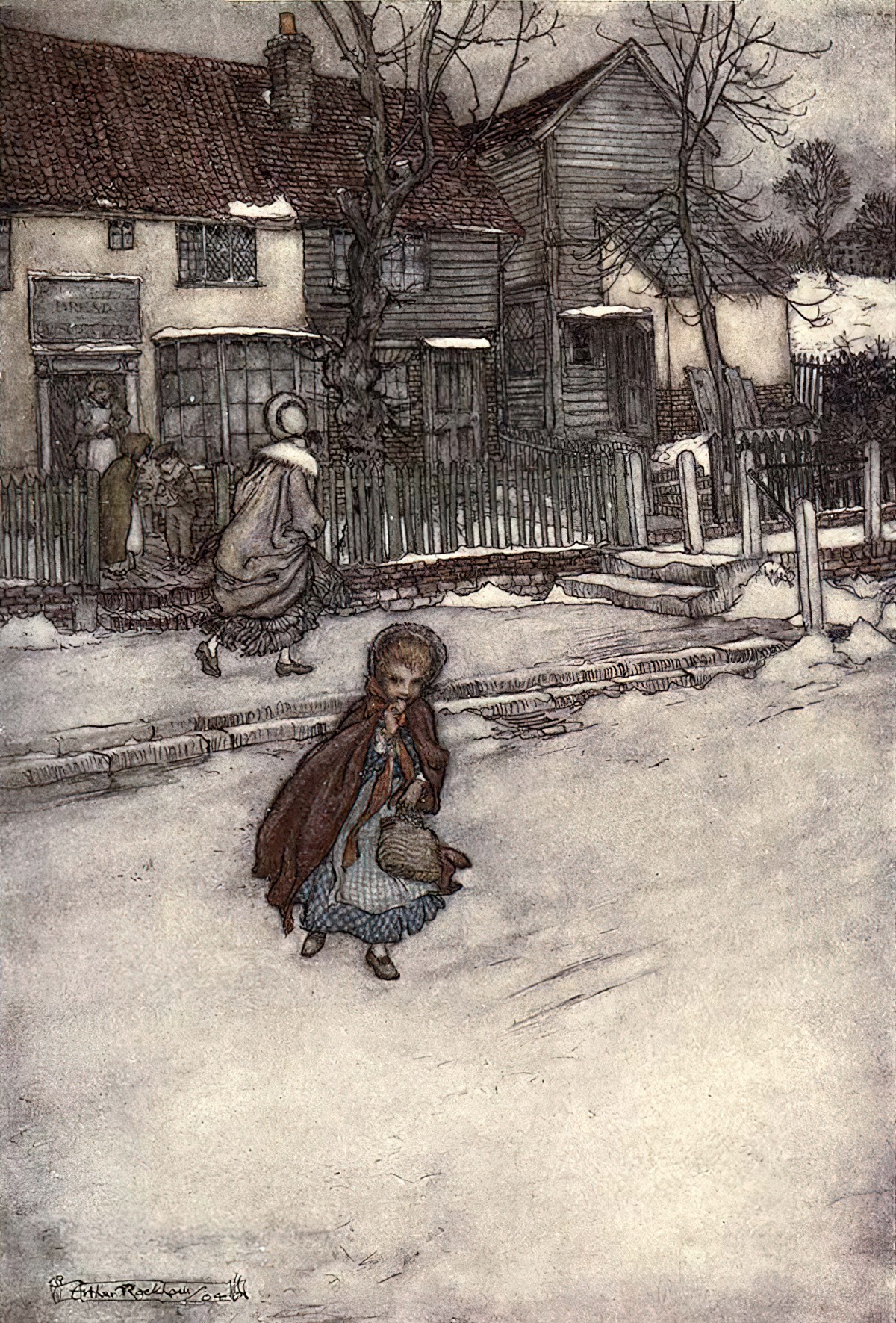
Whoever has made a voyage up the Hudson must remember the Kaatskill mountains. They are a dismembered branch of the great Appalachian family, and are seen away to the west of the river, swelling up to a noble height, and lording it over the surrounding country. Every change of season, every change of weather, indeed, every hour of the day, produces some change in the magical hues and shapes of these mountains, and they are regarded by all the good wives, far and near, as perfect barometers. When the weather is fair and settled, they are clothed in blue and purple, and print their bold outlines on the clear evening sky; but sometimes, when the rest of the landscape is cloudless, they will gather a hood of grey vapours about their summits, which, in the last rays of the setting sun, will glow and light up like a crown of glory.
Ominous and personified: ‘dismembered’. These mountains are also ‘noble’ and ‘lord it over’ the surrounding country. Mere humans are no match for these massive landforms.
As you read, look at the various illustrations and note which artists decided to make use of the colour scheme described here. Arthur Rackham had his own distinctive palette, from which he could not deviate. But N.C. Wyeth was absolutely inspired by this paragraph.
Although this paragraph is ostensibly about regional climate, already it is about the supernatural, with the purple and the personification (the idea that all of nature is populated).
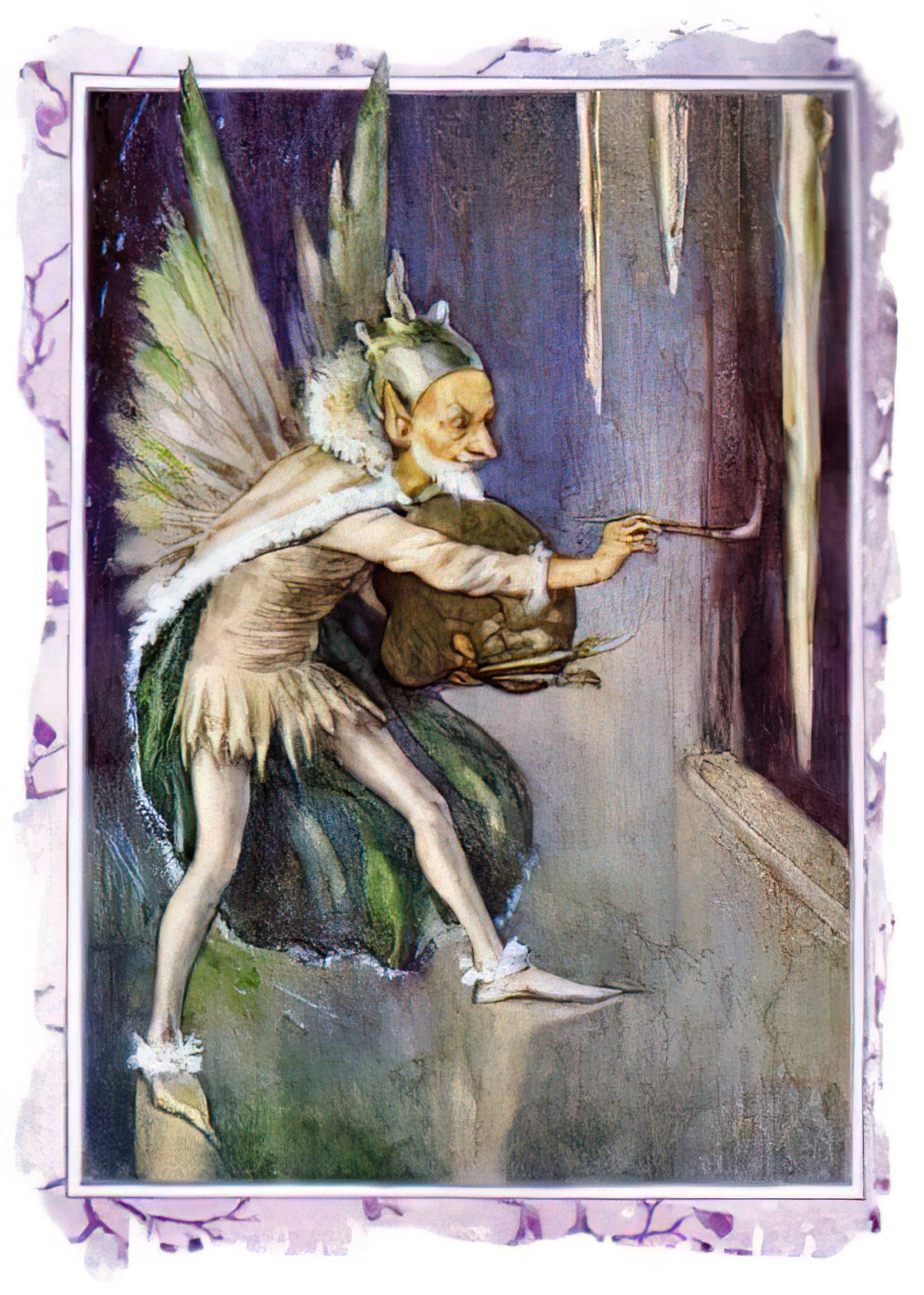
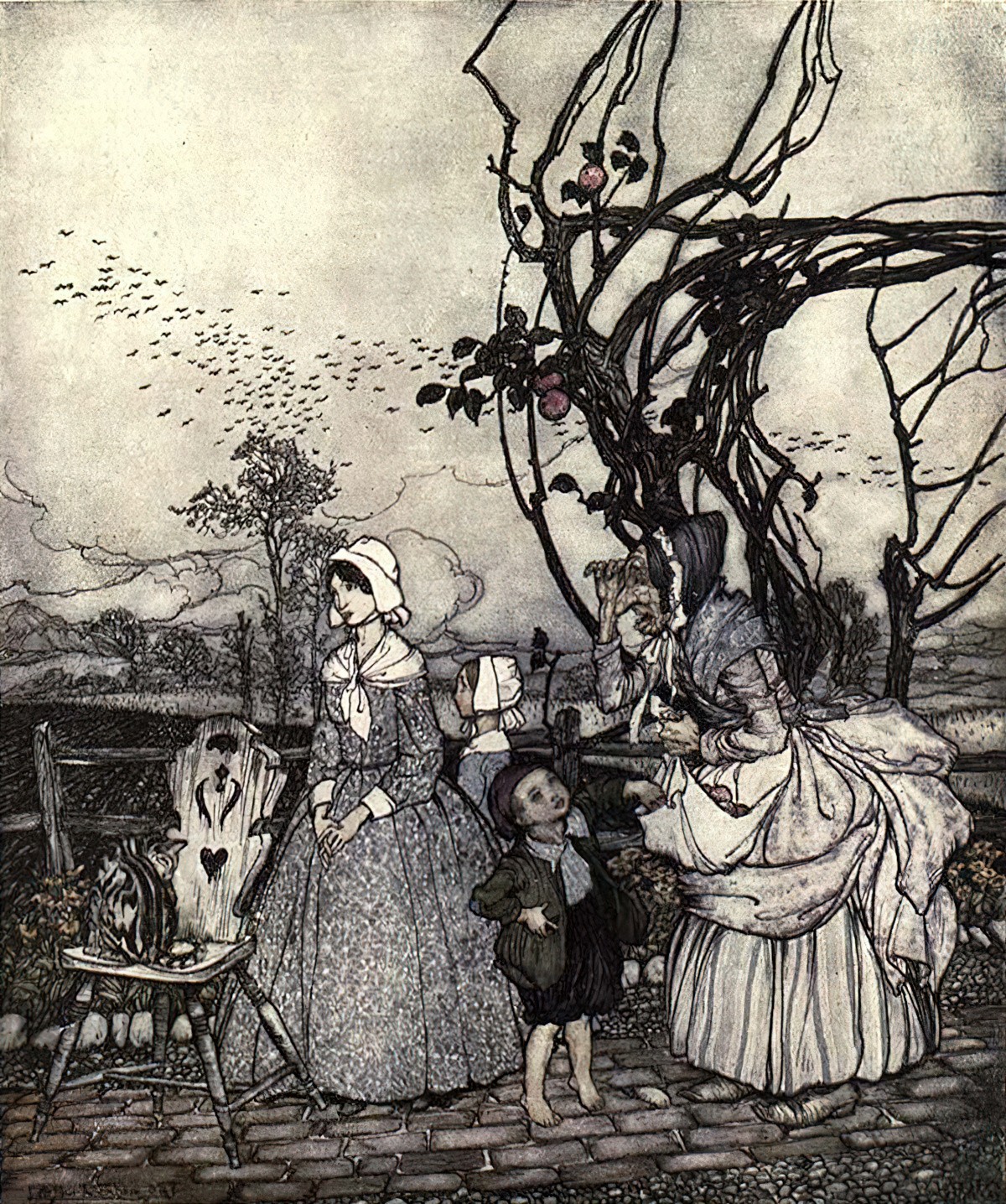
At the foot of these fairy mountains, the voyager may have descried the light smoke curling up from a village, whose shingle-roofs gleam among the trees, just where the blue tints of the upland melt away into the fresh green of the nearer landscape. It is a little village, of great antiquity, having been founded by some of the Dutch colonists in the early times of the province, just about the beginning of the government of the good Peter Stuyvesant (may he rest in peace!), and there were some of the houses of the original settlers standing within a few years, built of small yellow bricks brought from Holland, having latticed windows and gable fronts, surmounted with weathercocks.
Descry: Catch sight of (literary).
Surmount: stand or be placed on top of
This province is its own closed society. The reader needs to be convinced that interesting, closed societies different from their own are dotted around the countryside. This primes readers to also accept that magical closed societies exist in the mountains.
I only know the name Stuyvesant because of the cigarettes. Peter Stuyvesant, born in the late 1500s was a middle ages dictator, and last Dutch Director-General of the Colony of New Netherland. It was then ceded to the British. He was badly wounded in 1644 after leading an attack on the Portuguese island of Saint Martin. After that he got about on a wooden leg. He died in 1672. The narrator of this story clearly remembers the guy as a goodie.
What’s with mention of Peter Stuyvesant anyway? What’s he got to do with Rip? Well, in the 1700s, Stuyvesant was considered a hero. He even lost a leg! Sure, he was a bastard, but his adventures made for decent epic storytelling. Irving means us to compare the non-adventure of Rip Van Winkle to the genuinely interesting real life character of Peter Stuyvesant. The life of Stuyvesant was epic; the story of Rip Van Winkle is ‘mock epic’.
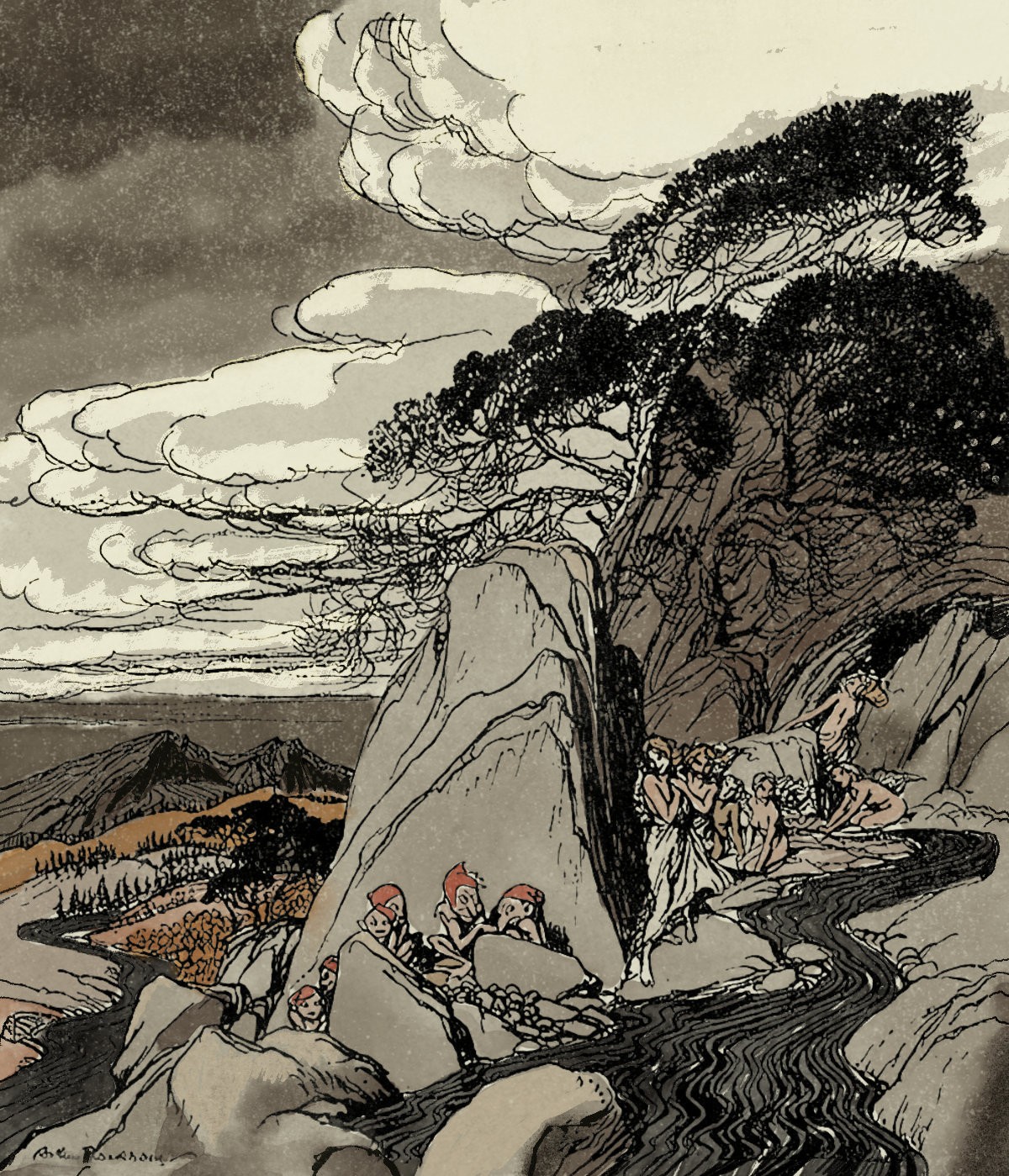
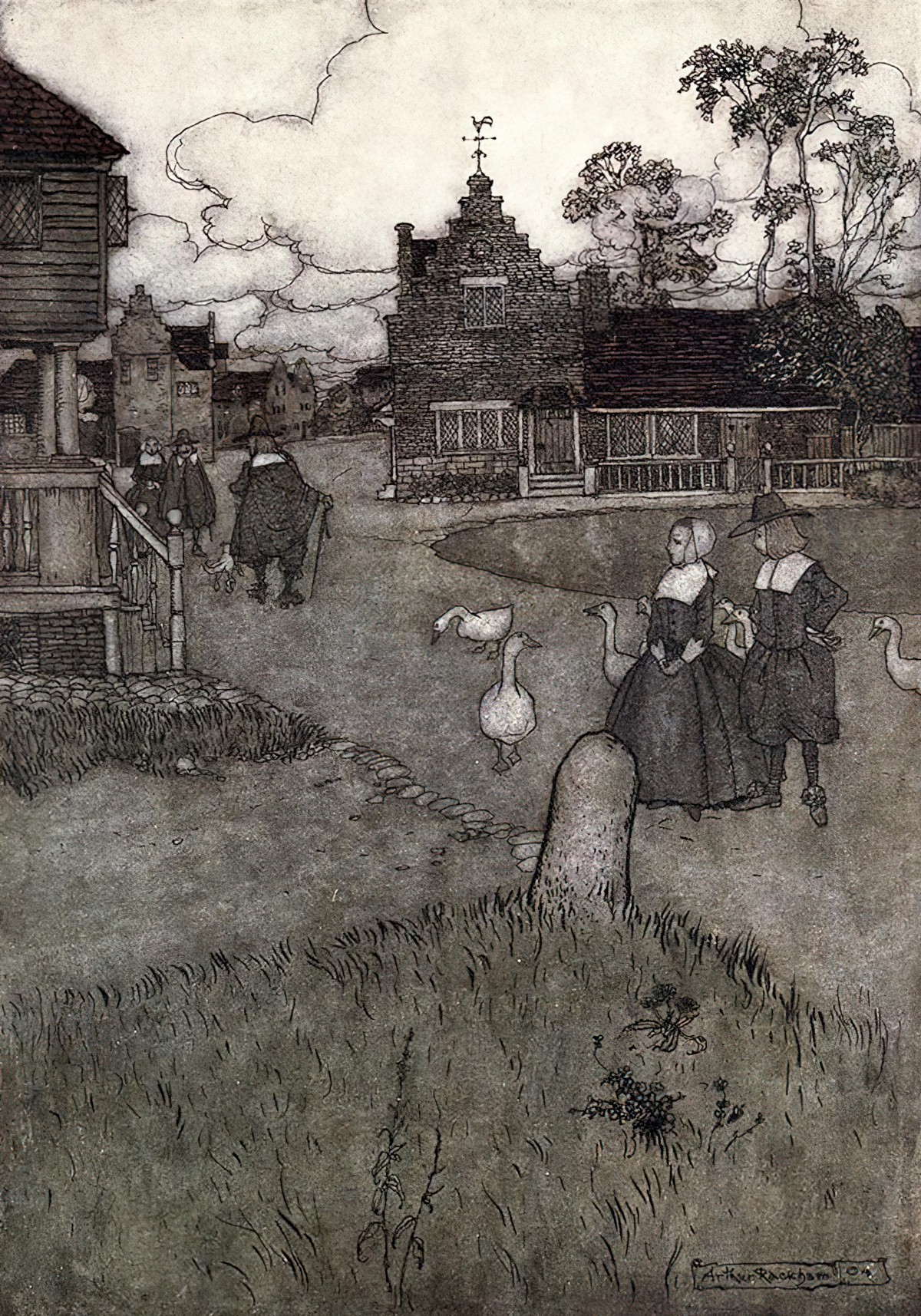
In that same village and in one of these very houses (which, to tell the precise truth, was sadly time-worn and weather-beaten), there lived, many years since, while the country was yet a province of Great Britain, a simple, good-natured fellow, of the name of Rip Van Winkle. He was a descendant of the Van Winkles who figured so gallantly in the chivalrous days of Peter Stuyvesant, and accompanied him to the siege of Fort Christina. He inherited, however, but little of the martial character of his ancestors. I have observed that he was a simple, good-natured man; he was, moreover, a kind neighbour, and an obedient, hen-pecked husband. Indeed, to the latter circumstance might be owing that meekness of spirit which gained him such universal popularity; for those men are apt to be obsequious and conciliating abroad, who are under the discipline of shrews at home. Their tempers, doubtless, are rendered pliant and malleable in the fiery furnace of domestic tribulation; and a curtain-lecture is worth all the sermons in the world for teaching the virtues of patience and long-suffering. A termagant wife may, therefore, in some respects, be considered a tolerable blessing; and if so, Rip Van Winkle was thrice blessed.
Folk and fairytale is full of ‘simple’ men. Simple Simon is a classic example. Oftentimes, though, through sheer dumb luck the simple men come up trumps.
This is the second time Peter Stuyvesant is mentioned. A cherished historical figure of the time.
Note that although Rip ‘bucks the trend’ of his ancestors, as important fighters, Rip’s own son will turn out exactly like himself. Washington Irving wrote in an era when many people believed in the goodness and badness of ‘blood’, though in this mindset, there are always exceptions to good begetting good. These exceptions ‘prove the rule’ by standing out as noteworthy.
Note how much telling comes from the narrator. Readers are not left to interpret the story for ourselves. No, we are not trusted to do so. Instead we are told with authority, before the story properly begins, that Rip is ‘good-natured’ and his wife is someone who ‘hen-pecks’.
Worse, the narrator makes a universal statement about sissy husbands who are weak because of the women in their lives. Men are punished for appearing weak; women are punished for causing men’s weakness. If it’s not the fault of the mother, it’s the wife. That’s how misogyny works. The paragraph ends with another universal statement which at first glance seems to balance all that has come before. ‘In some respects’ a ‘termagant’ wife is ‘a blessing’. When the narrator calls Rip Van Winkle ‘thrice blessed’ he is clearly being facetious. However, this facetiousness does nothing to subvert misogynist worldviews and nothing to cancel out the notion that the proper power balance in a marriage is one in which the husband controls and dominates his wife, not the other way around.
By the way, ‘termagant’ is a gendered word (or was, when it was more commonly used) and means a harsh-tempered or overbearing woman. It comes from an imaginary deity of violent and turbulent character, often appearing in morality plays. Morality plays were a type of allegorical drama popular during the 15th and 16th centuries. Characters personified moral qualities (such as charity or vice) or abstractions (as death or youth). These plays taught audiences a moral lesson.
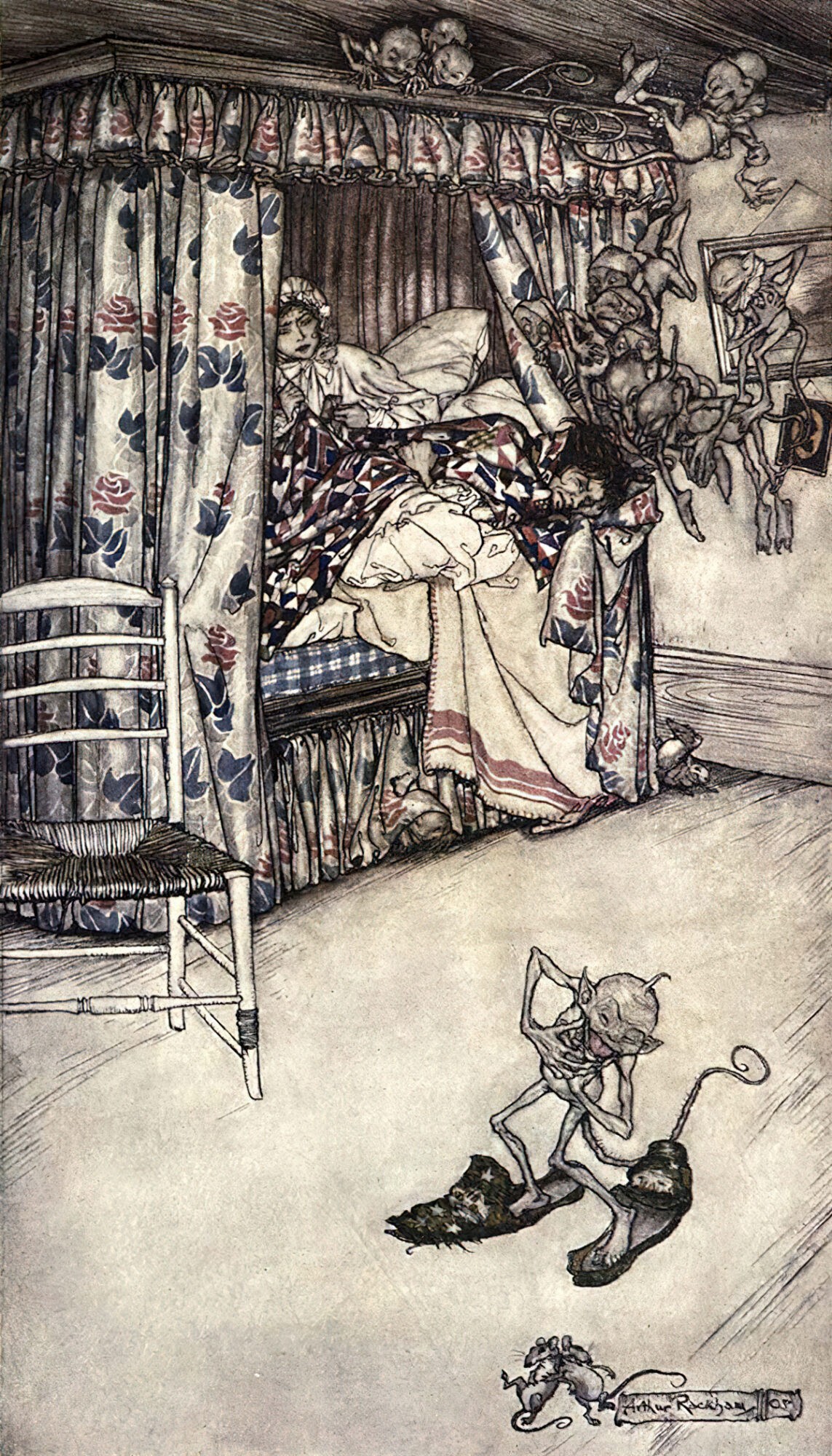
However, there’s another interpretation. These little demons look different from the ones in the wood. These are the wife’s words personified. When one of the wife’s demons steps into the husband’s slippers, by talking she usurping her husband’s ‘natural’ position as head of household.
As for those two mice in the foreground, they doubtless have their own story, running in parallel to that of Rip. This helps to bowdlerise what is really, in my opinion, a story for adults. See it in the picture books of Richard Scarry and Mercer Meyer, among many others. The device of two parallel stories, either supported or unsupported by words, goes by various names: Syllepsis, parallelism, or else we might utilise the language of poetic devices and call it a type of zeugma.
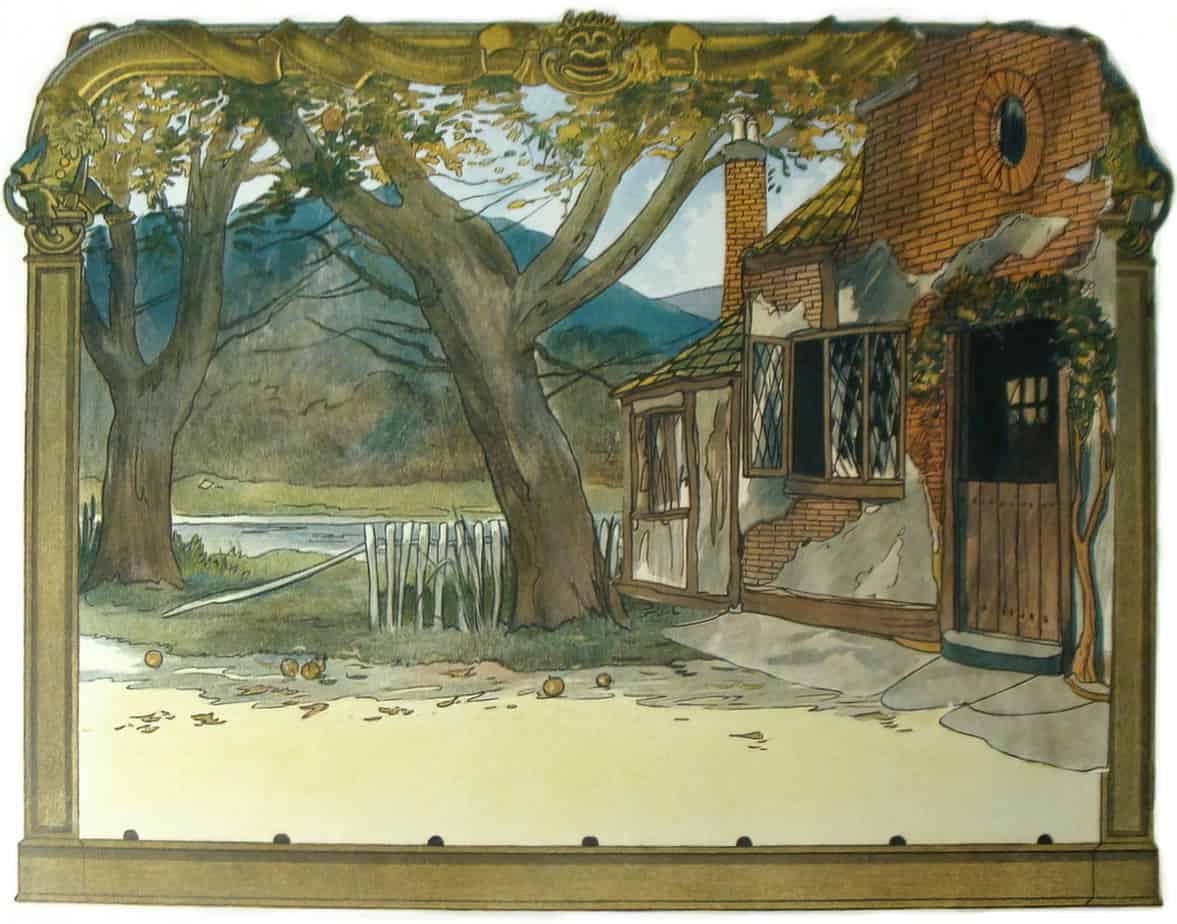
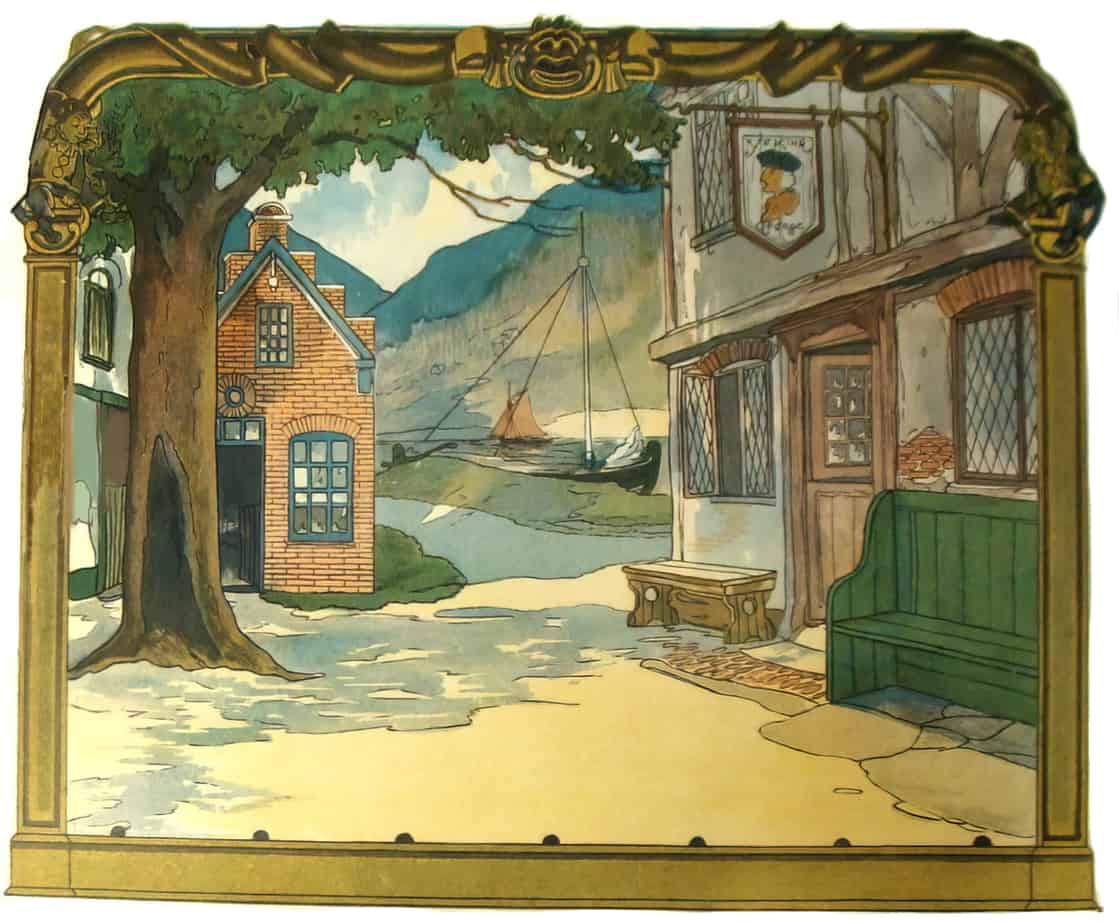
Certain it is that he was a great favourite among all the good wives of the village, who, as usual with the amiable sex, took his part in all family squabbles; and never failed, whenever they talked those matters over in their evening gossipings, to lay all the blame on Dame Van Winkle. The children of the village, too, would shout with joy whenever he approached. He assisted at their sports, made their playthings, taught them to fly kites and shoot marbles, and told them long stories of ghosts, witches, and Indians. Whenever he went dodging about the village, he was surrounded by a troop of them, hanging on his skirts, clambering on his back, and playing a thousand tricks on him with impunity; and not a dog would bark at him throughout the neighbourhood.
Once again, the narrator seems to balance out the misogyny by declaring women ‘the amiable sex’. The narrator also describes the women as gossipers, accidentally hitting upon a truth about straight ciswomen: Without the security of true bodily and marital autonomy, women are harshest about other women. Lateral violence. That’s how bullying works. At the top of the social hierarchy as a man, Rip Van Winkle doesn’t have to do anything at all before women take his side.
Note that Rip spends time with other people’s children. His own children are not mentioned. Because of his position at the top of the hierarchy, although he is a childlike figure, who takes genuine pleasure in childish joys, this is parsed by other women as useful, because he is apparently keeping them safe. (Is he really? Why might a man be so interested in other people’s children but not his own?)
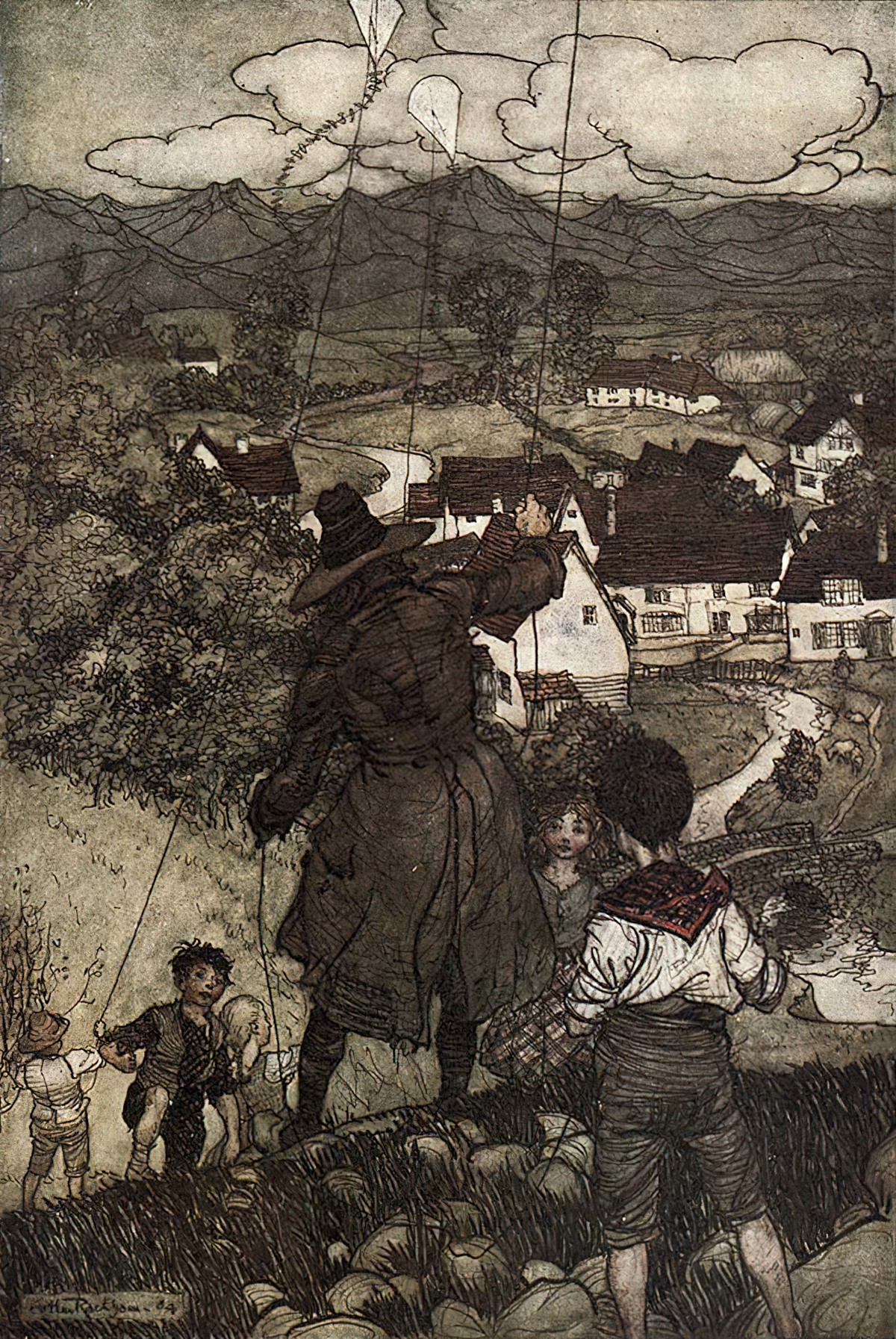
The great error in Rip’s composition was an insuperable aversion to all kinds of profitable labour. It could not be for want of assiduity or perseverance; for he would sit on a wet rock, with a rod as long and heavy as a Tartar’s lance, and fish all day without a murmur, even though he should not be encouraged by a single nibble. He would carry a fowling-piece on his shoulder for hours together, trudging through woods and swamps, and up hill and down dale, to shoot a few squirrels or wild pigeons. He would never refuse to assist a neighbour even in the roughest toil, and was a foremost man in all country frolics for husking Indian corn, or building stone fences; the women of the village, too, used to employ him to run their errands, and to do such little odd jobs as their less obliging husbands would not do for them. In a word, Rip was ready to attend to anybody’s business but his own; but as to doing family duty, and keeping his farm in order, he found it impossible.
At this point, consider what Dame Van Winkle is doing while her husband sits doing literally nothing. At this point in history, keeping house was literally a dawn to dusk job in its own right. Food was grown from scratch, there were cows to be milked, butter to be churned. Nothing simply switched on and off — tending the stove was a part-time job in its own right. This is why jobs became so gendered in the first place — men were required to leave the house and bring in resources because the women literally could not do it. (Women of child-bearing age were permanently pregnant or breastfeeding as well, a tiring thing in itself.)
This meant that Dame Van Winkle had two full time jobs of her own. She would have been exhausted. Can you imagine then, what it felt like to see your husband, the man who promised in his vows to ‘cherish’ you, not only cast you aside, but to help other women instead?
The narrator encourages us to censure him, sure, but the narrator is also centring the male experience. We are not shown what Dame Van Winkle is up to, when this was perfectly doable in omniscient third person narration.
In fact, he declared it was of no use to work on his farm; it was the most pestilent little piece of ground in the whole country; everything about it went wrong, in spite of him. His fences were continually falling to pieces; his cow would either go astray, or get among the cabbages; weeds were sure to grow quicker in his fields than anywhere else; the rain always made a point of setting in just as he had some outdoor work to do; so that though his patrimonial estate had dwindled away under his management, acre by acre, until there was little more left than a mere patch of Indian corn and potatoes, yet it was the worst-conditioned farm in the neighbourhood.
Whose fault is it that the cow goes astray? The man who doesn’t fix his own fences. The narration encourages us to poke fun at him for blaming everything on fate. Surely the entire village understood the state of the Van Winkles’ estate. Yet not one of the women or men rally around Dame Van Winkle. Not one of them tell Rip to go home and tend to his own family rather than help out with theirs. Basically, Rip was grooming the entire village to set against his wife. (What else was he grooming them for?)
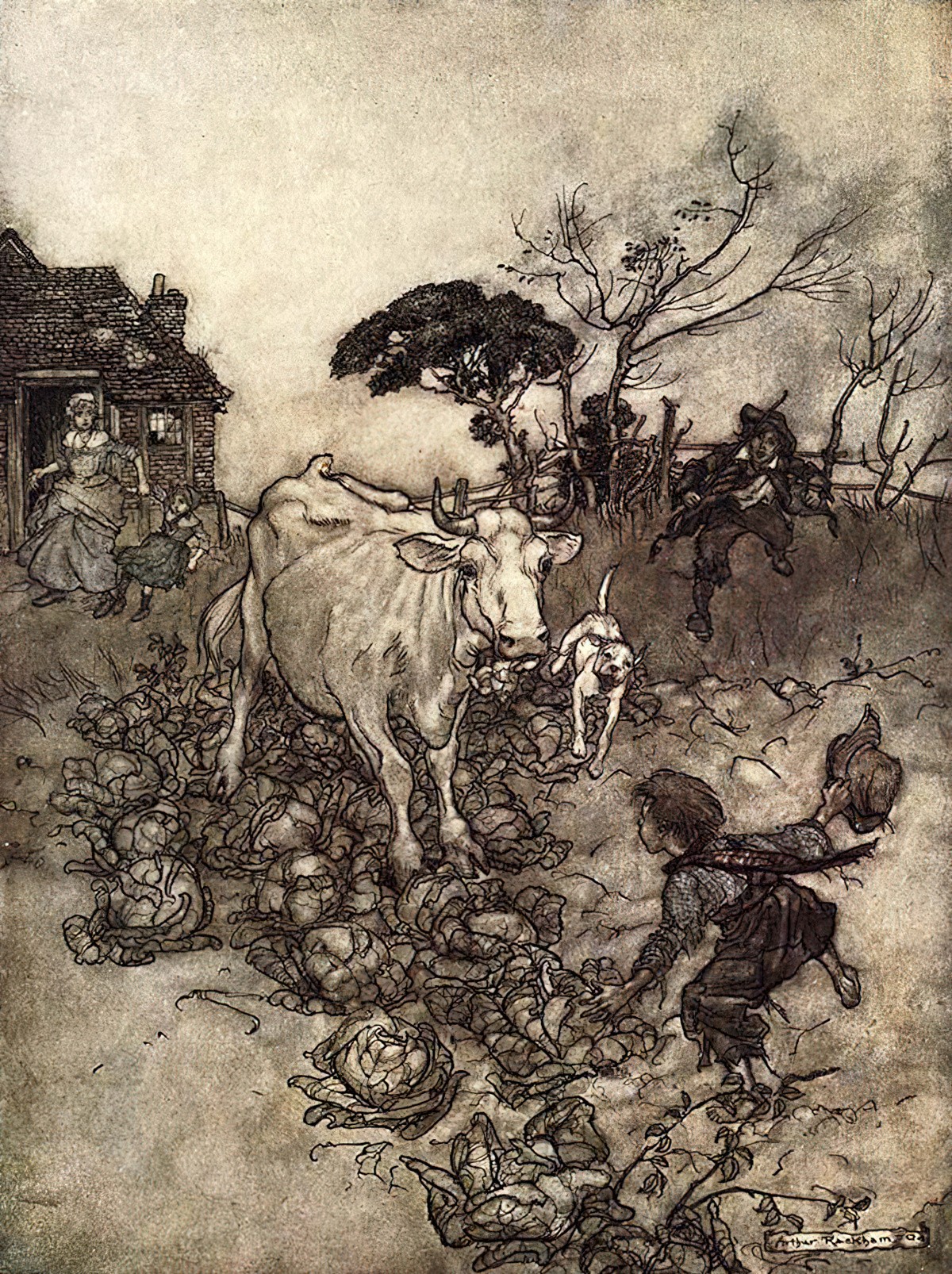
His children, too, were as ragged and wild as if they belonged to nobody. His son Rip, an urchin begotten in his own likeness, promised to inherit the habits, with the old clothes, of his father. He was generally seen trooping like a colt at his mother’s heels, equipped in a pair of his father’s cast-off galligaskins, which he had much ado to hold up with one hand, as a fine lady does her train in bad weather.
Here we have firm evidence that Rip Van Winkle had nothing to do with his own children. Until now, we may have charitably assumed his own children were out flying kites and what have you. But nope. He neglects his own son.
Galligaskins: breeches, trousers, or gaiters (Archaic, English)
Notice how the narration is encouraging us toward the conclusion that when boys spend too much time around their mothers they turn into sissies. Once again, if the boy fails to mature into a man, this will blamed on the mother. Also the father, of course, for not being around. But also the mother, who is doing her damn best, and takes no part of the blame for that. (Also: There’s no such thing as a ‘sissy boy’ It’s an entirely bullshit concept.)
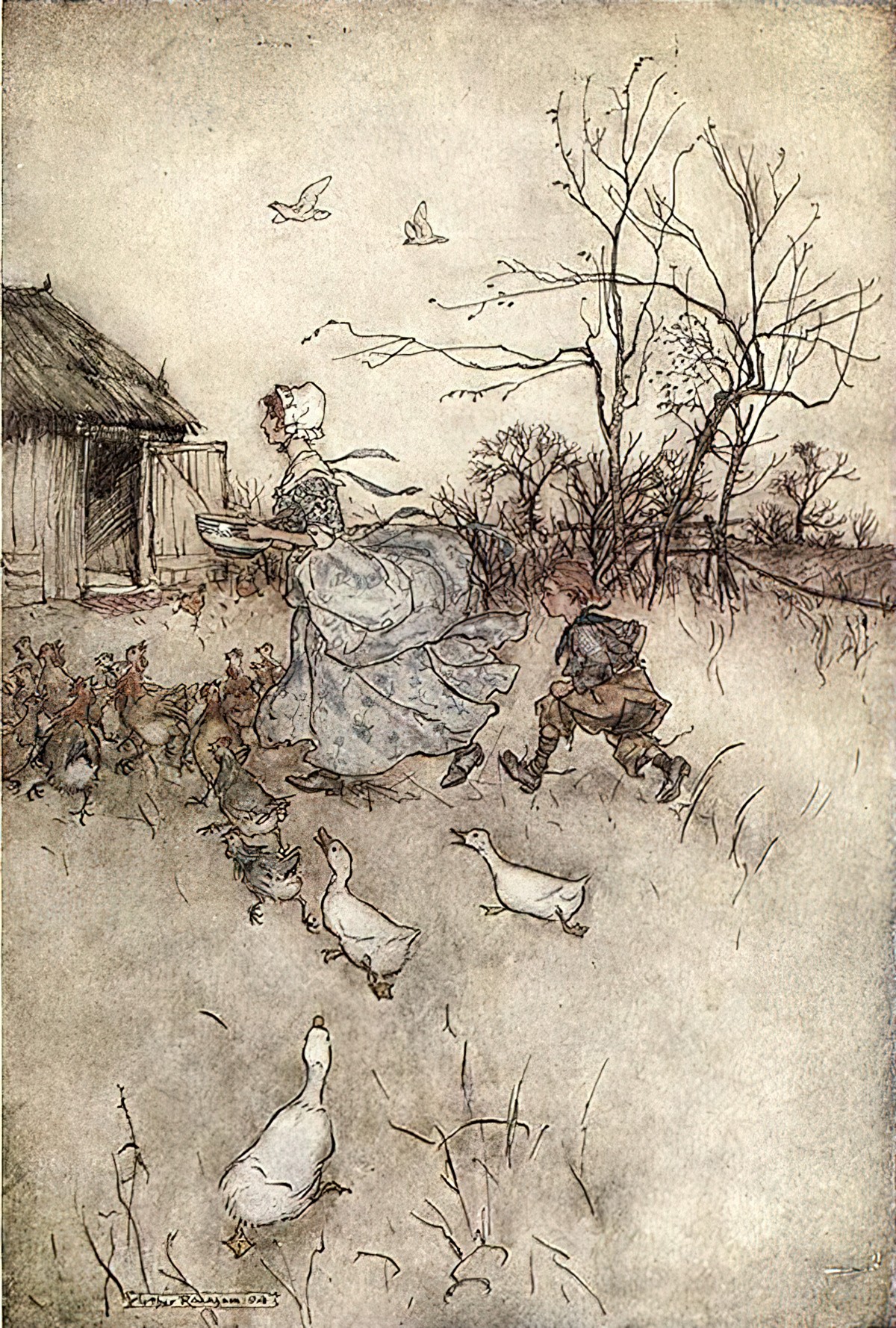
Rip Van Winkle, however, was one of those happy mortals, of foolish, well-oiled dispositions, who take the world easy, eat white bread or brown, whichever can be got with least thought or trouble, and would rather starve on a penny than work for a pound. If left to himself, he would have whistled life away in perfect contentment; but his wife kept continually dinning in his ears about his idleness, his carelessness, and the ruin he was bringing on his family. Morning, noon, and night, her tongue was incessantly going, and everything he said or did was sure to produce a torrent of household eloquence. Rip had but one way of replying to all lectures of the kind, and that, by frequent use, had grown into a habit. He shrugged his shoulders, shook his head, cast up his eyes, but said nothing. This, however, always provoked a fresh volley from his wife; so that he was fain to draw off his forces, and take to the outside of the house—the only side which, in truth, belongs to a hen-pecked husband.
What does ‘well-oiled’ mean? Liquored up. I don’t believe the narrator when he says he’d be happy to go without. Sure, he doesn’t care about the colour of his bread, but what would’ve happened had someone removed Rip Van Winkle’s liquor from his grasp? Alcoholics can appear to care about little, until the object of their addiction is taken away. This doesn’t make them ‘easy-going’.
If Rip’s drinking habits are left off the page, that’s because to describe it would be like saying the guy drinks water. In 1770, the average colonial Americans consumed about three and a half gallons of alcohol per year, about double the modern rate.
Rip Van Winkle simply shrugged at his wife because he was too sozzled to do anything else.
For many reasons, the term ‘hen pecked husband’ needs to get in the bin. But there’s also this: Hens peck other hens, not the rooster. Roosters are at the top of the poultry hierarchy, and will keep the hens under his control. ‘Hen pecked husband’ isn’t even working with something that occurs frequently in nature. ‘Hen pecked sister’ would work.
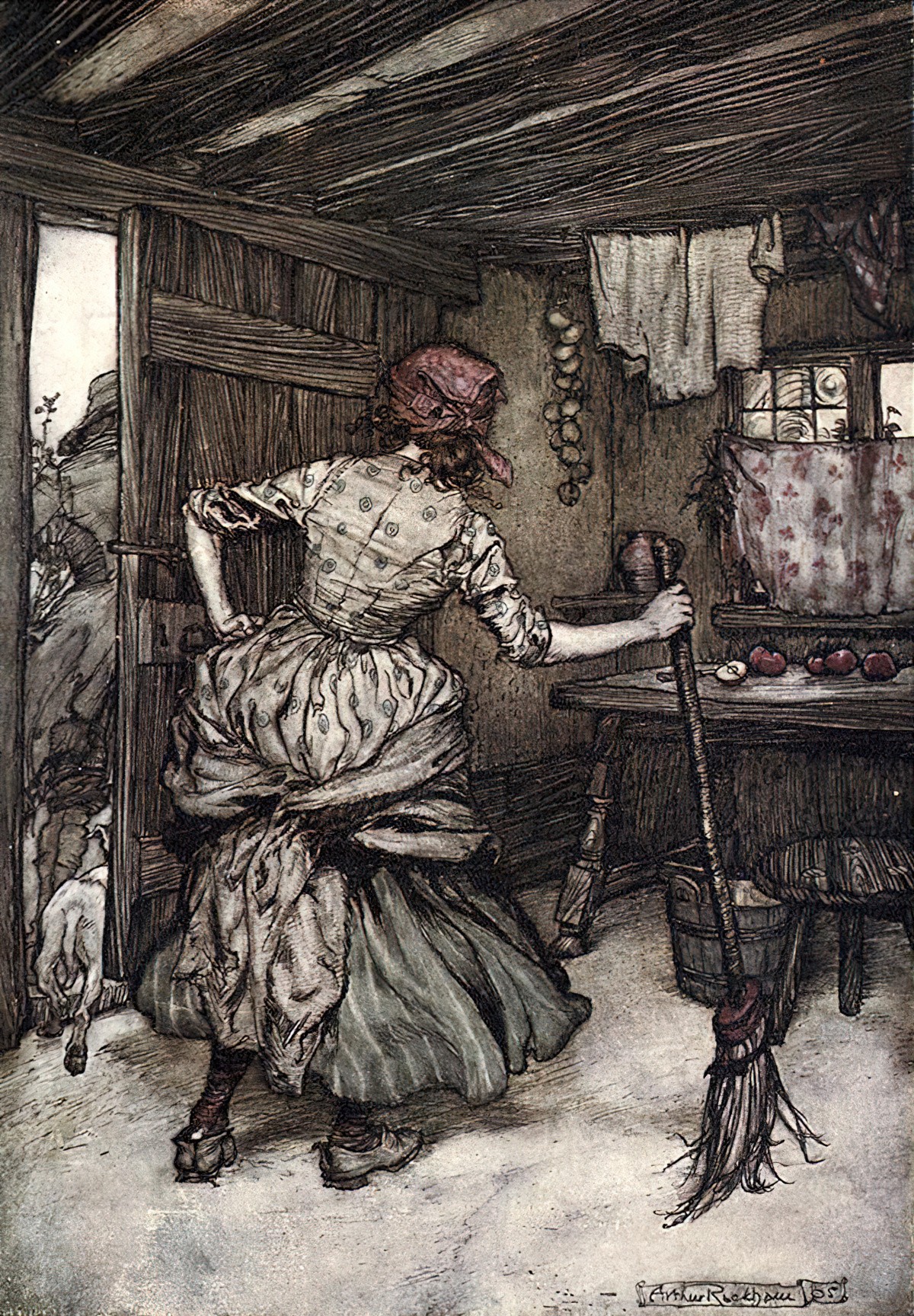
Rip’s sole domestic adherent was his dog Wolf, who was as much hen-pecked as his master; for Dame Van Winkle regarded them as companions in idleness, and even looked upon Wolf with an evil eye, as the cause of his master’s going so often astray. True it is, in all points of spirit befitting an honourable dog, he was as courageous an animal as ever scoured the woods—but what courage can withstand the evil-doing and all-besetting terrors of a woman’s tongue? The moment Wolf entered the house his chest fell, his tail drooped to the ground or curled between his legs, he sneaked about with a gallows air, casting many a sidelong glance at Dame Van Winkle, and at the least flourish of a broomstick or ladle he would fly to the door with yelping precipitation.
So Dam Van Winkle doesn’t even like dogs. This author is pulling everything out of his toolkit to make us hate her. The phrase ‘evil eye’ paints the Dame as a witch, though it’s probably not meant to be taken literally. Note, too, the use of ‘evil-doing’. It would seem the Dame is able to speak to animals directly (because she herself can transmogrify, perhaps). Finally, in case we miss all this witch analogy, there’s mention of the broomstick.
This is literally the sort of thinking which led to the Witch Craze. People continue to be killed for witchcraft. The ‘craze’ — prejudice and hate — will never die, so we should be careful about the casual use of the language around witchcraft, even today.
Times grew worse and worse with Rip Van Winkle as years of matrimony rolled on; a tart temper never mellows with age, and a sharp tongue is the only edged tool that grows keener with constant use. For a long while he used to console himself, when driven from home, by frequenting a kind of perpetual club of the sages, philosophers and other idle personages of the village, which held its sessions on a bench before a small inn, designated by a rubicund portrait of His Majesty George the Third. Here they used to sit in the shade through a long, lazy summer’s day, talking listlessly over village gossip, or telling endless, sleepy stories about nothing. But it would have been worth any statesman’s money to have heard the profound discussions that sometimes took place, when by chance an old newspaper fell into their hands from some passing traveller. How solemnly they would listen to the contents, as drawled out by Derrick Van Bummel, the schoolmaster, a dapper, learned little man, who was not to be daunted by the most gigantic word in the dictionary; and how sagely they would deliberate upon public events some months after they had taken place.
There’s a specific kind of rage which builds up when your spouse keeps doing something which annoys you, over many, many years. It might be as simple as never picking up a wet towel, or failing to throw out an empty container after using the last of something. These small acts of disregard signal something much larger than the ‘trifling’ acts which they seem when described to an outsider (such as us): They signal to a spouse that the spouse is unimportant. And remember, Dame Van Winkle should be so lucky, to have a man who leaves wet towels on the floor. This guy is actively abusive in his disregard for his family.
Notice again, that although they all sit outside a pub, intoxication is still not part of the story, which it very clearly is.
In illustrations of this scene, note that Arthur Rackham understood the men would be drinking, whereas N.C. Wyeth has depicted a few jugs, but none of the men holds a goblet.
Let us consider what the women are doing right now. They will be preparing family dinners and making sure children don’t kill themselves. There was no time in a woman’s day to sit around and deliberate upon public events.
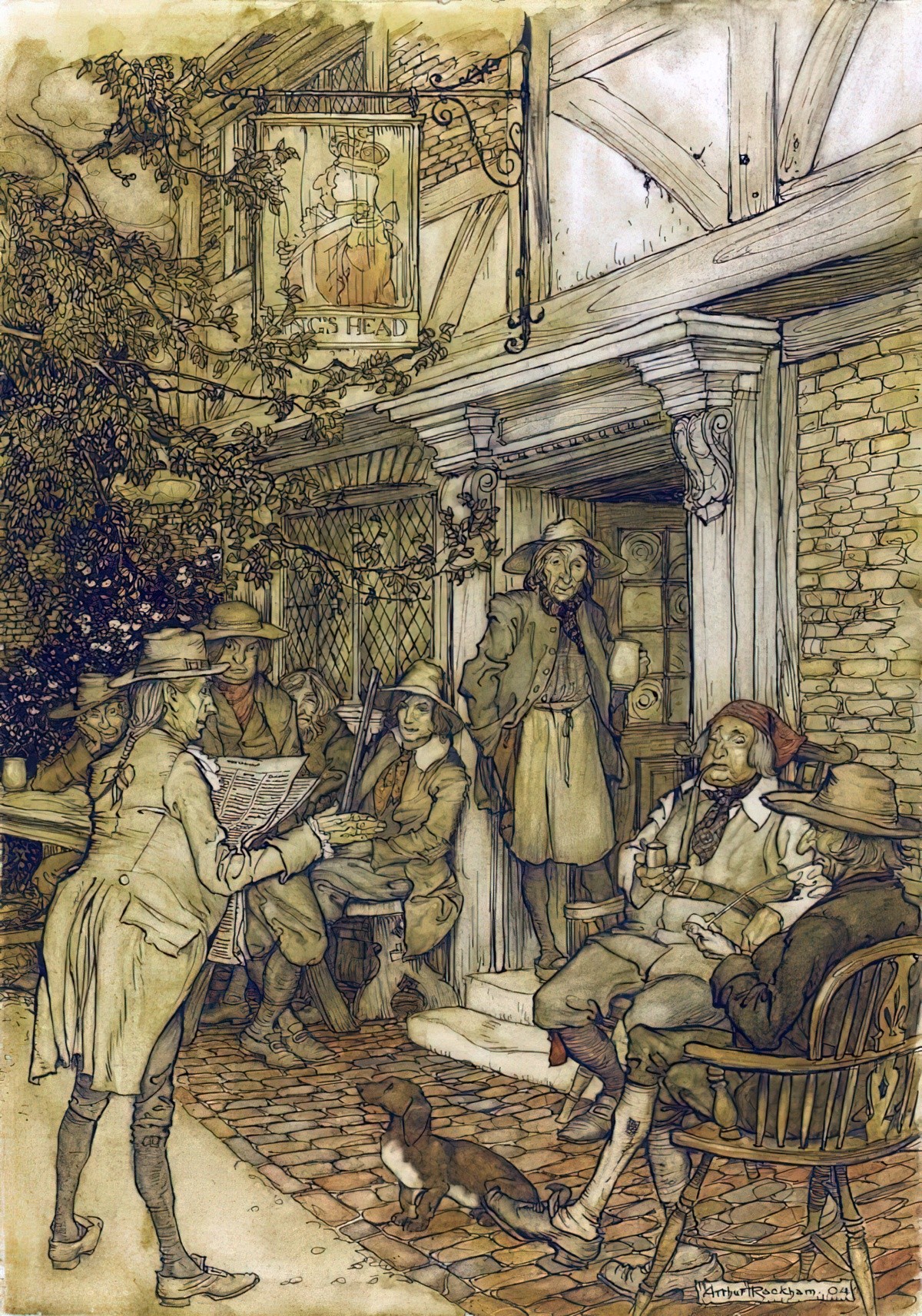
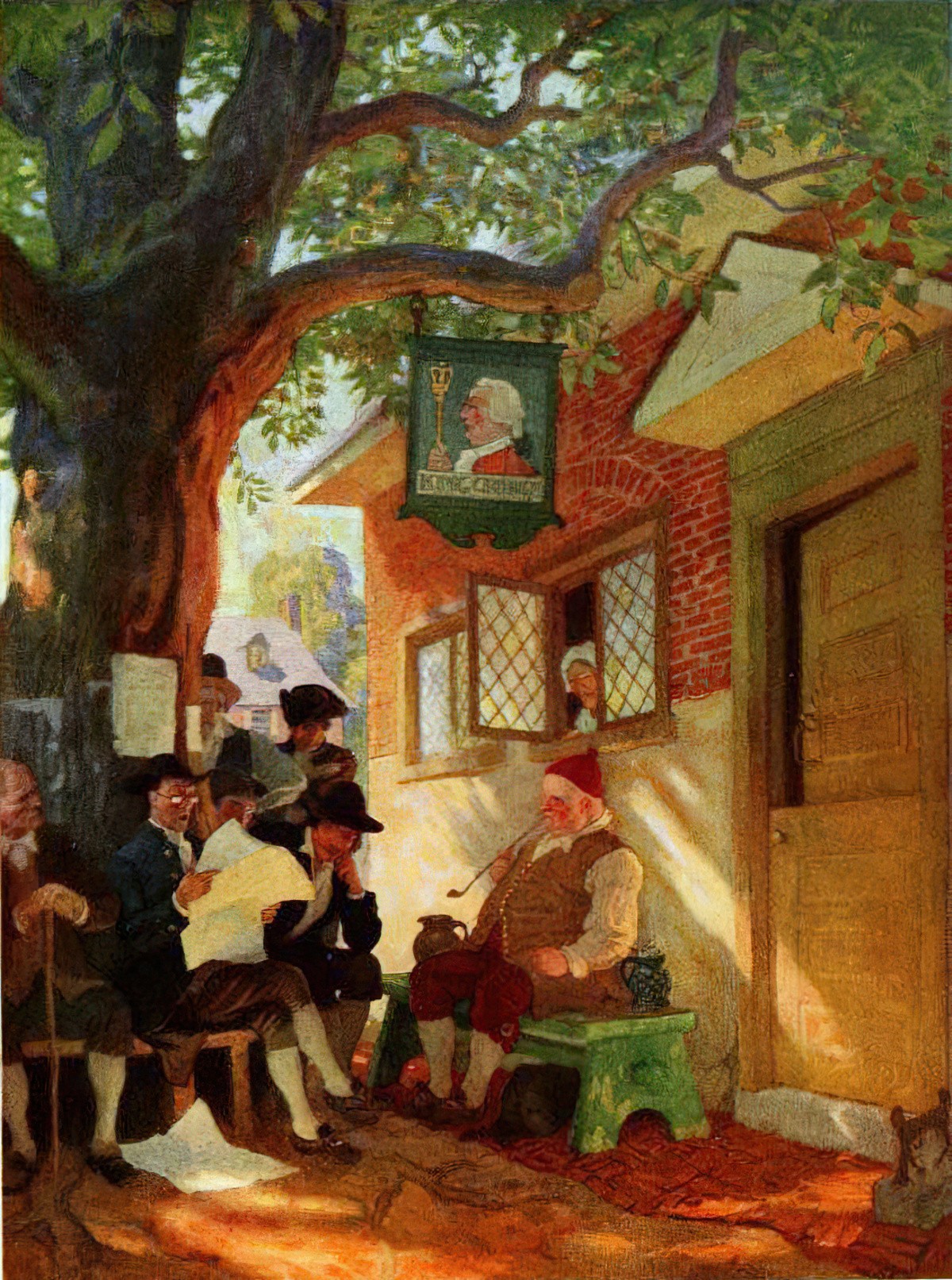
The opinions of this junto were completely controlled by Nicholas Vedder, a patriarch of the village, and landlord of the inn, at the door of which he took his seat from morning till night, just moving sufficiently to avoid the sun and keep in the shade of a large tree; so that the neighbours could tell the hour by his movements as accurately as by a sun-dial. It is true he was rarely heard to speak, but smoked his pipe incessantly. His adherents, however (for every great man has his adherents), perfectly understood him, and knew how to gather his opinions. When anything that was read or related displeased him, he was observed to smoke his pipe vehemently, and to send forth short, frequent, and angry puffs; but when pleased, he would inhale the smoke slowly and tranquilly, and emit it in light and placid clouds; and sometimes, taking the pipe from his mouth, and letting the fragrant vapour curl about his nose, would gravely nod his head in token of perfect approbation.
Junto: a political grouping or faction, especially in 17th- and 18th-century Britain.
Now let us take a moment to consider who was really running the inn, while ‘landlord of the inn’ was sitting outside smoking his pipe. N.C. Wyeth has included her in his illustration. She’s saying something to her husband through the window, and she doesn’t look happy with him, either. Wyeth obviously realised that Dame Van Winkle was not the only woman in the village lumped with a layabout husband. This was the culture of the village.
From even this stronghold the unlucky Rip was at length routed by his termagant wife, who would suddenly break in upon the tranquillity of the assemblage and call the members all to naught; nor was that august personage, Nicholas Vedder himself, sacred from the daring tongue of this terrible virago, who charged him outright with encouraging her husband in habits of idleness.
Dame Van Winkle is apparently the only woman who is brave enough, or angry enough, to say anything about this inequality, which is so very clear to her, but perhaps invisible to many of the women, who have been brought up to expect little from husbands.
Poor Rip was at last reduced almost to despair; and his only alternative, to escape from the labour of the farm and clamour of his wife, was to take gun in hand and stroll away into the woods. Here he would sometimes seat himself at the foot of a tree, and share the contents of his wallet with Wolf, with whom he sympathised as a fellow-sufferer in persecution. “Poor Wolf,” he would say, “thy mistress leads thee a dog’s life of it; but never mind, my lad, whilst I live thou shalt never want a friend to stand by thee!” Wolf would wag his tail, look wistfully in his master’s face; and, if dogs can feel pity, I verily believe he reciprocated the sentiment with all his heart.
I remember getting into trouble as a preschooler and being sent to my room, where I would talk to my toys and request their solidarity. This is what grown-man Rip Van Winkle is doing with his dog.
In a long ramble of the kind on a fine autumnal day, Rip had unconsciously scrambled to one of the highest parts of the Kaatskill Mountains. He was after his favourite sport of squirrel shooting, and the still solitudes had echoed and re-echoed with the reports of his gun. Panting and fatigued, he threw himself, late in the afternoon, on a green knoll, covered with mountain herbage, that crowned the brow of a precipice. From an opening between the trees he could overlook all the lower country for many a mile of rich woodland. He saw at a distance the lordly Hudson, far, far below him, moving on its silent but majestic course, with the reflection of a purple cloud, or the sail of a lagging bark, here and there sleeping on its glassy bosom, and at last losing itself in the blue highlands.
This is where the story switches from iterative to singulative time. Note how many words it took to get here. It is very unusual for a modern story to switch after that much set-up. Contemporary readers would expect a few choice details about characterisation, then expect the narrator to get on with the story at hand.
The small hill, or the knoll, has long been associated with fairies in British folklore, so we might expect supernatural happenings once the knoll enters the story.
Again, the setting comes alive, with the Hudson River described as ‘Lordly’, because of course that’s how patriarch Rip Van Winkle would conceive of something so great and so powerful.
On the other side he looked down into a deep mountain glen, wild, lonely, and shagged, the bottom filled with fragments from the impending cliffs, and scarcely lighted by the reflected rays of the setting sun. For some time Rip lay musing on this scene; evening was gradually advancing; the mountains began to throw their long blue shadows over the valleys; he saw that it would be dark long before he could reach the village, and he heaved a heavy sigh when he thought of encountering the terrors of Dame Van Winkle.
Time works differently now, ostensibly because Rip has lost track of it. On the page, this is because he’s not concerned with work, and time is really only useful if you mean to get things done. I believe Rip is drunk, which is how he’s lost track of his afternoon.
As he was about to descend, he heard a voice from a distance, hallooing: “Rip Van Winkle! Rip Van Winkle!” He looked round, but could see nothing but a crow winging its solitary flight across the mountain. He thought his fancy must have deceived him, and turned again to descend, when he heard the same cry ring through the still evening air: “Rip Van Winkle! Rip Van Winkle!” At the same time Wolf bristled up his back, and giving a low growl, skulked to his master’s side, looking fearfully down into the glen. Rip now felt a vague apprehension stealing over him; he looked anxiously in the same direction, and perceived a strange figure slowly toiling up the rocks, and bending under the weight of something he carried on his back. He was surprised to see any human being in this lonely and unfrequented place; but supposing it to be some one of the neighbourhood in need of his assistance, he hastened down to yield it.
Yep. The crows are talking. He’s drunk, all right. When he sees a small person, his first thought is that the man needs his help. In fact it’s the other way around.
The ‘strange figure toiling up the rocks’ is straight out of folk tale. A traveller (hero, or antihero as Rip may be) goes on a journey to find himself and encounters some small fellow of the wood (wizard, hermit, shepherd, smith…) The function of this character: To offer advice.
Is it possible to offer advice without talking at all? I think so. You can offer advice to a drunkard by teaching him a lesson, I guess?
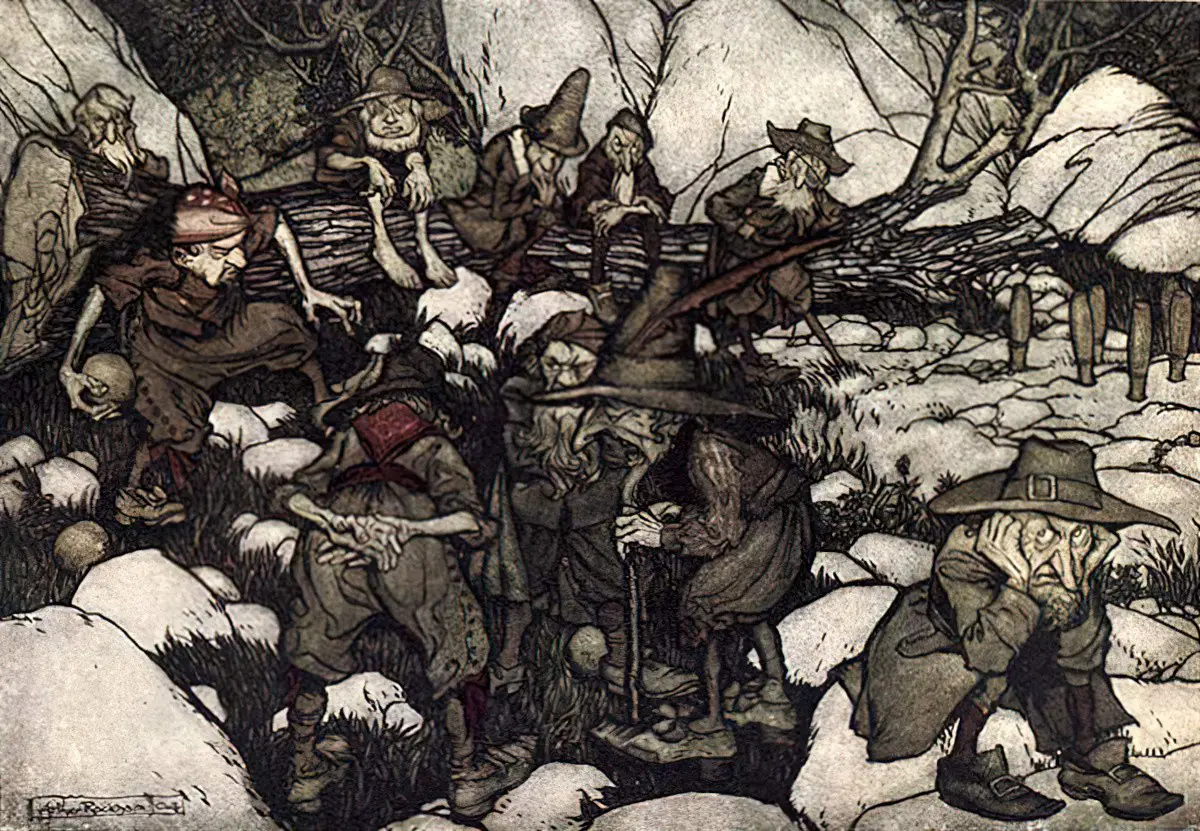
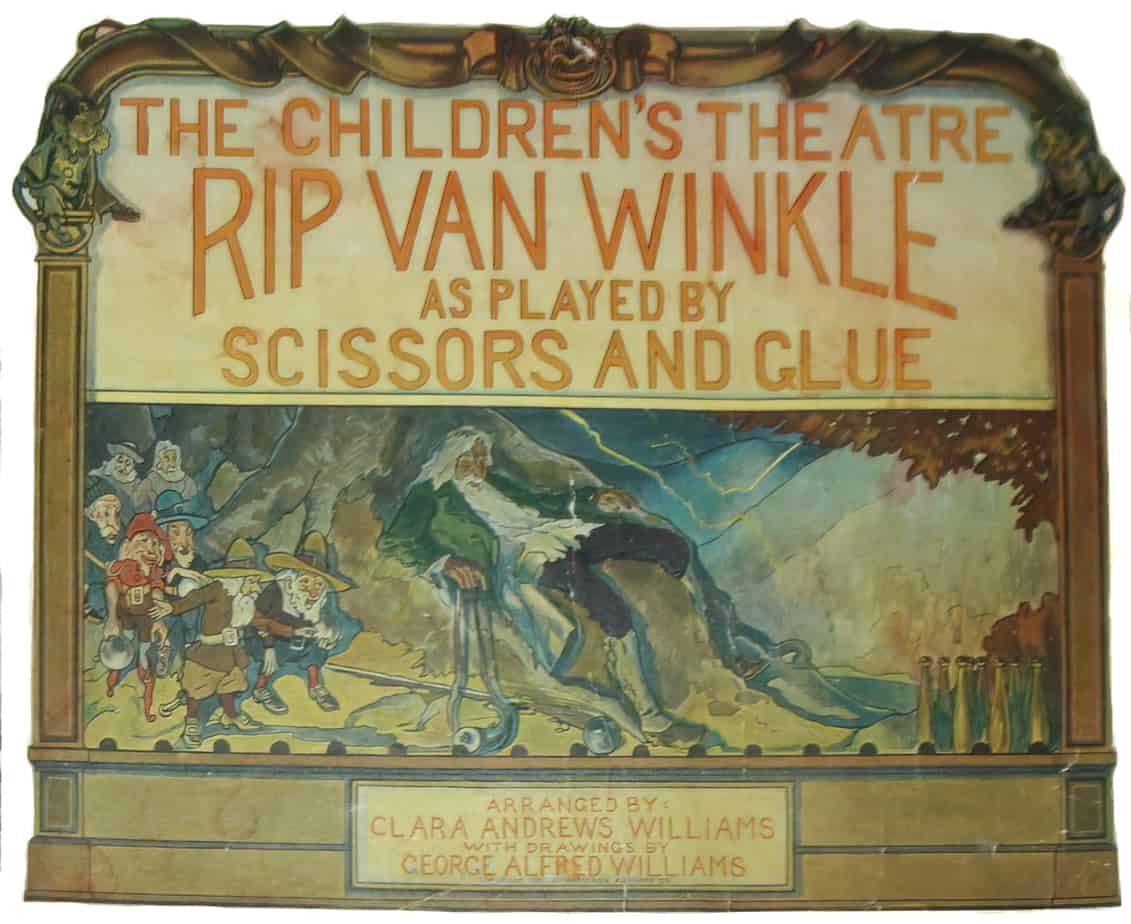
On nearer approach he was still more surprised at the singularity of the stranger’s appearance. He was a short, square-built old fellow, with thick bushy hair, and a grizzled beard. His dress was of the antique Dutch fashion: a cloth jerkin strapped round the waist—several pair of breeches, the outer one of ample volume, decorated with rows of buttons down the sides, and bunches at the knees. He bore on his shoulder a stout keg, that seemed full of liquor, and made signs for Rip to approach and assist him with the load. Though rather shy and distrustful of his new acquaintance, Rip complied with his usual alacrity; and mutually relieving one another, they clambered up a narrow gully, apparently the dry bed of a mountain torrent. As they ascended, Rip every now and then heard long, rolling peals, like distant thunder, that seemed to issue out of a deep ravine, or rather cleft, between lofty rocks, toward which their ragged path conducted. He paused for an instant, but supposing it to be the muttering of one of those transient thunder-showers which often take place in mountain heights, he proceeded. Passing through the ravine, they came to a hollow, like a small amphitheatre, surrounded by perpendicular precipices, over the brinks of which impending trees shot their branches, so that you only caught glimpses of the azure sky and the bright evening cloud. During the whole time Rip and his companion had laboured on in silence; for though the former marvelled greatly what could be the object of carrying a keg of liquor up this wild mountain, yet there was something strange and incomprehensible about the unknown, that inspired awe and checked familiarity.
These creatures are time travellers. (Even if not literally, they are from another time.)
The appearance of fairies. This is surely the part of the story which makes publishers think Rip Van Winkle is for children. Also the long slumber, reminiscent of Snow White. But before kids even get to the fairies, they must sit through an entire lengthy misogynistic rant. Not every fairy story is for children. Bowdlerisation is a thing, and regularly applied. But in my editions of Rip Van Winkle for children, the overt misogyny is left as is.
When Rip enters the deep ravine, he is crossing the fairy tale threshold to a different, magical realm. Joseph Campbell called this ‘the crossing of the first threshold.’ Rip can’t find this place again without his guide.
Usually in a fairy tale the hero is tested. He has to perform some tasks. These little fellows don’t ask much of Rip. They clearly know he’s useless. His only task: WAIT HERE.
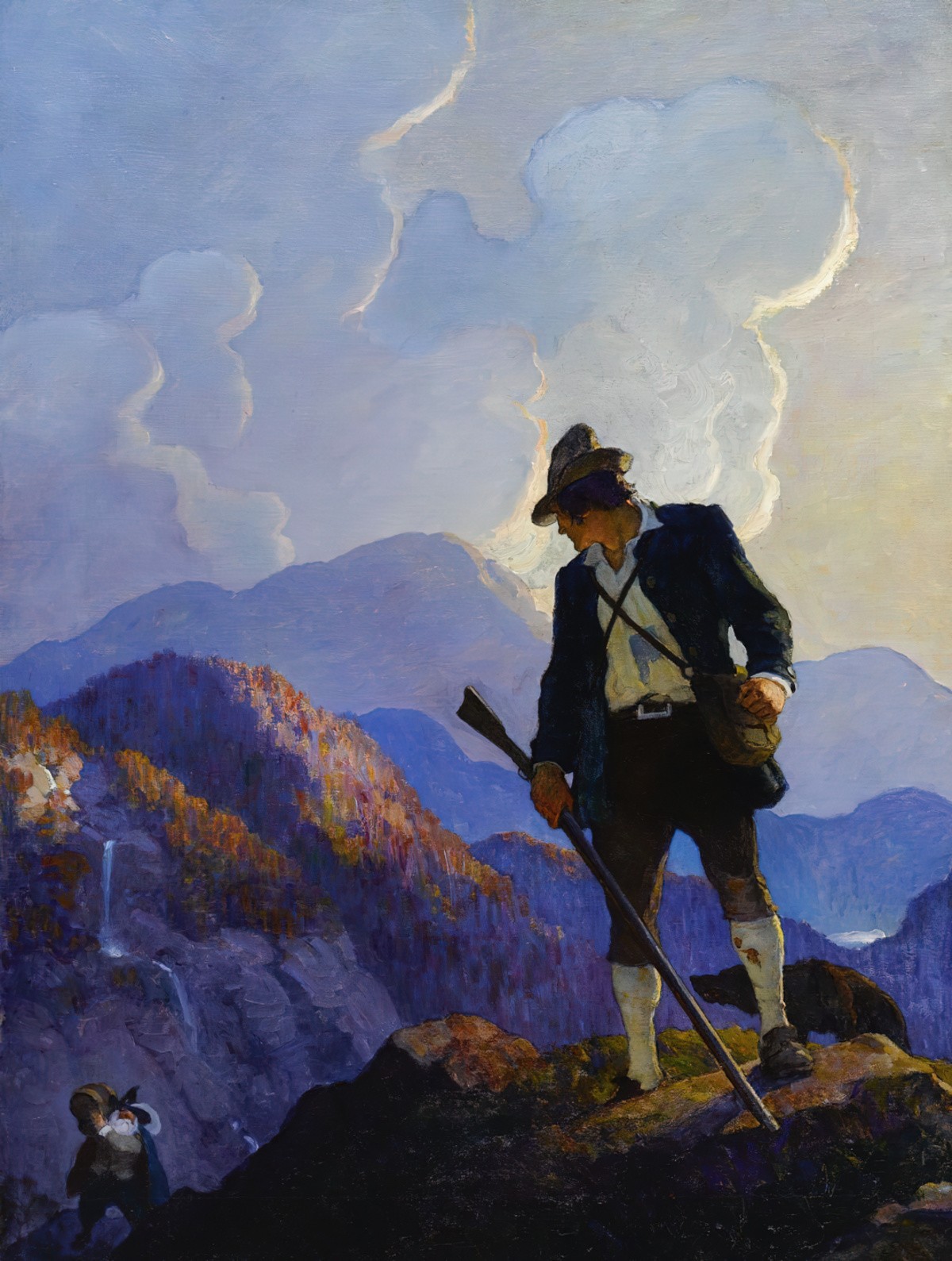
On entering the amphitheatre, new objects of wonder presented themselves. On a level spot in the centre was a company of odd-looking personages playing at ninepins. They were dressed in a quaint, outlandish fashion; some wore short doublets, others jerkins, with long knives in their belts, and most of them had enormous breeches, of similar style with that of the guide’s. Their visages, too, were peculiar; one had a large beard, broad face, and small piggish eyes; the face of another seemed to consist entirely of nose, and was surmounted by a white sugar-loaf hat, set off with a little red cock’s tail. They all had beards, of various shapes and colours. There was one who seemed to be the commander. He was a stout old gentleman, with a weather-beaten countenance; he wore a laced doublet, broad belt and hanger, high-crowned hat and feather, red stockings, and high-heeled shoes, with roses in them. The whole group reminded Rip of the figures in an old Flemish painting, in the parlour of Dominie Van Shaick, the village parson, and which had been brought over from Holland at the time of the settlement.
Ninepins: the traditional form of the game of skittles, using nine pins and played in an alley.
Doublet: a man’s short close-fitting padded jacket, commonly worn from the 14th to the 17th century.
Jerkin: a man’s close-fitting jacket, typically made of leather.
Breeches: short trousers fastened just below the knee, now chiefly worn for riding or as part of ceremonial dress.
Though the narrator has been overt until now, this must be information conveyed to others by Rip himself, so the narrator dips into Rip’s head until we have psycho narration. Rip’s mind is messing with scale, and a person appears as a foodstuff. This is a guy who is high.
The word ‘antebellum’ may come in useful when writing about Rip Van Winkle. It means ‘occurring or existing before a particular war, especially the US Civil War’. Post-bellum means ‘after’ it. “Rip Van Winkle” divides in half, and the sleeping portion marks the end of antebellum America.
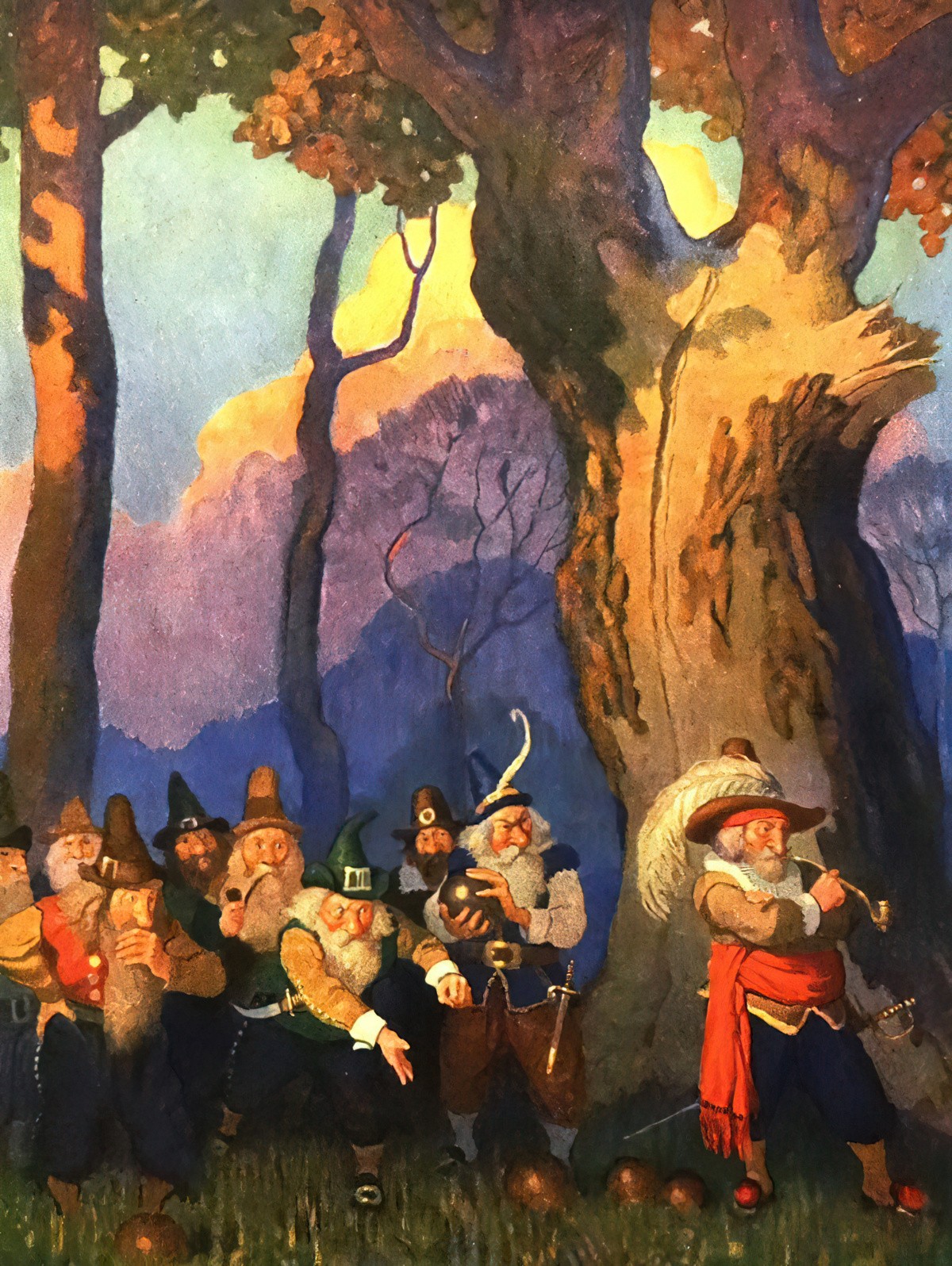
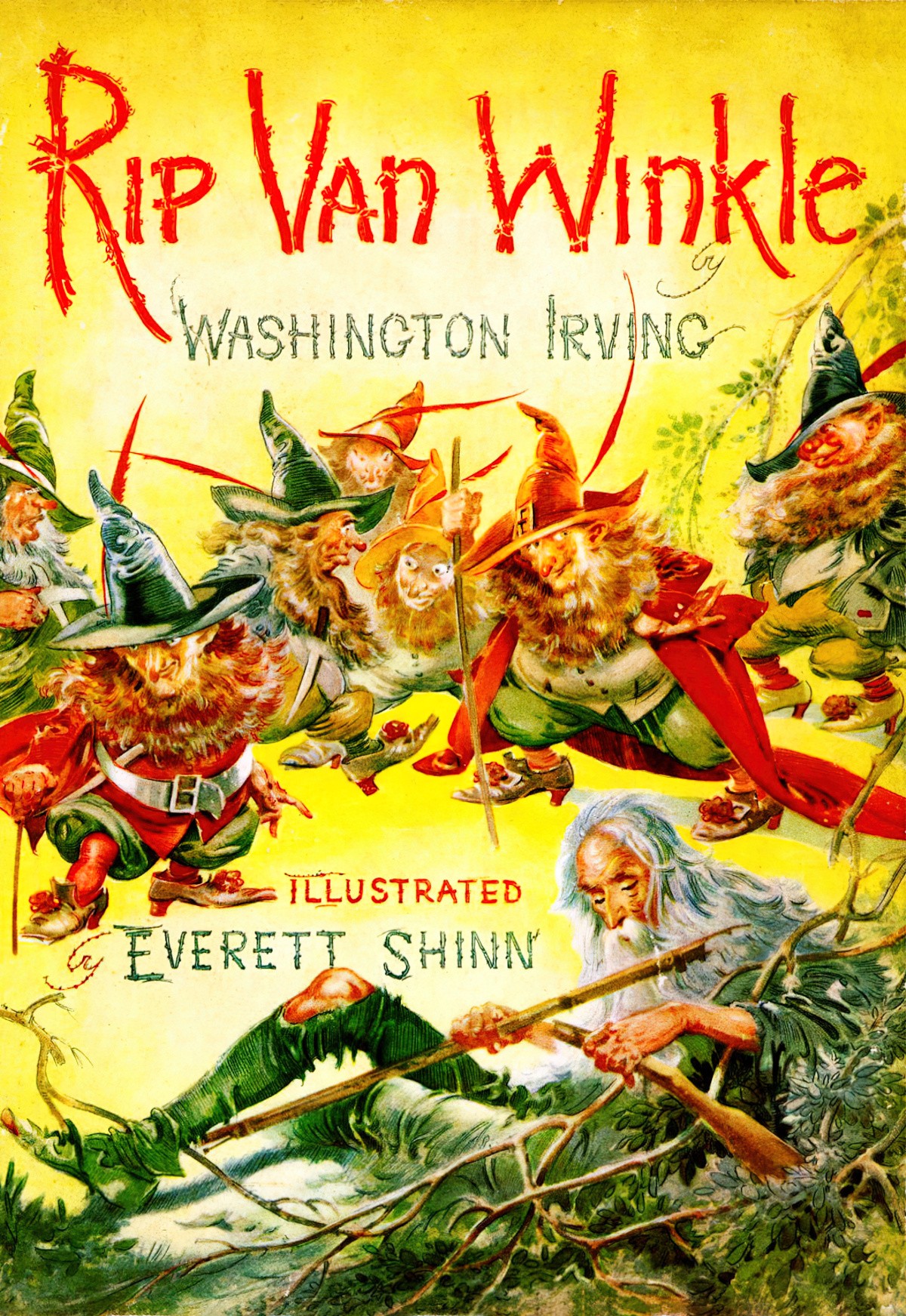
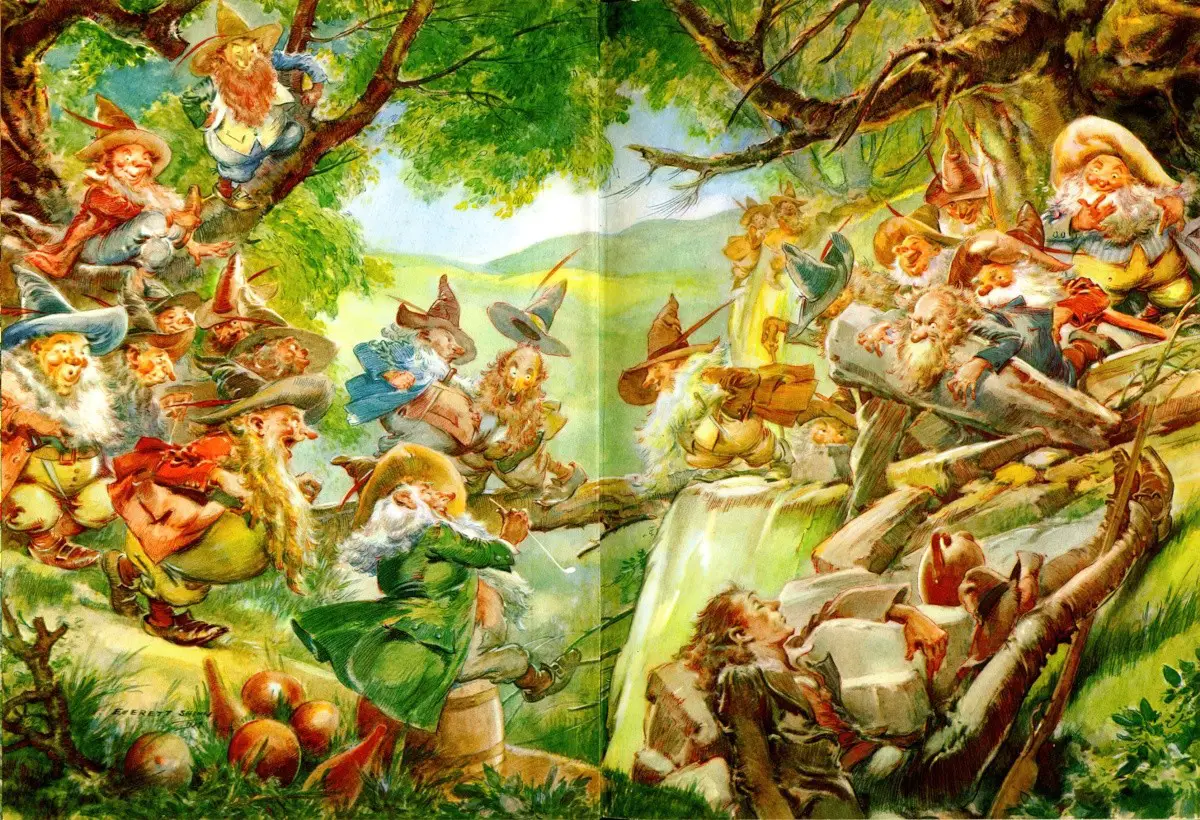
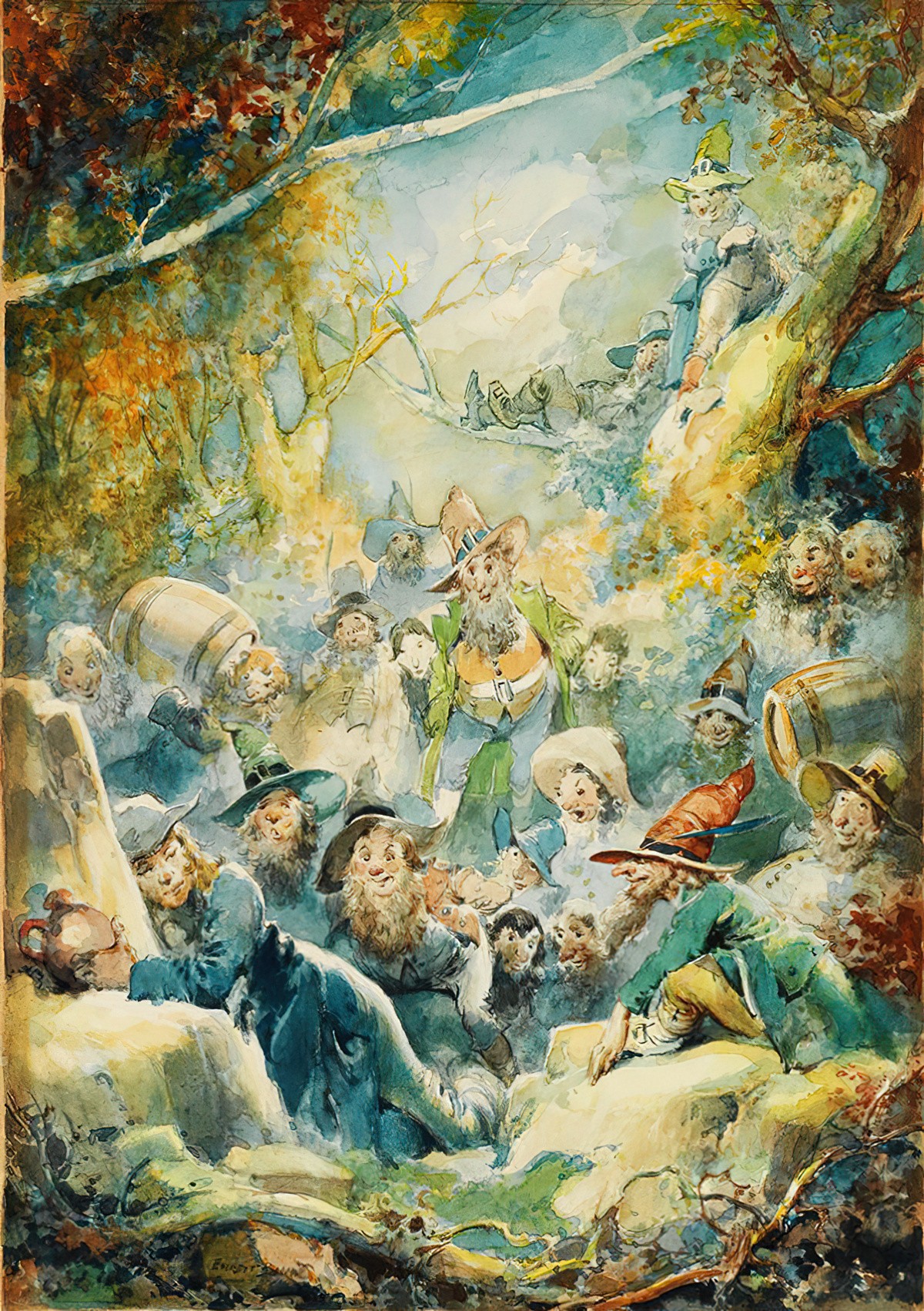
What seemed particularly odd to Rip was, that these folks were evidently amusing themselves, yet they maintained the gravest faces, the most mysterious silence, and were, withal, the most melancholy party of pleasure he had ever witnessed. Nothing interrupted the stillness of the scene but the noise of the balls, which, whenever they were rolled, echoed along the mountains like rumbling peals of thunder.
This feels like the cognitive dissonance of a drunkard who knows, deep down, that his own life has all the appearance of merriment but who is deep down filled with melancholy, because the drink is keeping him captive.
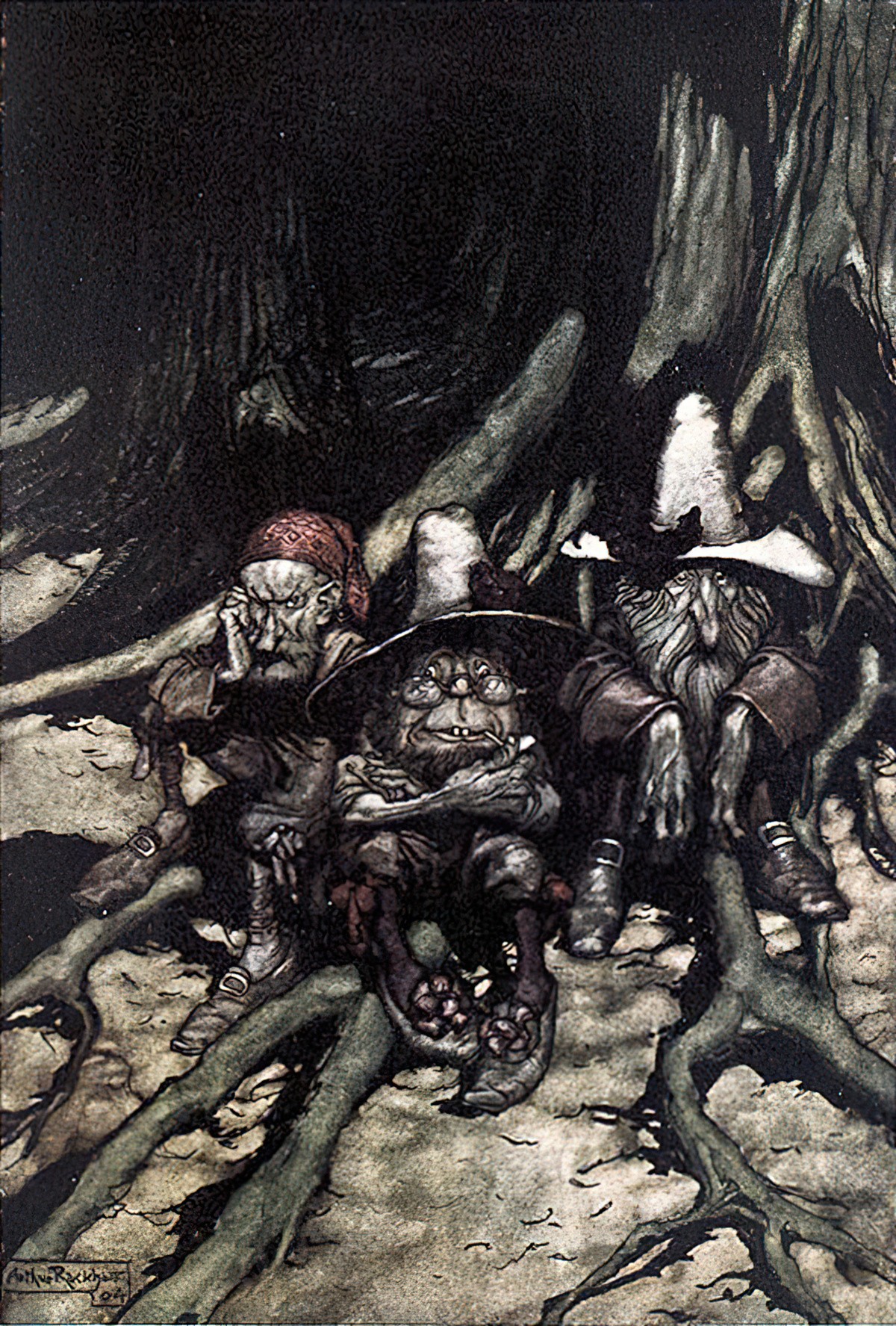
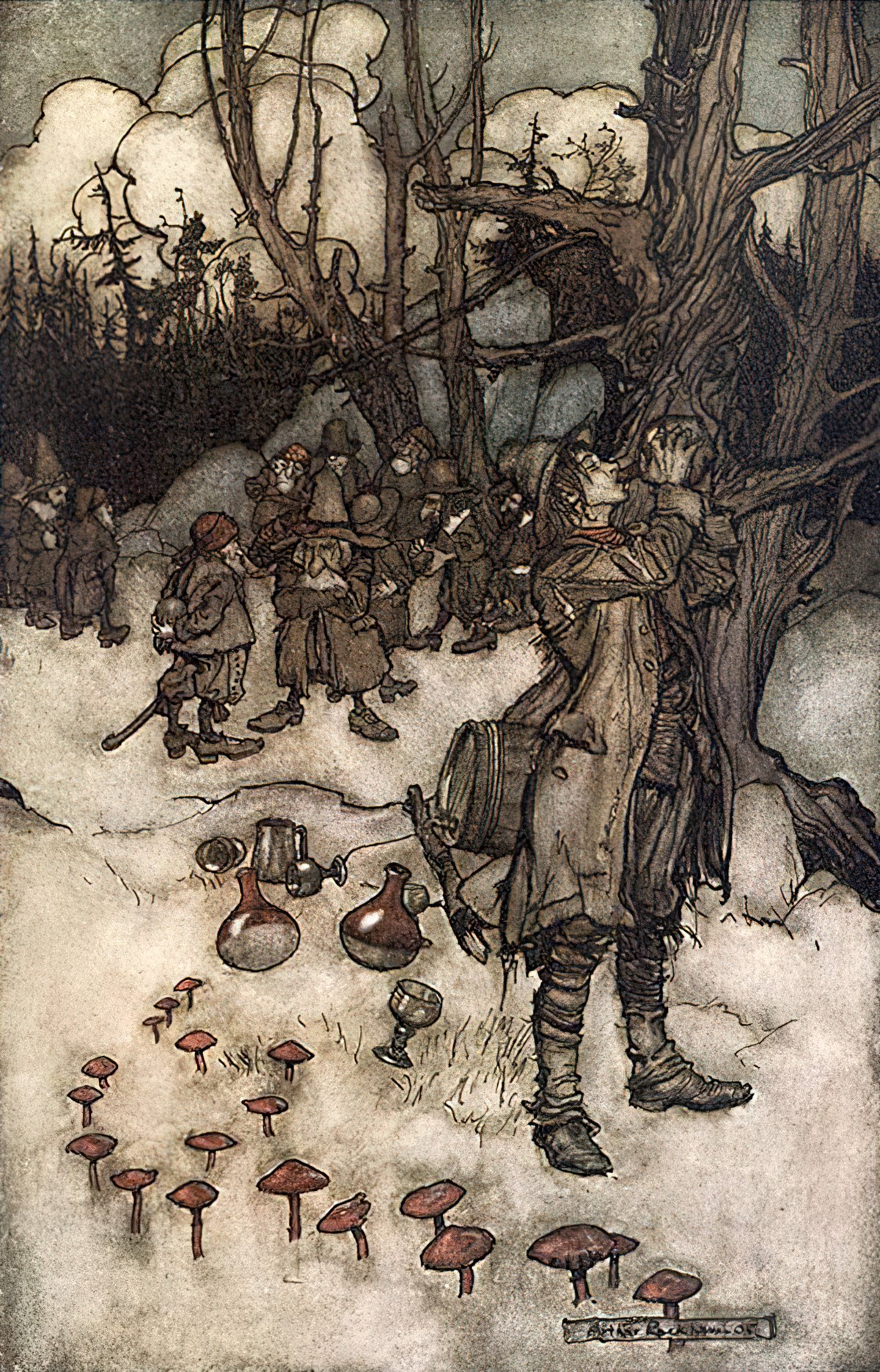
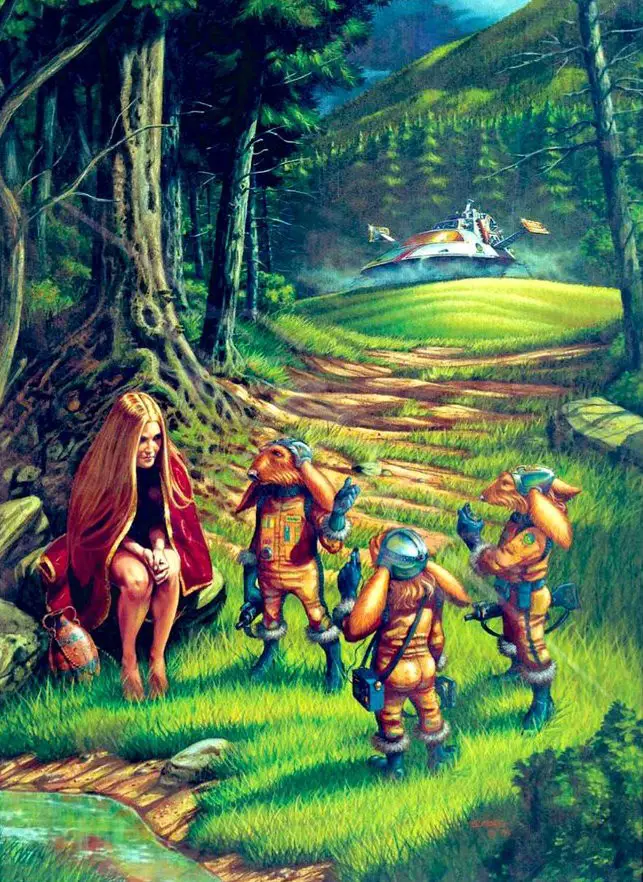
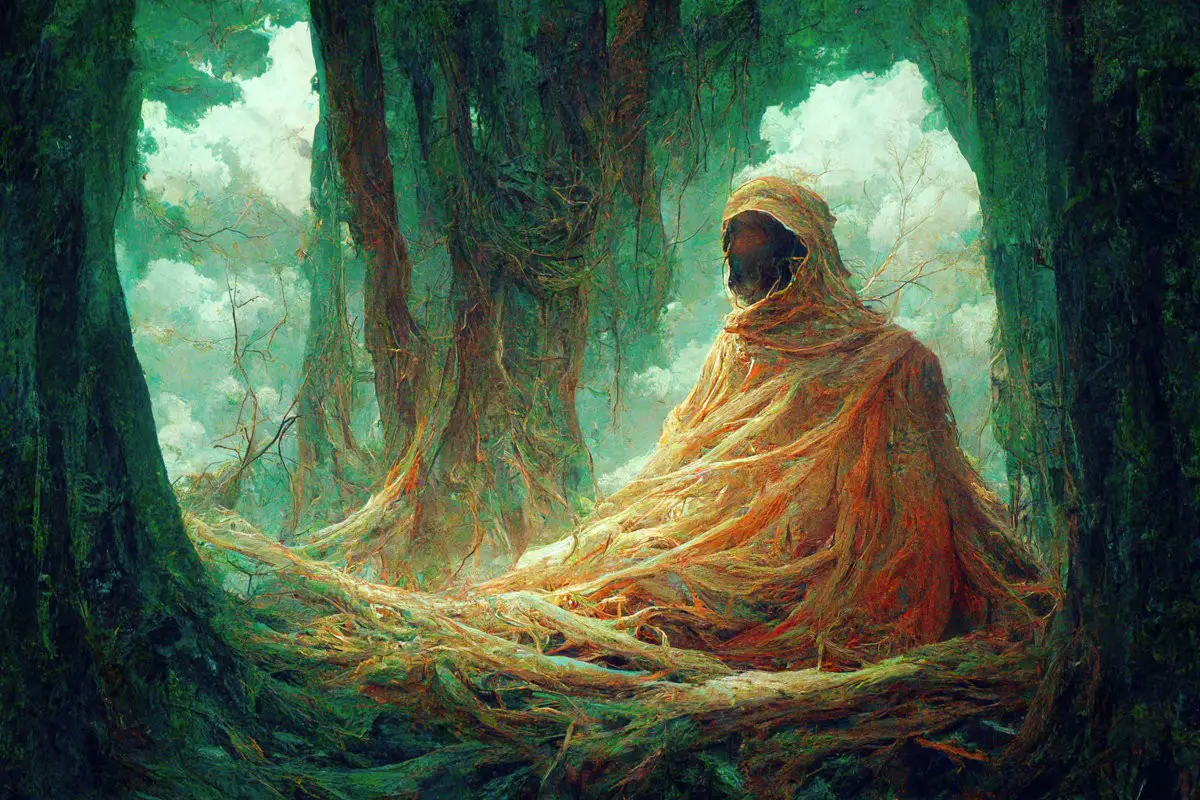
As Rip and his companion approached them, they suddenly desisted from their play, and stared at him with such fixed, statue-like gaze, and such strange, uncouth, lack-lustre countenances, that his heart turned within him, and his knees smote together. His companion now emptied the contents of the keg into large flagons, and made signs to him to wait upon the company. He obeyed with fear and trembling; they quaffed the liquor in profound silence, and then returned to their game.
Whereas we rarely use the word ‘smote together’ anymore, we still say ‘smitten with’, which is part of the same verb family. Smote: be strongly attracted to someone or something. It also means to strike with a firm blow.
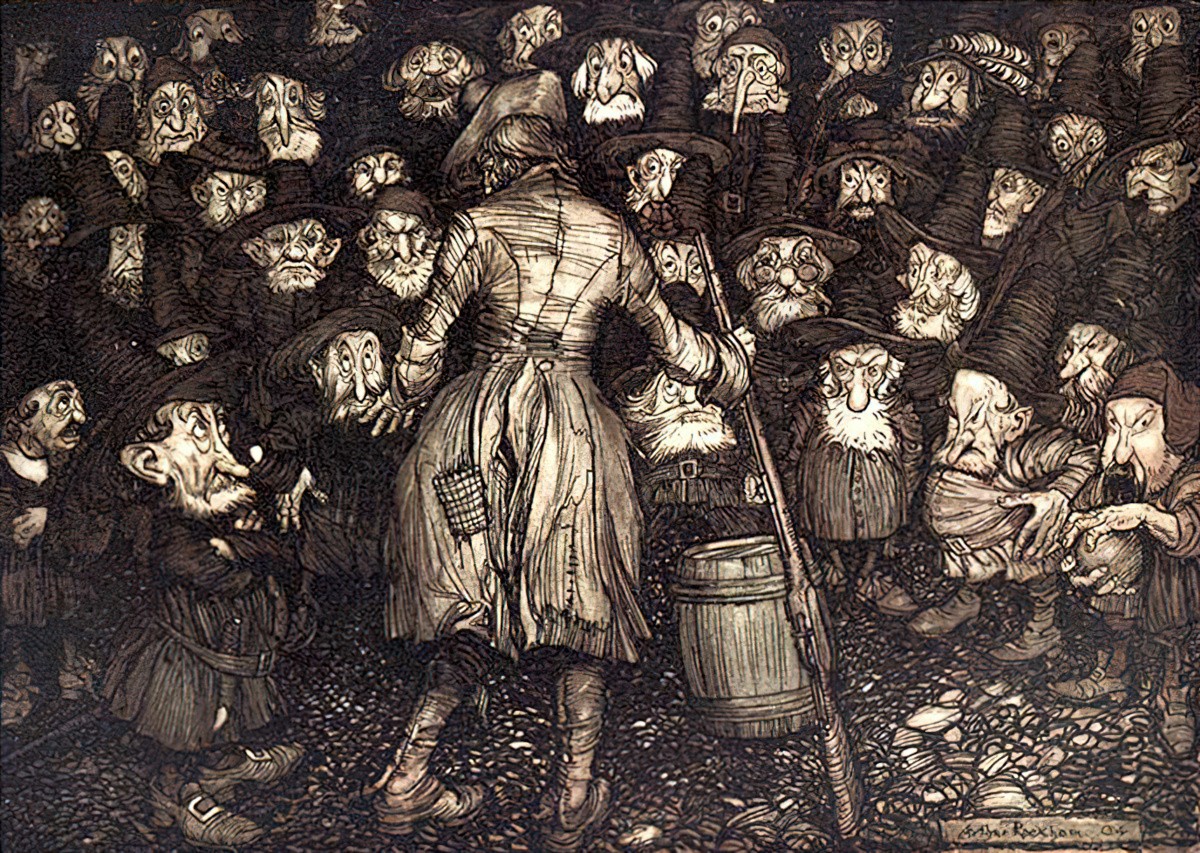
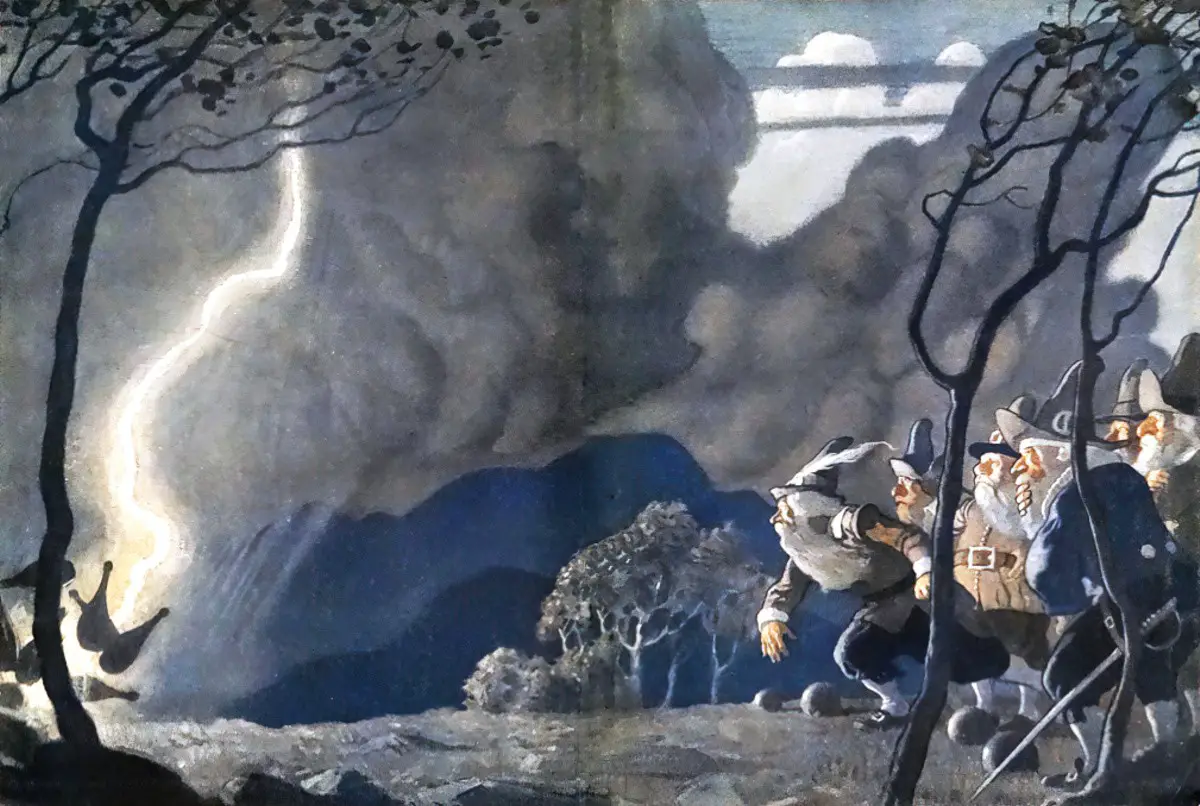
By degrees Rip’s awe and apprehension subsided. He even ventured, when no eye was fixed upon him, to taste the beverage, which he found had much of the flavour of excellent Hollands. He was naturally a thirsty soul, and was soon tempted to repeat the draught. One taste provoked another; and he reiterated his visits to the flagon so often that at length his senses were overpowered, his eyes swam in his head, his head gradually declined, and he fell into a deep sleep.
If you ever meet fairies in the wilderness, accept none of their food, none of their drink. Everyone listening to this story understands that. Once you’ve digested part of their world, they have entered you and can control you.
Every illustrator makes the decision to include an image of Rip Van Winkle asleep under a tree. This is a necessary panel, and the most memorable. If you remember nothing else of this story in twenty years’ time, you’ll probably remember it was about a guy who fell asleep for 20 years.
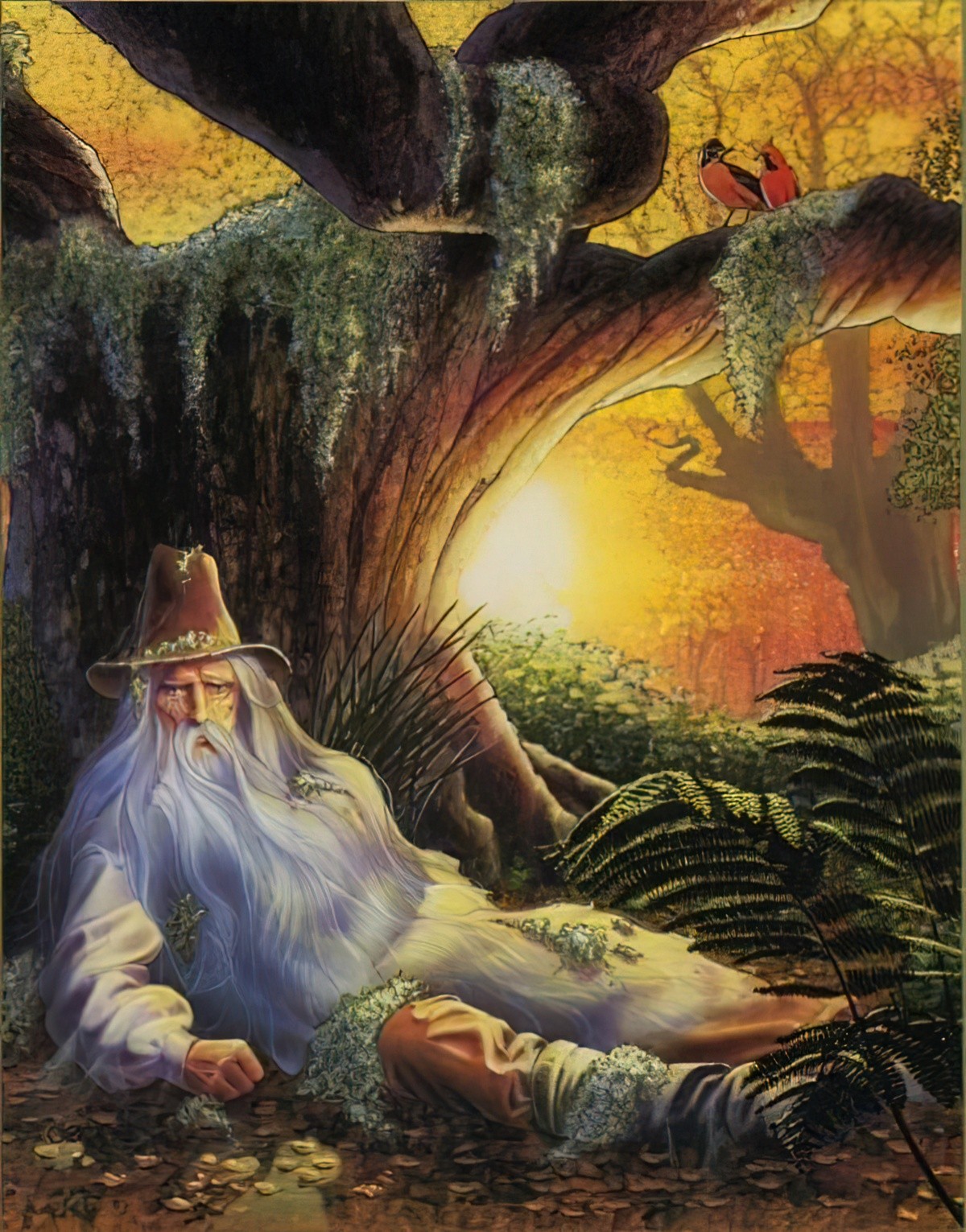
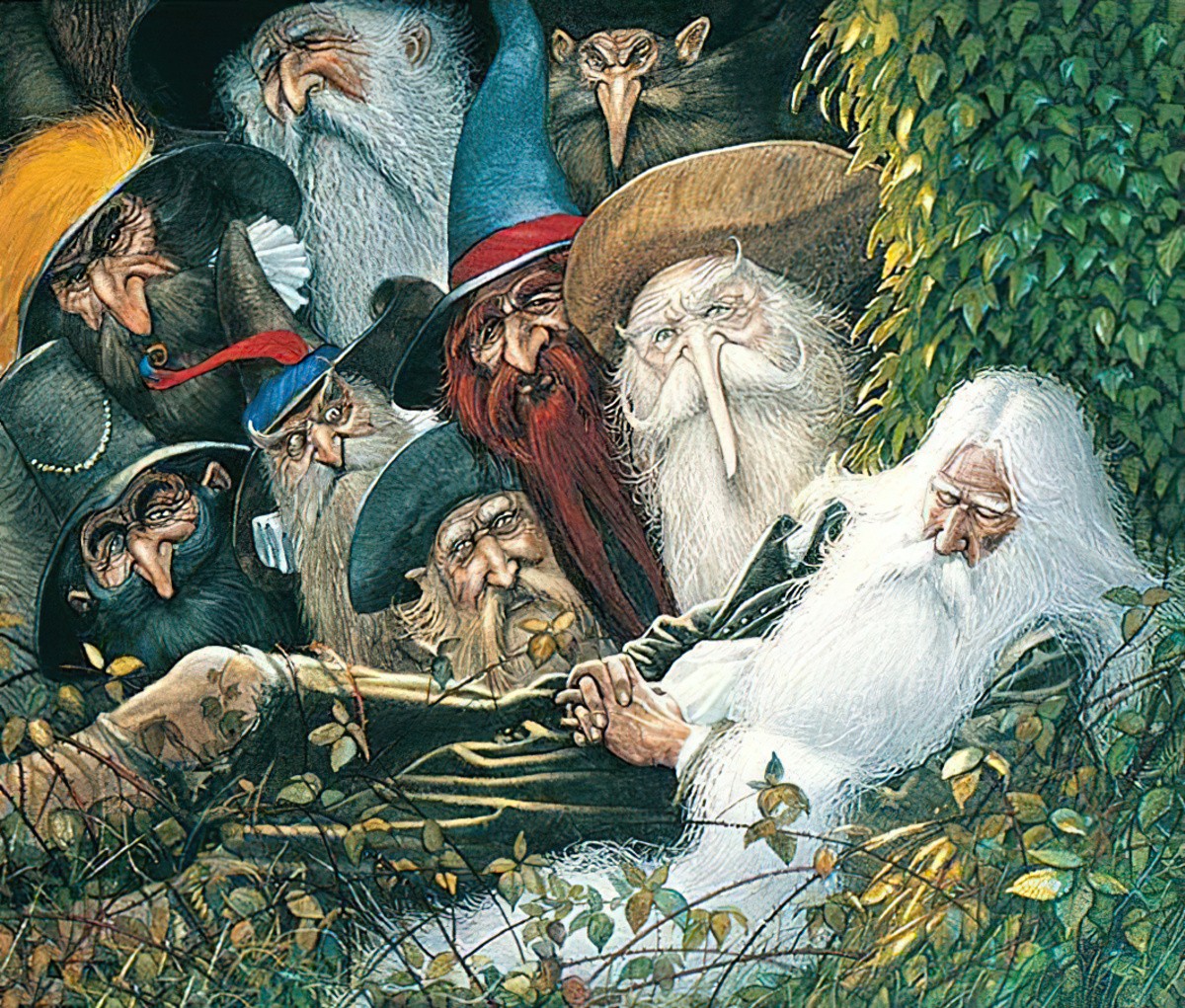
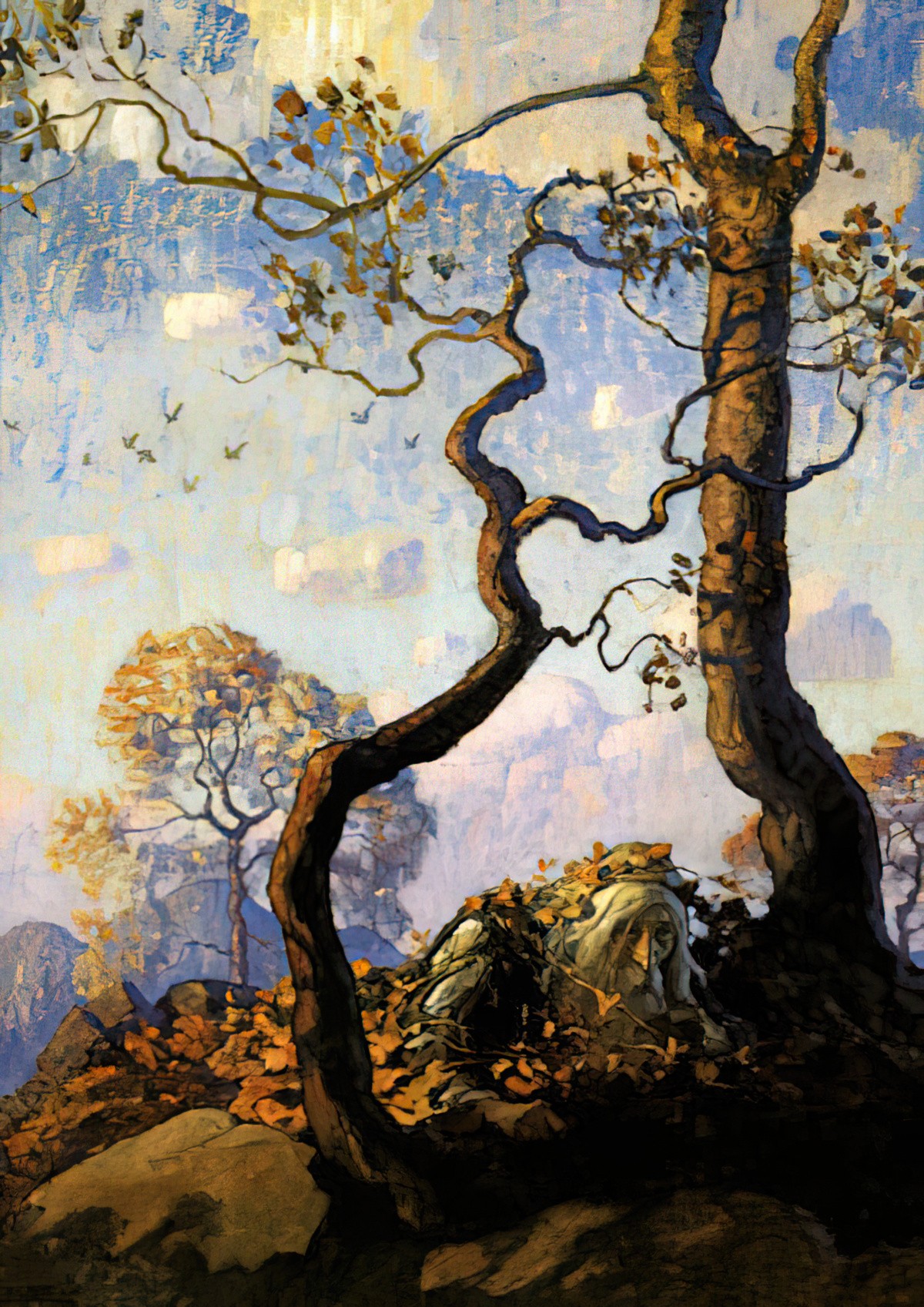
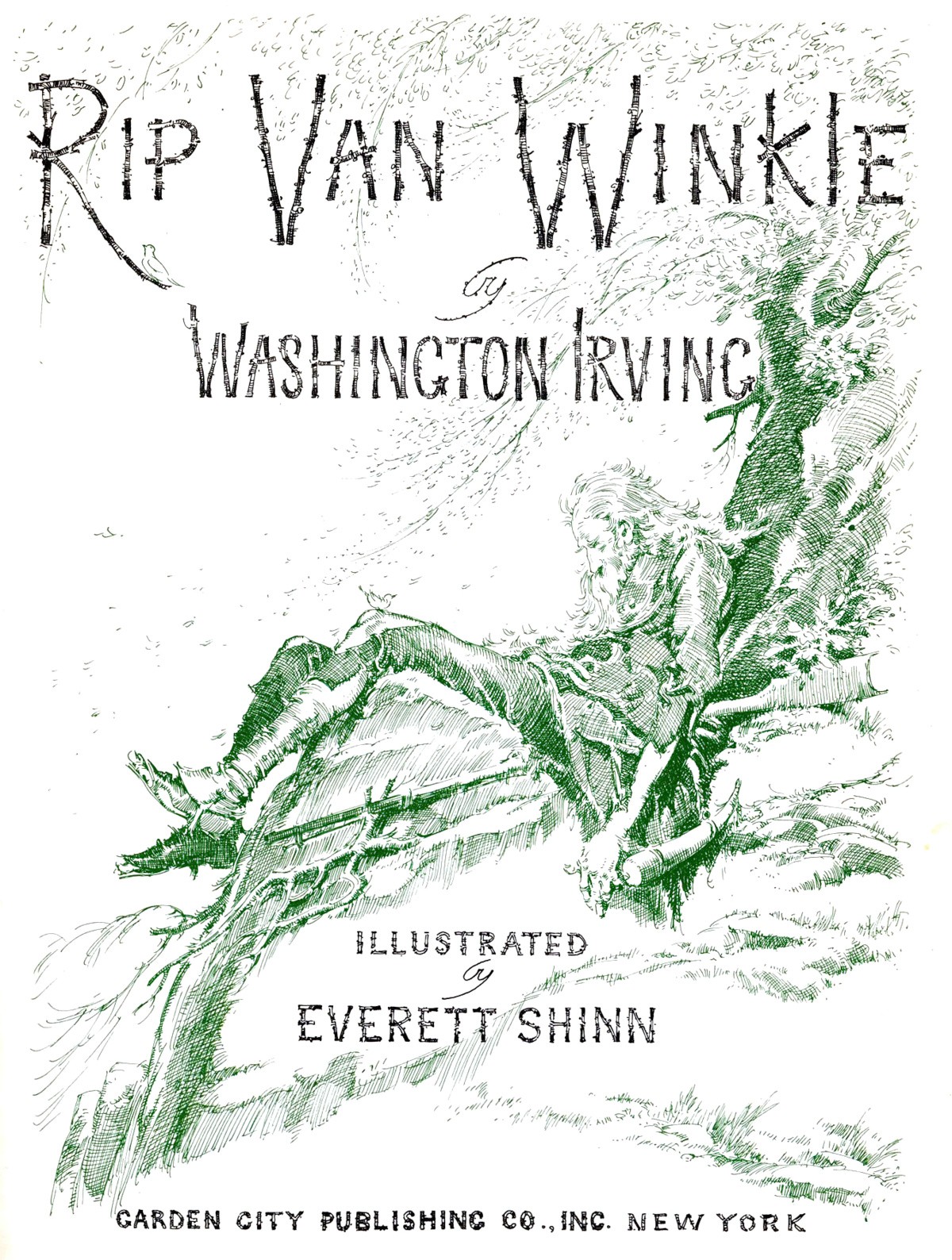

On waking, he found himself on the green knoll whence he had first seen the old man of the glen. He rubbed his eyes—it was a bright sunny morning. The birds were hopping and twittering among the bushes, and the eagle was wheeling aloft, and breasting the pure mountain breeze. “Surely,” thought Rip, “I have not slept here all night.” He recalled the occurrences before he fell asleep. The strange man with a keg of liquor—the mountain ravine—the wild retreat among the rocks—the woebegone party at ninepins—the flagon—“Oh! that flagon! that wicked flagon!” thought Rip,—“what excuse shall I make to Dame Van Winkle?”
It is spring or early summer, and Rip is getting a second chance to do his life over.
When he wonders what excuse he shall make to his wife, this suggests he cares more about her opinion than previously explained by the narrator, who tells us he simply ‘shrugs’. When he is drunk he doesn’t care, but now he’s sober, he does care a bit.
When Joseph Campbell wrote about this story, he noted that at this point in a story the hero generally learns some kind of lesson or has a self-revelation. It’s a bit more subtle with Rip: “Rip moved into the adventurous realm unconsciously, as we all do every night when we go to sleep.” When Rip returns home he has nothing to show for it. “Rip Van Winkle never knew what he had experienced; his return was a joke.” This is an inversion on the Odyssean mythic structure. Everyone had changed but Rip.
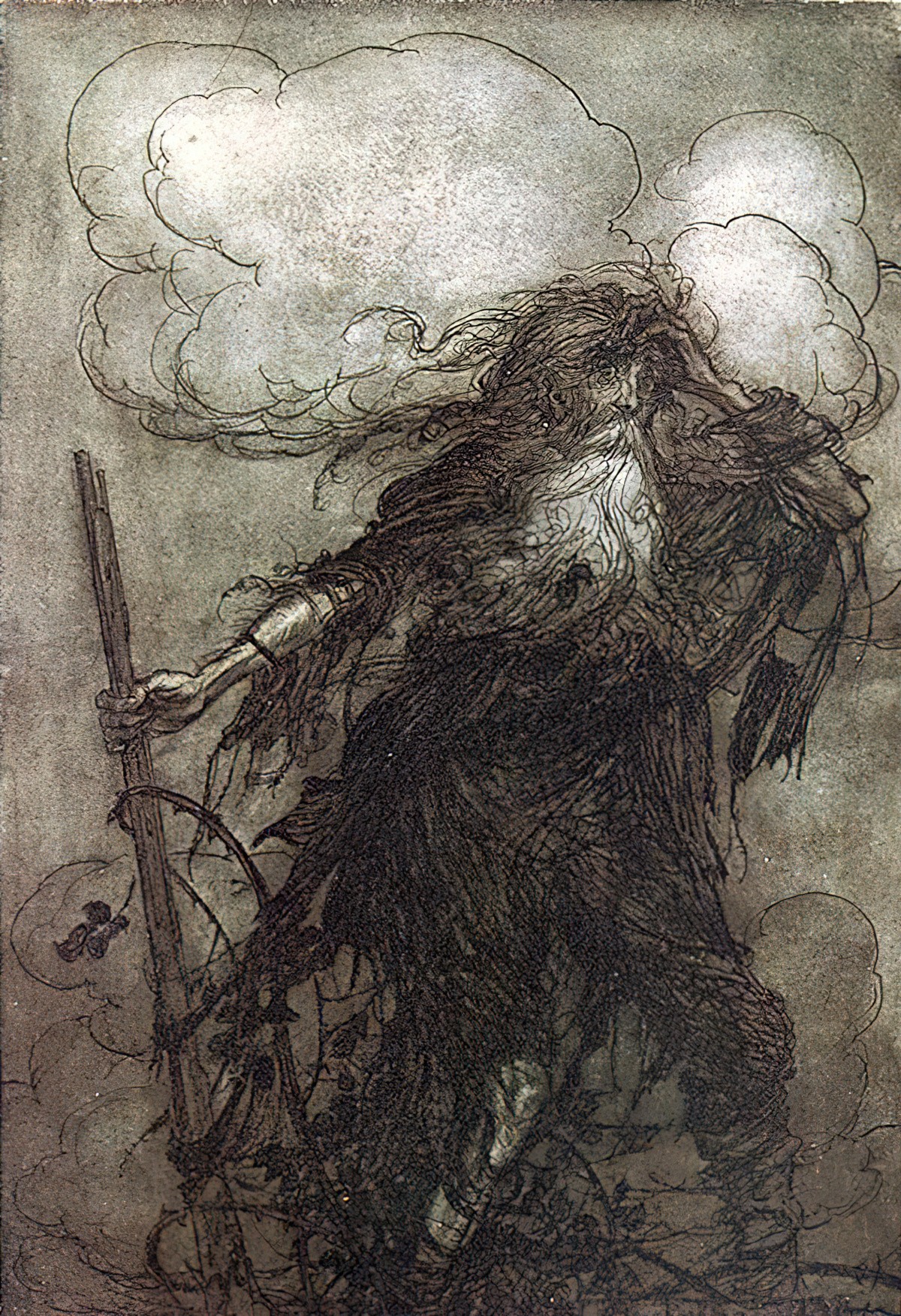
He looked round for his gun, but in place of the clean, well-oiled fowling-piece, he found an old firelock lying by him, the barrel incrusted with rust, the lock falling off, and the stock worm-eaten. He now suspected that the grave roysterers of the mountains had put a trick upon him, and, having dosed him with liquor, had robbed him of his gun. Wolf, too, had disappeared, but he might have strayed away after a squirrel or partridge. He whistled after him, and shouted his name, but all in vain; the echoes repeated his whistle and shout, but no dog was to be seen.
Fowling piece: a shotgun for shooting birds or small animals, or squirrels, in the case of Van Winkle, which I assume are less popular for eating, even back then, underscoring Rip’s utter uselessness as a provider. Although squirrels are edible, there’s little meat on one of them, and their preparation is tedious, as all of the musk glands must be removed. This task would of course fall on the Dame.
Firelock: a musket in which the priming is ignited by sparks.
Dogs only live thirteen years, so Wolf has of course died. Perhaps Wolf returned to the village. This rotten gun symbolises Rip’s uselessness during a war he would otherwise have been expected to fight in.
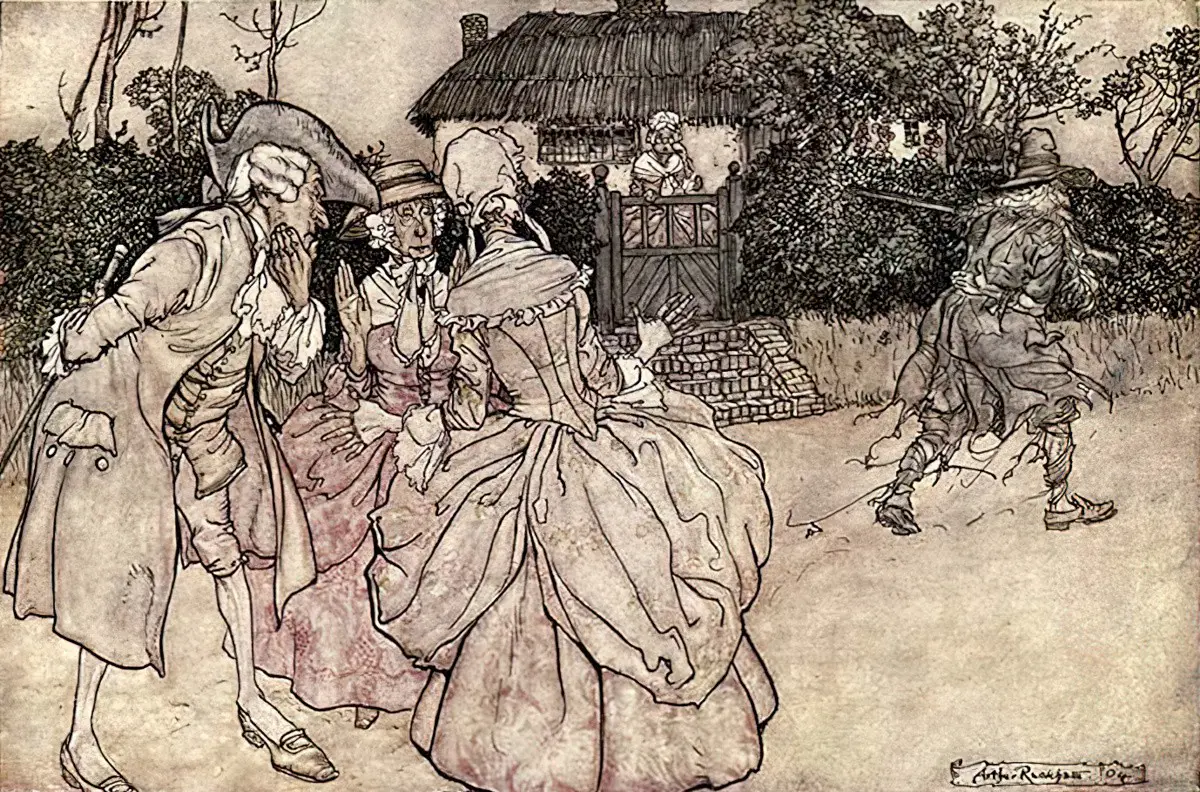
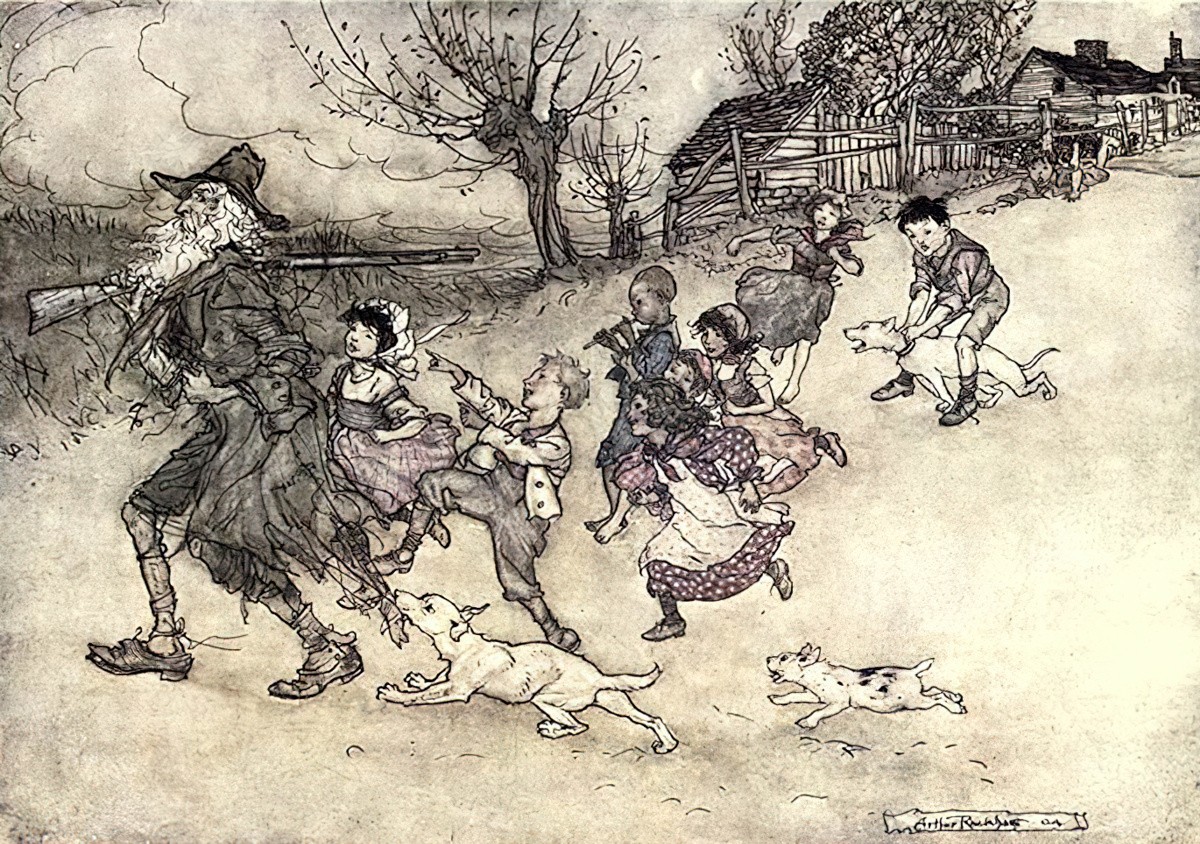
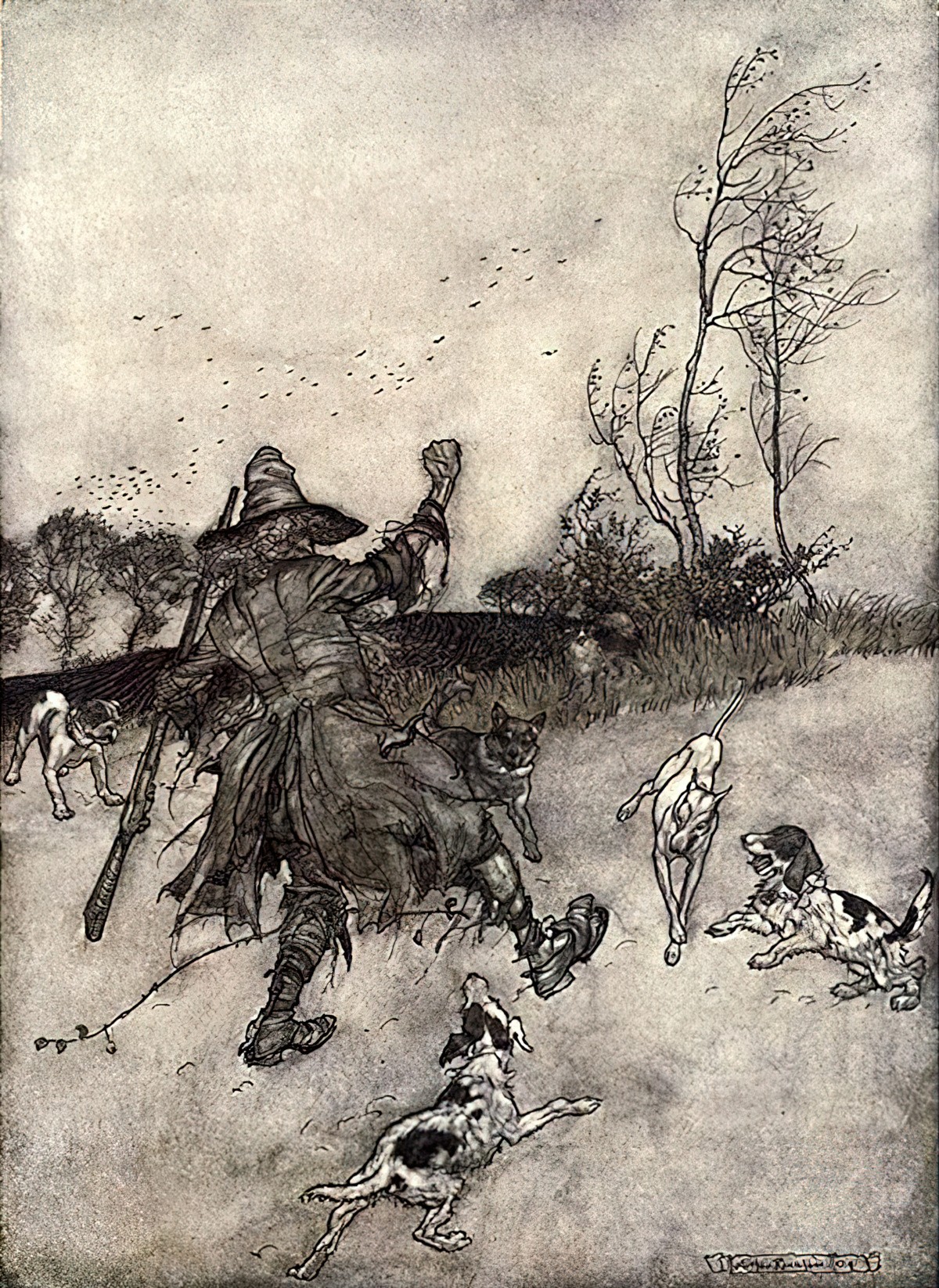
He determined to revisit the scene of the last evening’s gambol, and if he met with any of the party, to demand his dog and gun. As he rose to walk, he found himself stiff in the joints, and wanting in his usual activity. “These mountain beds do not agree with me,” thought Rip, “and if this frolic should lay me up with a fit of the rheumatism, I shall have a blessed time with Dame Van Winkle.” With some difficulty he got down into the glen: he found the gully up which he and his companion had ascended the preceding evening; but to his astonishment a mountain stream was now foaming down it, leaping from rock to rock, and filling the glen with babbling murmurs. He, however, made shift to scramble up its sides, working his toilsome way through thickets of birch, sassafras, and witch-hazel, and sometimes tripped up or entangled by the wild grape-vines that twisted their coils or tendrils from tree to tree, and spread a kind of network in his path.
Note how Rip worries about being convalesced with his wife by his side. What he does not worry about: That she will refuse to care for him, leaving him to die. He takes it entirely for granted that his wife will care for him while he’s ill.
At length he reached to where the ravine had opened through the cliffs to the amphitheatre; but no traces of such opening remained. The rocks presented a high, impenetrable wall, over which the torrent came tumbling in a sheet of feathery foam, and fell into a broad deep basin, black from the shadows of the surrounding forest. Here, then, poor Rip was brought to a stand. He again called and whistled after his dog; he was only answered by the cawing of a flock of idle crows, sporting high in the air about a dry tree that overhung a sunny precipice; and who, secure in their elevation, seemed to look down and scoff at the poor man’s perplexities. What was to be done? the morning was passing away, and Rip felt famished for want of his breakfast. He grieved to give up his dog and gun; he dreaded to meet his wife; but it would not do to starve among the mountains. He shook his head, shouldered the rusty firelock, and, with a heart full of trouble and anxiety, turned his steps homeward.
Note that Rip Van Winkle is far more bereft about losing his gun and his dog than about losing his wife.
As he approached the village he met a number of people, but none whom he knew, which somewhat surprised him, for he had thought himself acquainted with every one in the country round. Their dress, too, was of a different fashion from that to which he was accustomed. They all stared at him with equal marks of surprise, and whenever they cast their eyes upon him, invariably stroked their chins. The constant recurrence of this gesture induced Rip, involuntarily, to do the same, when, to his astonishment, he found his beard had grown a foot long!
Then as now, fashion is a reliable marker of time passing. Those children he hung out with are grown now. Do they recognise him as an old man?
He had now entered the skirts of the village. A troop of strange children ran at his heels, hooting after him, and pointing at his grey beard. The dogs, too, not one of whom he recognised for an old acquaintance, barked at him as he passed. The very village was altered; it was larger and more populous. There were rows of houses which he had never seen before, and those which had been his familiar haunts had disappeared. Strange names were over the doors—strange faces at the windows—everything was strange. His mind now misgave him; he began to doubt whether both he and the world around him were not bewitched. Surely this was his native village, which he had left but the day before. There stood the Kaatskill Mountains—there ran the silver Hudson at a distance—there was every hill and dale precisely as it had always been. Rip was sorely perplexed. “That flagon last night,” thought he, “has addled my poor head sadly!”
An alternative reading, avoiding the supernatural: Rip gets drunk, falls over in the wilderness and sustains a head injury. The head injury doesn’t kill him, but suddenly he can’t remember any of his old acquaintances, including his wife. The injury ages him twenty years, but not literally.
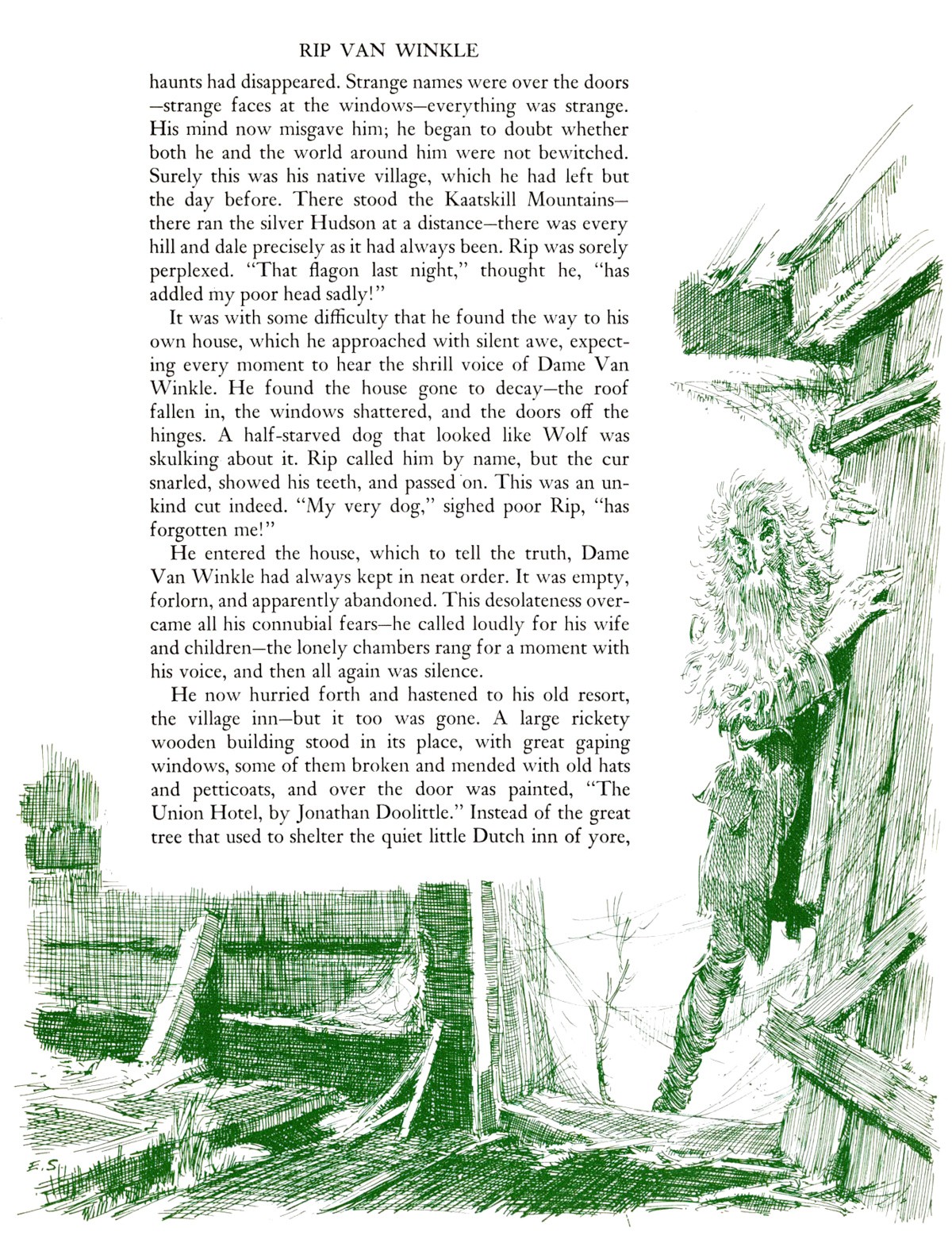
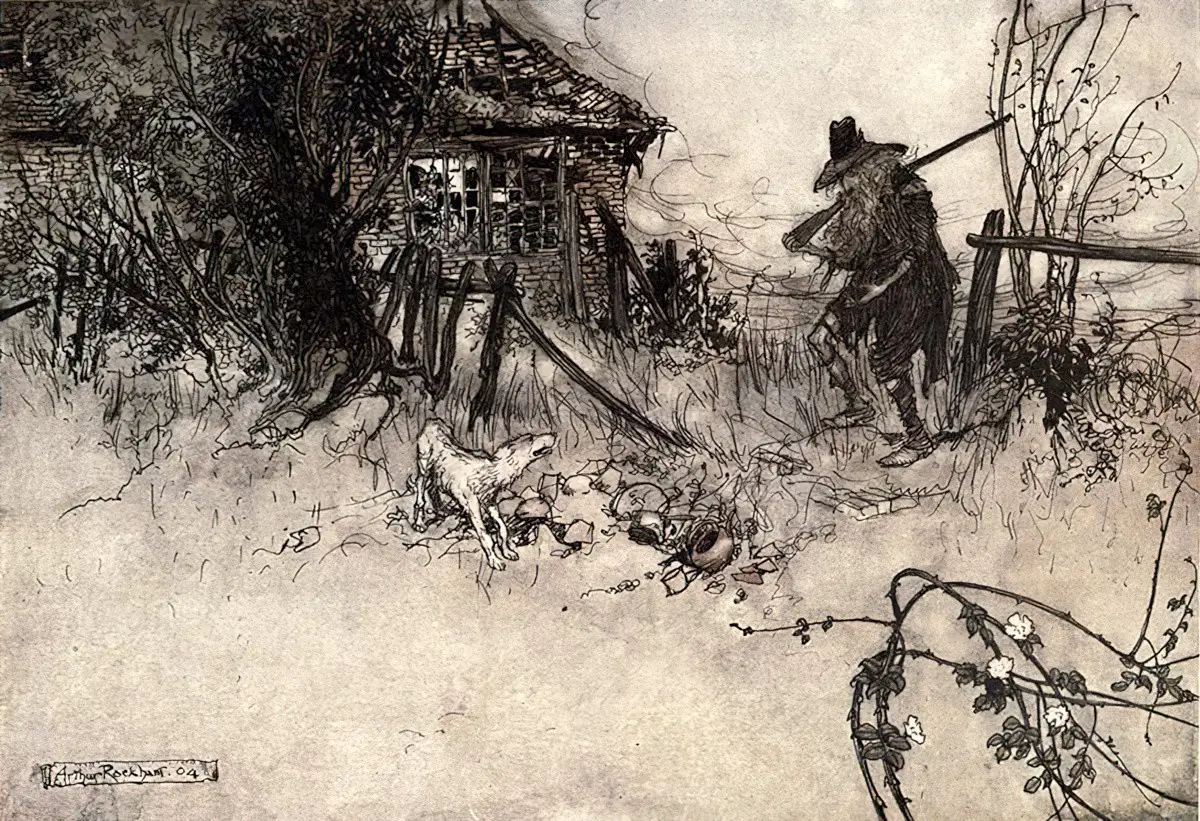
It was with some difficulty that he found the way to his own house, which he approached with silent awe, expecting every moment to hear the shrill voice of Dame Van Winkle. He found the house gone to decay—the roof had fallen in, the windows shattered, and the doors off the hinges. A half-starved dog that looked like Wolf was skulking about it. Rip called him by name, but the cur snarled, showed his teeth, and passed on. This was an unkind cut indeed. “My very dog,” sighed poor Rip, “has forgotten me!”
This can’t be Rip’s own dog because dogs don’t live that long.
He entered the house, which, to tell the truth, Dame Van Winkle had always kept in neat order. It was empty, forlorn, and apparently abandoned. This desolateness overcame all his connubial fears—he called loudly for his wife and children—the lonely chambers rang for a moment with his voice, and then all again was silence.
Here we have it confirmed that Dame Van Winkle not only did her husband’s job for him as provider, but also upheld her own end of the marriage bargain nicely.
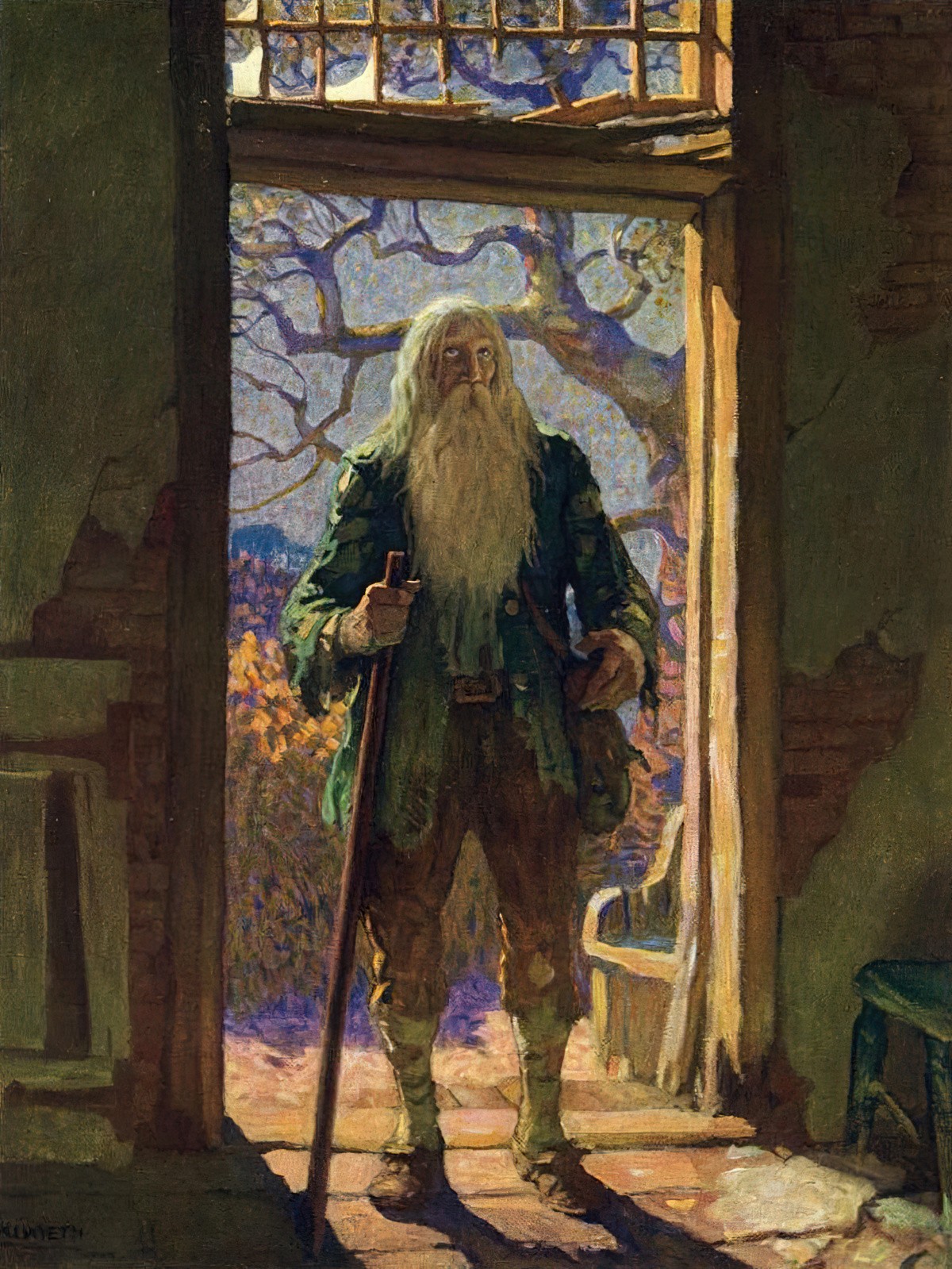
He now hurried forth, and hastened to his old resort, the village inn—but it too was gone. A large rickety wooden building stood in its place, with great gaping windows, some of them broken and mended with old hats and petticoats, and over the door was painted, “The Union Hotel, by Jonathan Doolittle.” Instead of the great tree that used to shelter the quiet little Dutch inn of yore, there now was reared a tall, naked pole, with something on the top that looked like a red nightcap, and from it was fluttering a flag, on which was a singular assemblage of stars and stripes;—all this was strange and incomprehensible. He recognised on the sign, however, the ruby face of King George, under which he had smoked so many a peaceful pipe; but even this was singularly metamorphosed. The red coat was changed for one of blue and buff, a sword was held in the hand instead of a sceptre, the head was decorated with a cocked hat, and underneath was painted in large characters, “General Washington.”
1776 – On the first of January, The Grand Union Flag is flown on Prospect Hill and adopted as a symbol of the rebelling colonists. The flag, originally designed in 1775, features the British Union Jack in the upper left corner surrounded by thirteen white and red stripes, symbolizing the thirteen colonies. Rip Van Winkle was away for a significant shift in American history.
There was, as usual, a crowd of folk about the door, but none that Rip recollected. The very character of the people seemed changed. There was a busy, bustling, disputatious tone about it, instead of the accustomed phlegm and drowsy tranquillity. He looked in vain for the sage Nicholas Vedder, with his broad face, double chin, and fair long pipe, uttering clouds of tobacco-smoke instead of idle speeches; or Van Bummel, the schoolmaster, doling forth the contents of an ancient newspaper. In place of these, a lean, bilious-looking fellow, with his pockets full of handbills, was haranguing vehemently about rights of citizens—elections—members of congress—liberty—Bunker’s Hill—heroes of seventy-six—and other words, which were a perfect Babylonish jargon to the bewildered Van Winkle.
The appearance of Rip, with his long, grizzled beard, his rusty fowling-piece, his uncouth dress, and an army of women and children at his heels, soon attracted the attention of the tavern politicians. They crowded round him, eyeing him from head to foot with great curiosity. The orator bustled up to him, and, drawing him partly aside, inquired “On which side he voted?” Rip stared in vacant stupidity. Another short but busy little fellow pulled him by the arm, and, rising on tiptoe, inquired in his ear, “Whether he was Federal or Democrat?” Rip was equally at a loss to comprehend the question; when a knowing, self-important old gentleman, in a sharp cocked hat, made his way through the crowd, putting them to the right and left with his elbows as he passed, and planting himself before Van Winkle, with one arm akimbo, the other resting on his cane, his keen eyes and sharp hat penetrating, as it were, into his very soul, demanded in an austere tone, “What brought him to the election with a gun on his shoulder, and a mob at his heels; and whether he meant to breed a riot in the village?” “Alas! gentlemen,” cried Rip, somewhat dismayed, “I am a poor quiet man, a native of the place, and a loyal subject of the king, God bless him!”
Rip Van Winkle is set in New York. Something often forgotten about the history of America’s suffrage: Briefly, in New Jersey, women and people of colour were allowed to vote:
Women voted in Revolutionary America, over a hundred years before the United States Constitution guaranteed that right to women nationally.
The 1776 New Jersey State Constitution referred to voters as “they,” and statutes passed in 1790 and 1797 defined voters as “he or she.” This opened the electorate to free property owners, Black and white, male and female, in New Jersey. This lasted until 1807, when a new state law said only white men could vote.”
When Women Lost The Vote
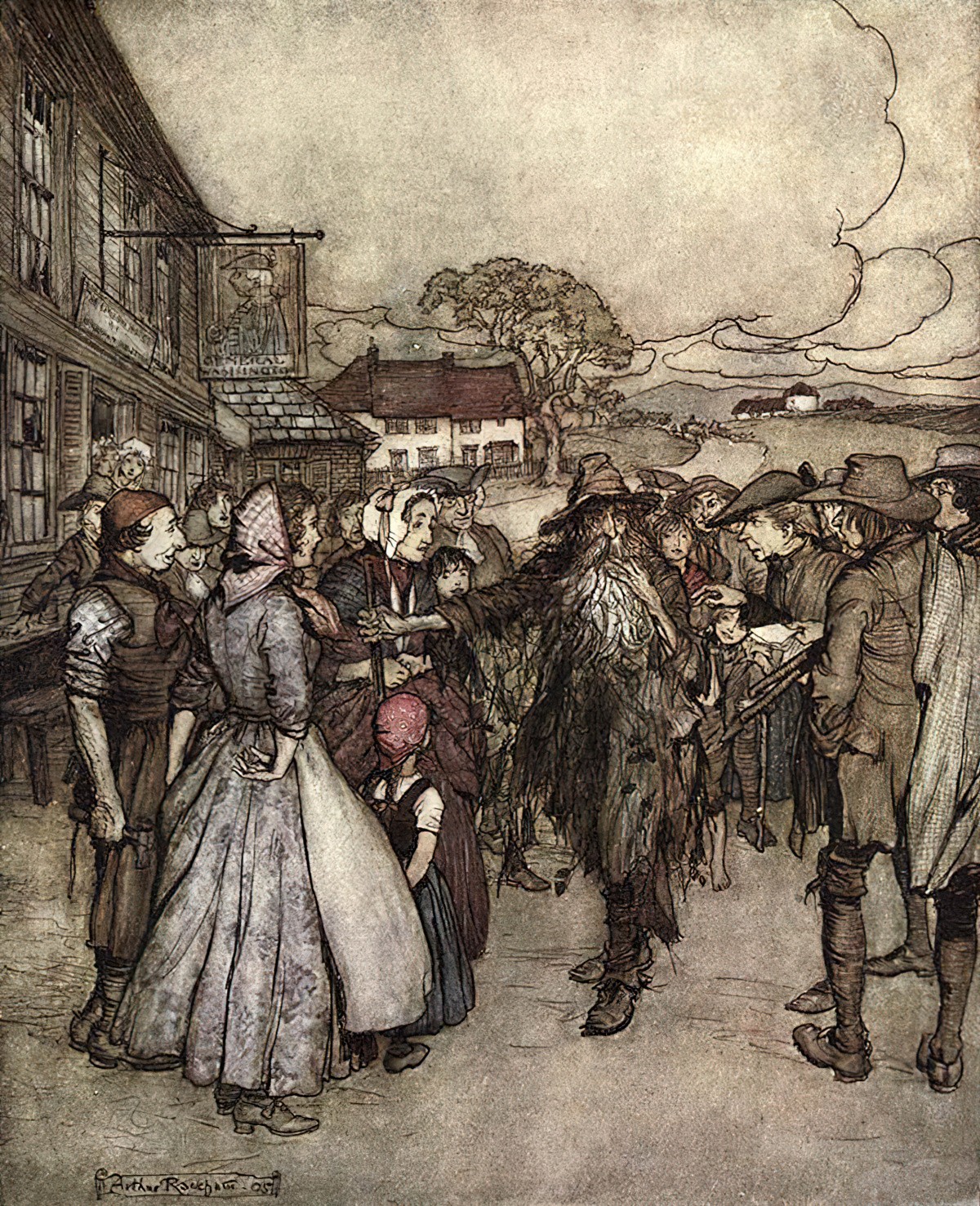
Here a general shout burst from the bystanders—“A tory! a tory! a spy! a refugee! hustle him! away with him!” It was with great difficulty that the self-important man in the cocked hat restored order; and, having assumed a tenfold austerity of brow, demanded again of the unknown culprit, what he came there for, and whom he was seeking? The poor man humbly assured him that he meant no harm, but merely came there in search of some of his neighbours, who used to keep about the tavern.
White colonists of America were keen to become independent from Britain because they had no control over the rules set from Britain which very much affected them. Rip hasn’t been around for any of this talk. He was always too drunk to understand politics, and also, he was disenfranchised from it.
His name is, of course, symbolic. His nap coincides with a ‘rip’ in American history, when the colonies were ripped away from the Homeland, and the old folk ripped away from the more progressive politics of their children.
“Well—who are they?—name them.”
Rip bethought himself a moment, and inquired: “Where’s Nicholas Vedder?”
There was a silence for a little while, when an old man replied, in a thin, piping voice, “Nicholas Vedder! why, he is dead and gone these eighteen years! There was a wooden tombstone in the churchyard that used to tell all about him, but that’s rotten and gone too.”
“Where’s Brom Dutcher?”
“Oh, he went off to the army in the beginning of the war; some say he was killed at the storming of Stony Point—others say he was drowned in a squall at the foot of Antony’s Nose. I don’t know—he never came back again.”
“Where’s Van Bummel, the schoolmaster?”
“He went off to the wars too, was a great militia general, and is now in congress.”
Rip’s heart died away at hearing of these sad changes in his home and friends, and finding himself thus alone in the world. Every answer puzzled him too, by treating of such enormous lapses of time, and of matters which he could not understand: war—congress—Stony Point;—he had no courage to ask after any more friends, but cried out in despair: “Does nobody here know Rip Van Winkle?”
“Oh, Rip Van Winkle!” exclaimed two or three, “oh, to be sure! that’s Rip Van Winkle yonder, leaning against the tree.”
As evidence of Rip’s strongly homosocial world, he is devastated to learn that his male friends have died. He knows he ‘is alone in the world’, but not a thought goes to his wife.
Rip looked, and beheld a precise counterpart of himself, as he went up the mountain; apparently as lazy, and certainly as ragged. The poor fellow was now completely confounded. He doubted his own identity, and whether he was himself or another man. In the midst of his bewilderment, the man in the cocked hat demanded who he was, and what was his name.
“God knows!” exclaimed he, at his wit’s end; “I’m not myself—I’m somebody else—that’s me yonder—no—that’s somebody else got into my shoes—I was myself last night, but I fell asleep on the mountain, and they’ve changed my gun, and everything’s changed, and I can’t tell what’s my name, or who I am!”
The bystanders began now to look at each other, nod, wink significantly, and tap their fingers against their foreheads. There was a whisper, also, about securing the gun, and keeping the old fellow from doing mischief, at the very suggestion of which the self-important man in the cocked hat retired with some precipitation. At this critical moment a fresh, comely woman pressed through the throng to get a peep at the grey-bearded man. She had a chubby child in her arms, which, frightened at his looks, began to cry. “Hush, Rip,” cried she, “hush, you little fool; the old man won’t hurt you.” The name of the child, the air of the mother, the tone of her voice, all awakened a train of recollections in his mind. “What is your name, my good woman?” asked he.
Is laziness even a thing? I’m not so sure.

Let’s (momentarily) take a kinder look at the pressures Rip was under. Liberals of antebellum America were very, very keen for all the men to work very hard. For patriarchal capitalism to work, citizens had to be economically independent and also build families with children who would grow up to be good workers themselves. However, this wasn’t quite enough. Unless a man was the boss of his household, he wasn’t considered a full and proper man. He was required by society to subjugate and rule over his wife. When Irving describes Rip as childlike, literally playing with children, that’s because unless a man was the boss of his wife, he was literally considered a child in the eyes of the state. He was not a full citizen. No one could have predicted back then, that America would rise to be the world power it is today.
“Judith Gardenier.”
“And your father’s name?”
“Ah, poor man, Rip Van Winkle was his name, but it’s twenty years since he went away from home with his gun, and never has been heard of since,—his dog came home without him; but whether he shot himself, or was carried away by the Indians, nobody can tell. I was then but a little girl.”
Rip had but one question more to ask; but he put it with a faltering voice:
“Where’s your mother?”
“Oh, she too had died but a short time since; she broke a blood vessel in a fit of passion at a New-England pedler.”
There was a drop of comfort, at least, in this intelligence. The honest man could contain himself no longer. He caught his daughter and her child in his arms. “I am your father!” cried he—“Young Rip Van Winkle once—old Rip Van Winkle now!—Does nobody know poor Rip Van Winkle?”
The daughter has turned out well because she had a good role model in her mother. She’s a mother herself now, and would realistically see her own mother’s plight in a new light. Yet she remains in thrall to her father, the legendary man who walked into the woods and never came back. She’s even named her son after him (also the name of her brother).
All stood amazed, until an old woman, tottering out from among the crowd, put her hand to her brow, and peering under it in his face for a moment, exclaimed: “Sure enough! it is Rip Van Winkle—it is himself! Welcome home again, old neighbour. Why, where have you been these twenty long years?”
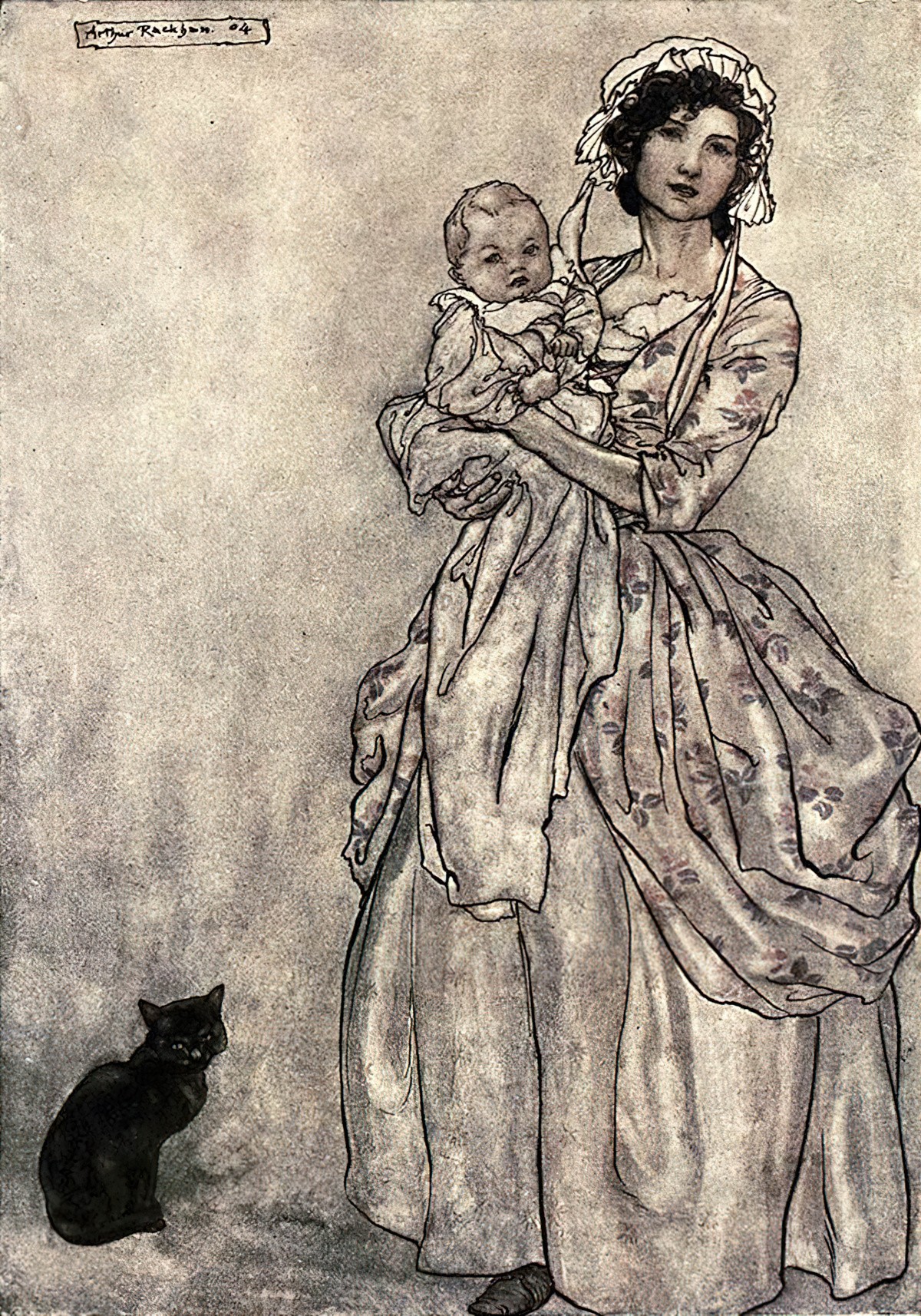
Rip’s story was soon told, for the whole twenty years had seemed to him as but one night. The neighbours stared when they heard it; some were seen to wink at each other, and put their tongues in their cheeks; and the self-important man in the cocked hat, who, when the alarm was over, had returned to the field, screwed down the corners of his mouth, and shook his head—upon which there was a general shaking of the head throughout the assemblage.
The scene in a supernatural story where the story is recounted and disbelieved, is mandatory.
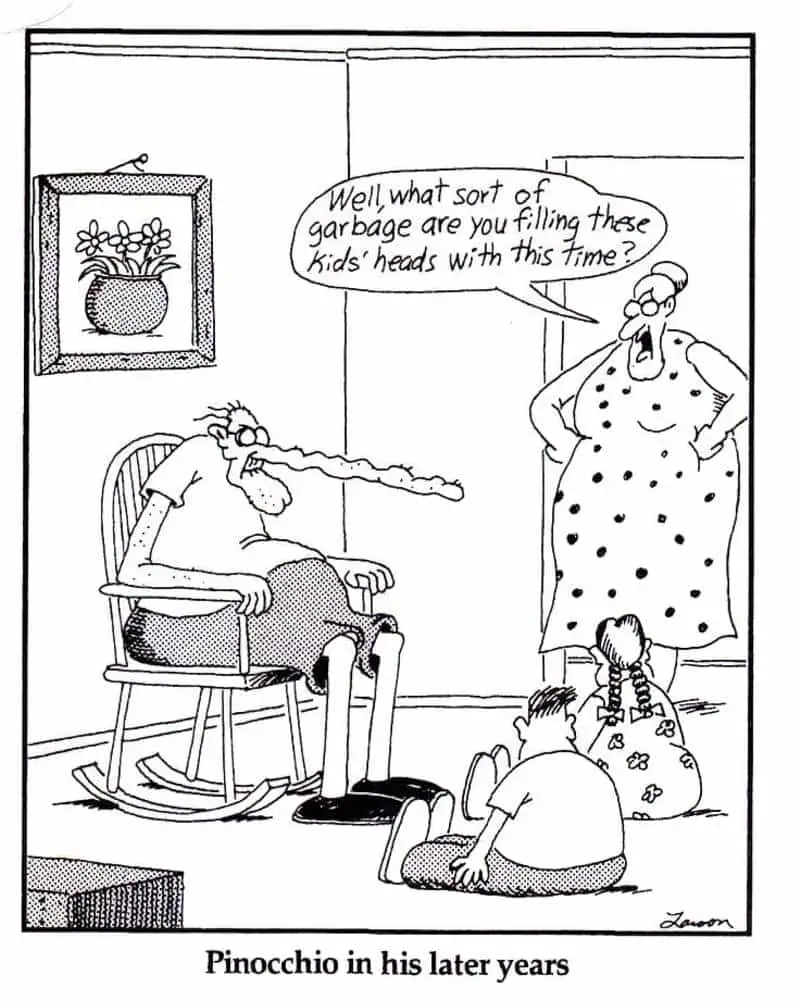
It was determined, however, to take the opinion of old Peter Vanderdonk, who was seen slowly advancing up the road. He was a descendant of the historian of that name, who wrote one of the earliest accounts of the province. Peter was the most ancient inhabitant of the village, and well versed in all the wonderful events and traditions of the neighbourhood. He recollected Rip at once, and corroborated his story in the most satisfactory manner. He assured the company that it was a fact, handed down from his ancestor the historian, that the Kaatskill mountains had always been haunted by strange beings. That it was affirmed that the great Hendrick Hudson, the first discoverer of the river and country, kept a kind of vigil there every twenty years, with his crew of the Half-moon; being permitted in this way to revisit the scenes of his enterprise, and keep a guardian eye upon the river and the great city called by his name. That his father had once seen them in their old Dutch dresses playing at ninepins in a hollow of the mountain; and that he himself had heard, one summer afternoon, the sound of their balls, like distant peals of thunder.
But if the author wants the reader to believe, bring in a learned man for verification.
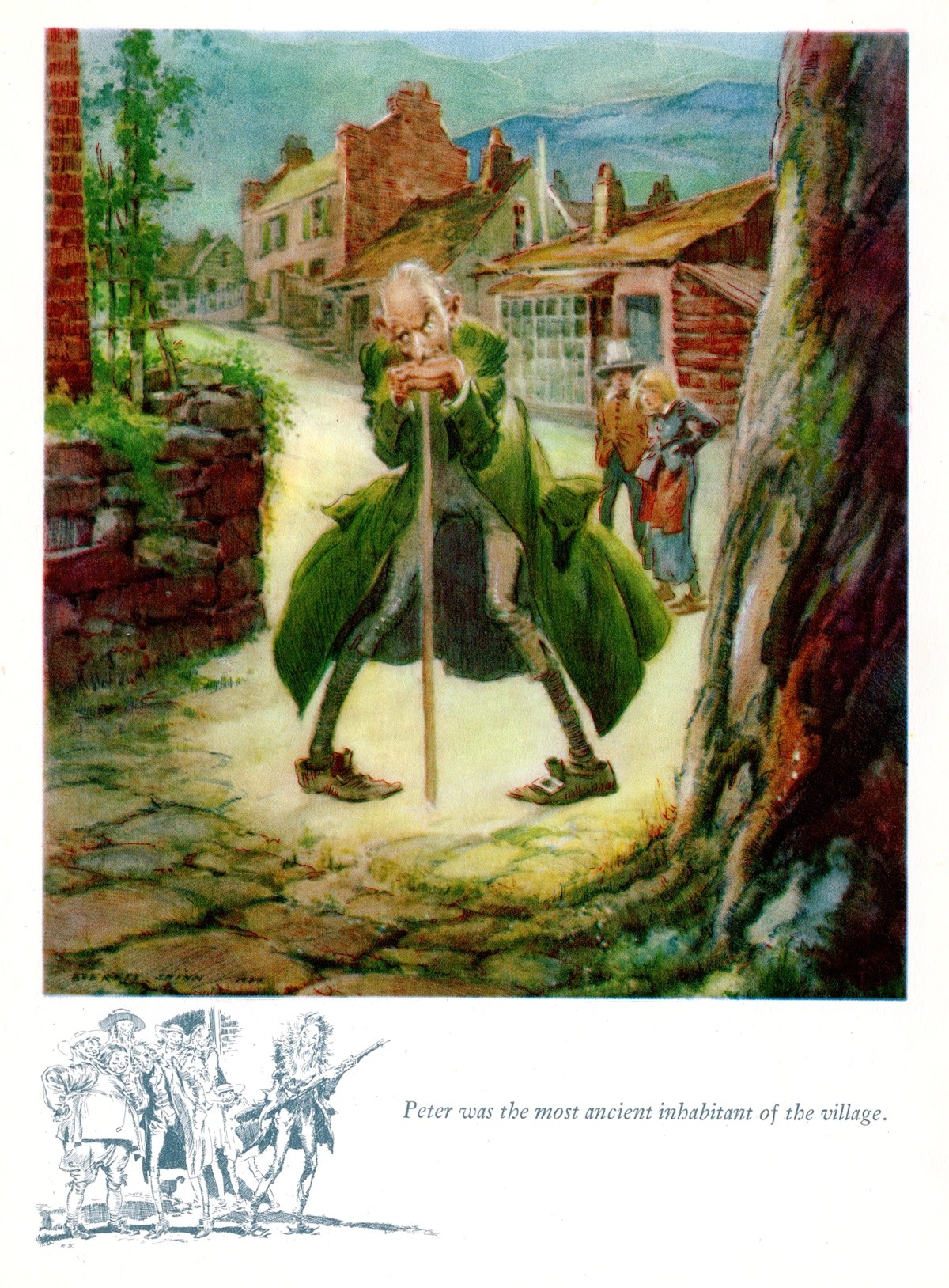
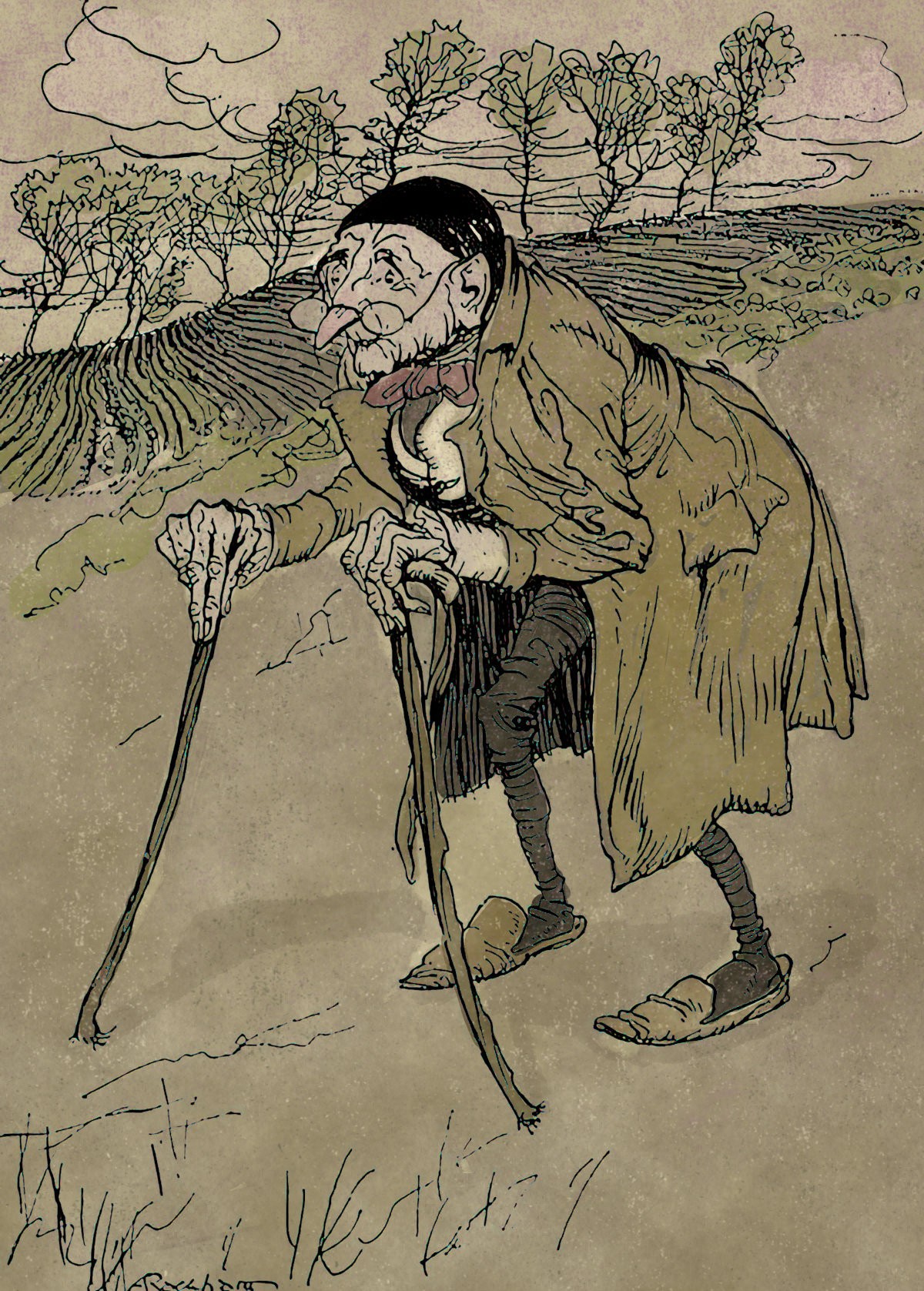
To make a long story short, the company broke up and returned to the more important concerns of the election. Rip’s daughter took him home to live with her; she had a snug, well-furnished house, and a stout, cheery farmer for a husband, whom Rip recollected for one of the urchins that used to climb upon his back. As to Rip’s son and heir, who was the ditto of himself, seen leaning against the tree, he was employed to work on the farm; but evinced an hereditary disposition to attend to anything else but his business.
This story marks the end of one era — one with little political mind, stuck in the old ways of fairies — and the beginning of the era of rationality, where the colonists of America ‘grew up’. Rip, with his childlike ways, represents the old folk and the older, more gentle way of life.
Rip now resumed his old walks and habits; he soon found many of his former cronies, though all rather the worse for the wear and tear of time; and preferred making friends among the rising generation, with whom he soon grew into great favour.
Rip’s interest in children endures.
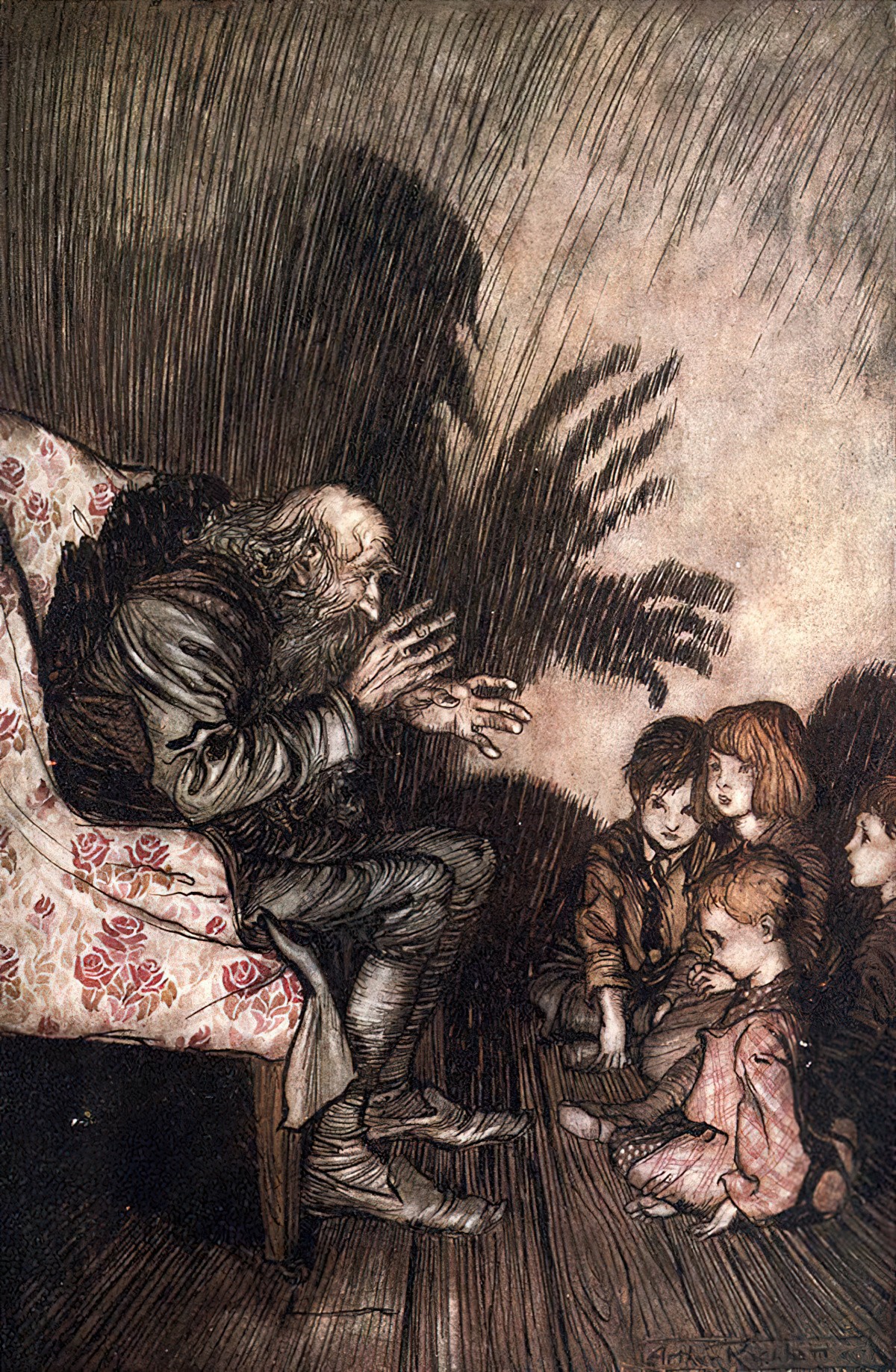
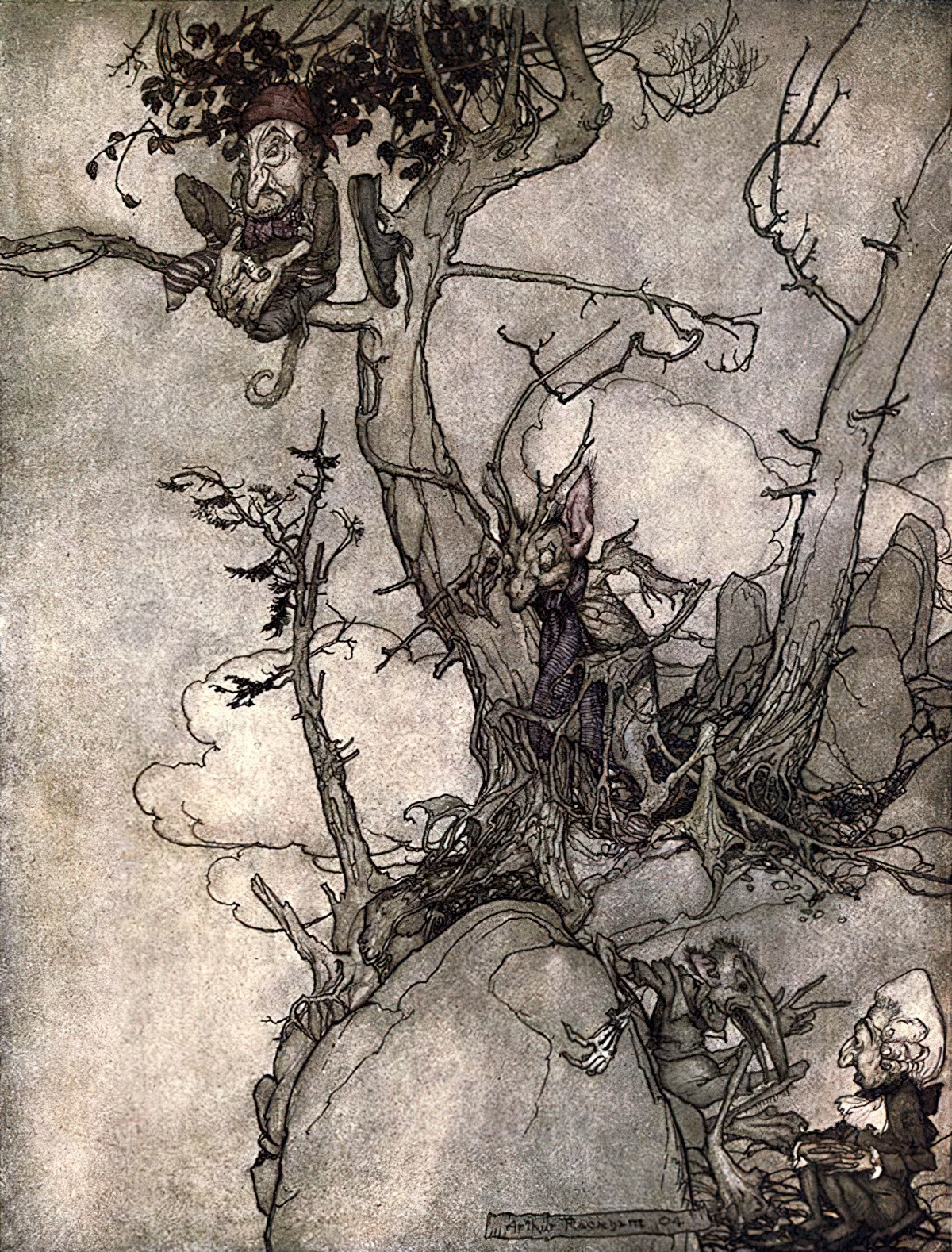
Having nothing to do at home, and being arrived at that happy age when a man can be idle with impunity, he took his place once more on the bench at the inn-door, and was reverenced as one of the patriarchs of the village, and a chronicle of the old times “before the war.” It was some time before he could get into the regular track of gossip, or could be made to comprehend the strange events that had taken place during his torpor. How that there had been a revolutionary war,—that the country had thrown off the yoke of old England,—and that, instead of being a subject of his Majesty George the Third, he was now a free citizen of the United States. Rip, in fact, was no politician; the changes of states and empires made but little impression on him; but there was one species of despotism under which he had long groaned, and that was—petticoat government. Happily that was at an end; he had got his neck out of the yoke of matrimony, and could go in and out whenever he pleased, without dreading the tyranny of Dame Van Winkle. Whenever her name was mentioned, however, he shook his head, shrugged his shoulders, and cast up his eyes; which might pass either for an expression of resignation to his fate, or joy at his deliverance.
If Rip has ‘nothing to do at home’, this is because women — notably his daughter — rally around him to make it so. He is now receiving the care from the daughter that he never gave her as a child. This narrator has been very harsh on the late Dame Van Winkle, but neglects to mention this great imbalance. The hard work of women was, and remains to this day, invisible.
I put it to you that the work of childcare is particularly invisibilised in this story. We are told that Rip plays with the children. Let’s take the narrator at his word, and Rip really is playing with the children. Child minding is not seen as work when a man does it, and is certainly not seen as work when a woman does it, because women and children go together in the misogynistic imagination, as if women-and-children is one inseparable word.
He used to tell his story to every stranger that arrived at Mr. Doolittle’s hotel. He was observed, at first, to vary on some points every time he told it, which was, doubtless, owing to his having so recently awaked. It at last settled down precisely to the tale I have related, and not a man, woman, or child in the neighbourhood but knew it by heart. Some always pretended to doubt the reality of it, and insisted that Rip had been out of his head, and that this was one point on which he always remained flighty. The old Dutch inhabitants, however, almost universally gave it full credit. Even to this day they never hear a thunder-storm of a summer afternoon about the Kaatskill, but they say Hendrick Hudson and his crew are at their game of ninepins; and it is a common wish of all hen-pecked husbands in the neighbourhood, when life hangs heavy on their hands, that they might have a quieting draught out of Rip Van Winkle’s flagon.
Since this is a story-within-a-story, it needs framing at both ends, which is the function of this paragraph. It also serves to persuade readers this story might actually be true, every single bit of it, including the universal statement about ‘hen-pecked husbands’.
The idea that the husbands in this village are ‘hen-pecked’ reminds me of the modern narrative about white men getting ‘cancelled’. These are literally the least hen-pecked husbands I’ve ever seen in fiction. They live the life of kings, with time and space to discuss and understand politics, while the women keep the village working behind the scenes.
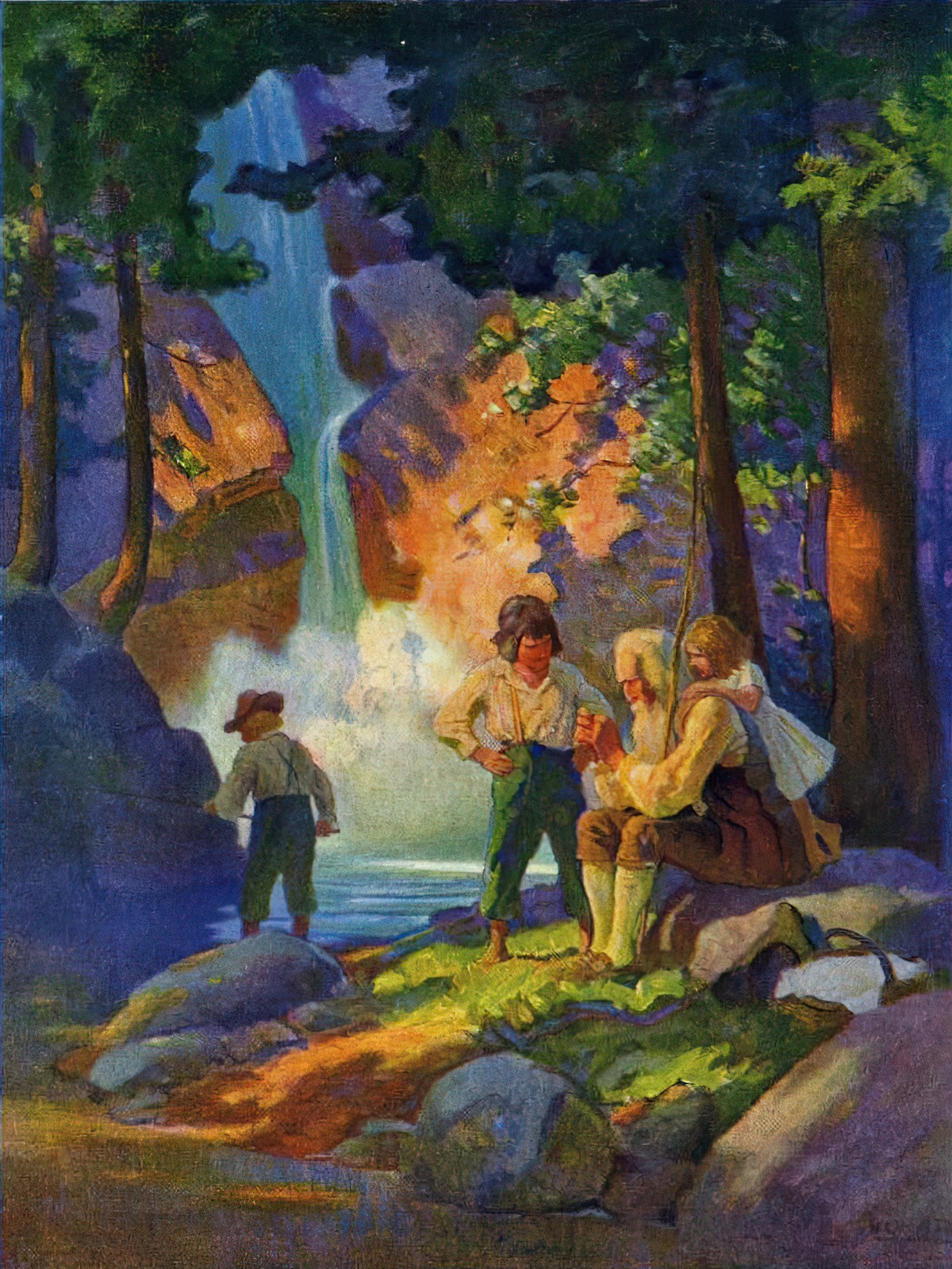
NOTE
The foregoing tale, one would suspect, had been suggested to Mr. Knickerbocker by a little German superstition about the Emperor Frederick der Rothbart, and the Kypphäuser mountain; the subjoined note, however, which he had appended to the tale, shows that it is an absolute fact, narrated with his usual fidelity.
In fact there are three diegetic levels to this story. It’s a story-within-a-story-within-a-story. This author really, really wants readers to consider it true, if only briefly. And if we won’t take away the ‘truth’ of the supernatural happenings, he wants us to walk away with a truth about mankind (and also about women, who should know their damn place).
“The story of Rip Van Winkle may seem incredible to many, but nevertheless I give it my full belief, for I know the vicinity of our old Dutch settlements to have been very subject to marvellous events and appearances. Indeed, I have heard many stranger stories than this, in the villages along the Hudson, all of which were too well authenticated to admit of a doubt. I have even talked with Rip Van Winkle myself, who, when last I saw him, was a very venerable old man, and so perfectly rational and consistent on every other point, that I think no conscientious person could refuse to take this into the bargain; nay, I have seen a certificate on the subject taken before a country justice and signed with a cross, in the justice’s own handwriting. The story, therefore, is beyond the possibility of doubt.
“D. K.”
POSTSCRIPT
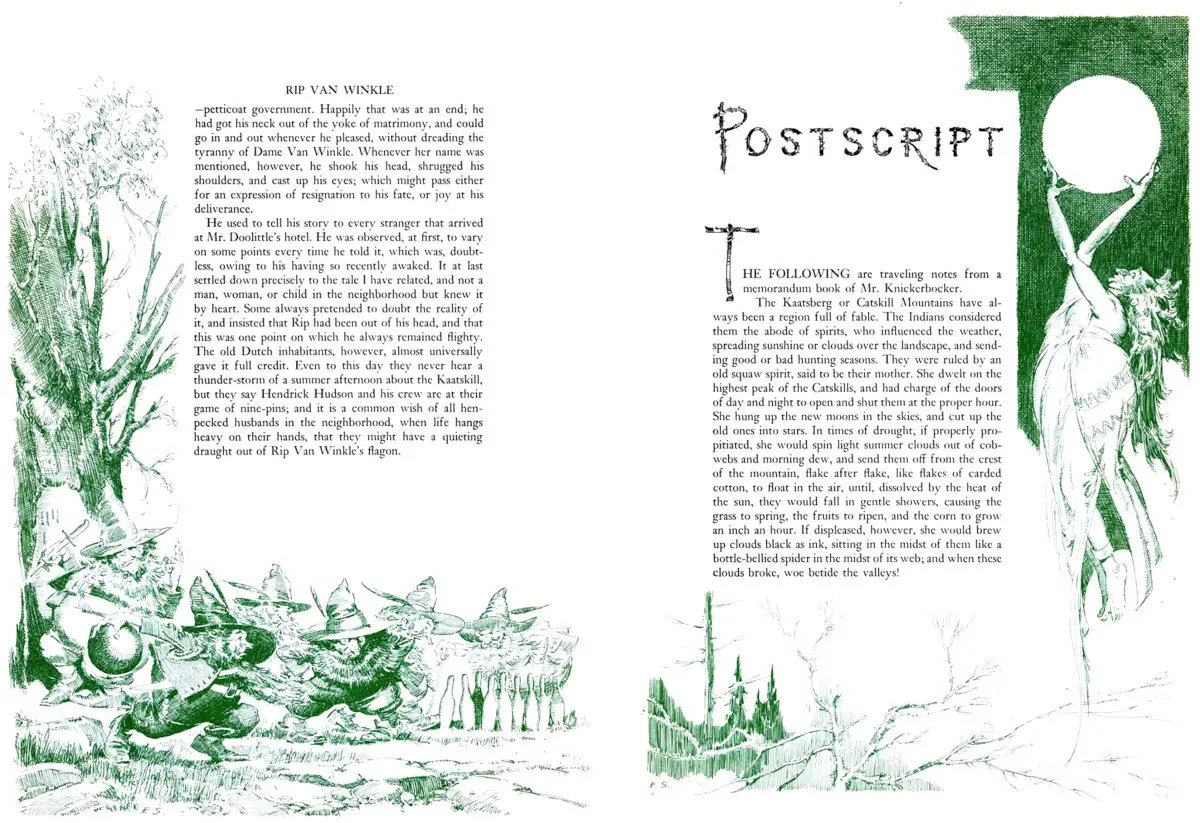
The following are travelling notes from a memorandum-book of Mr. Knickerbocker.
The Kaatsberg or Catskill mountains have always been a region full of fable. The Indians considered them the abode of spirits, who influenced the weather, spreading sunshine or clouds over the landscape, and sending good or bad hunting seasons. They were ruled by an old squaw spirit, said to be their mother. She dwelt on the highest peak of the Catskills, and had charge of the doors of day and night to open and shut them at the proper hour. She hung up the new moons in the skies, and cut up the old ones into stars. In times of drought, if properly propitiated, she would spin light summer clouds out of cobwebs and morning dew, and send them off from the crest of the mountain, flake after flake, like flakes of carded cotton, to float in the air, until, dissolved by the heat of the sun, they would fall in gentle showers, causing the grass to spring, the fruits to ripen, and the corn to grow an inch an hour. If displeased, however, she would brew up clouds black as ink, sitting in the midst of them like a bottle-bellied spider in the midst of its web; and when these clouds broke, woe betide the valleys!
Propitiate: win or regain the favour of (a god, spirit, or person) by doing something that pleases them.
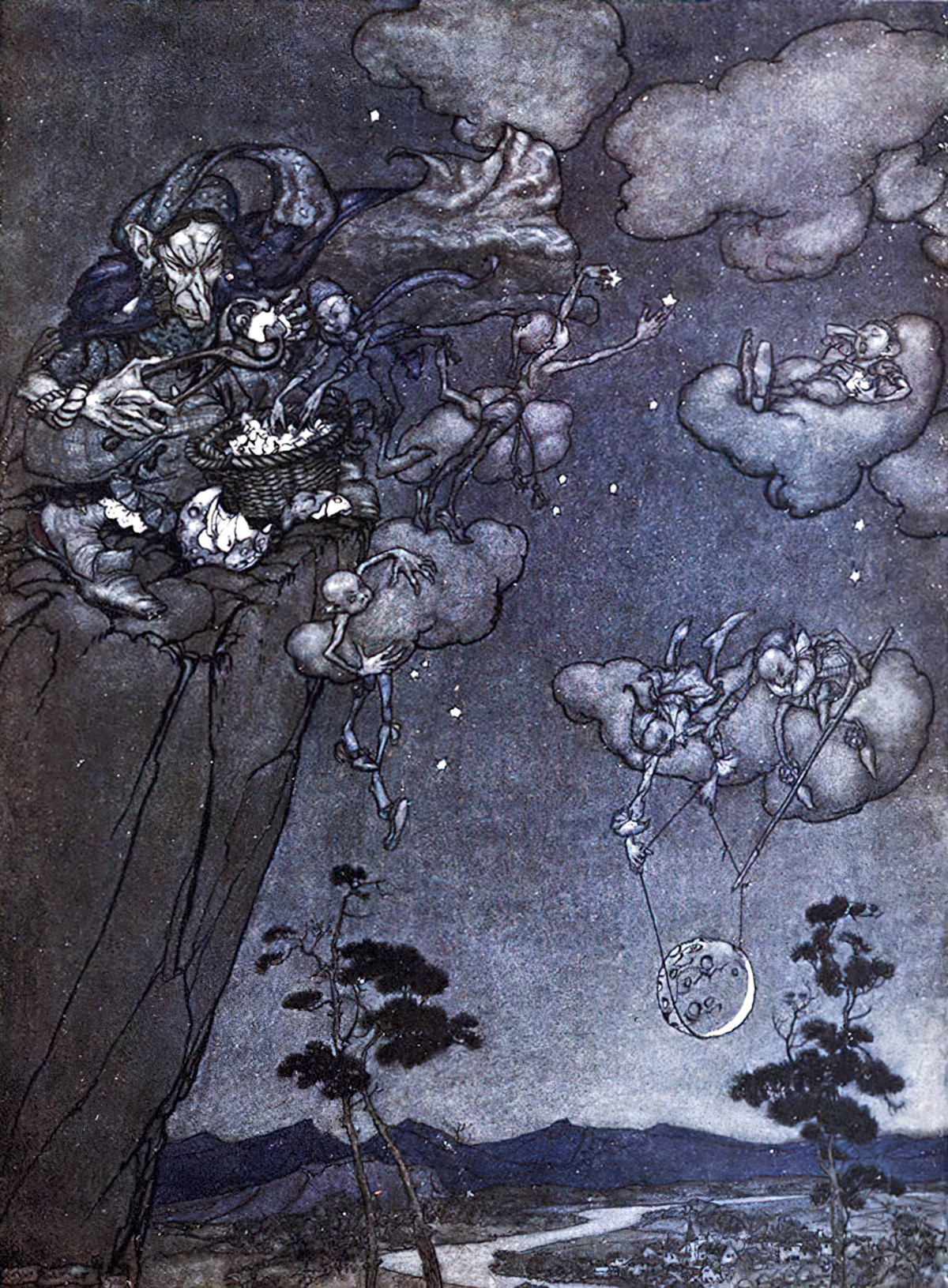
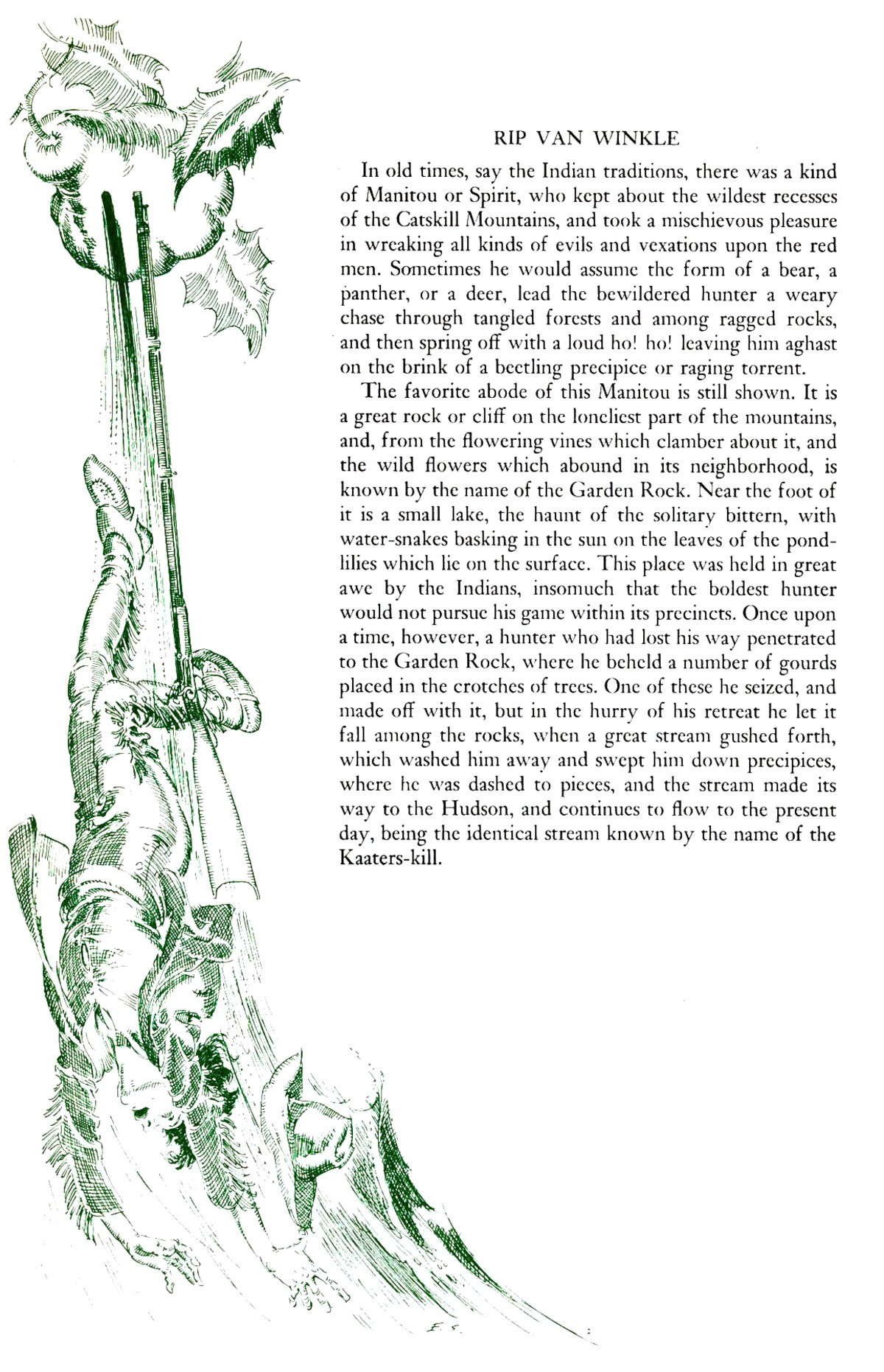
In old times, say the Indian traditions, there was a kind of Manitou or Spirit, who kept about the wildest recesses of the Catskill mountains, and took a mischievous pleasure in wreaking all kinds of evils and vexations upon the red men. Sometimes he would assume the form of a bear, a panther, or a deer, lead the bewildered hunter a weary chase through tangled forests and among ragged rocks, and then spring off with a loud ho! ho! leaving him aghast on the brink of a beetling precipice or raging torrent.
The favourite abode of this Manitou is still shown. It is a great rock or cliff on the loneliest part of the mountains, and, from the flowering vines which clamber about it, and the wild flowers which abound in its neighbourhood, is known by the name of the Garden Rock. Near the foot of it is a small lake, the haunt of the solitary bittern, with water-snakes basking in the sun on the leaves of the pond-lilies which lie on the surface. This place was held in great awe by the Indians, insomuch that the boldest hunter would not pursue his game within its precincts. Once upon a time, however, a hunter who had lost his way penetrated to the Garden Rock, where he beheld a number of gourds placed in the crotches of trees. One of these he seized and made off with it, but in the hurry of his retreat he let it fall among the rocks, when a great stream gushed forth, which washed him away and swept him down precipices, where he was dashed to pieces, and the stream made its way to the Hudson, and continues to flow to the present day, being the identical stream known by the name of the Kaaters-kill.
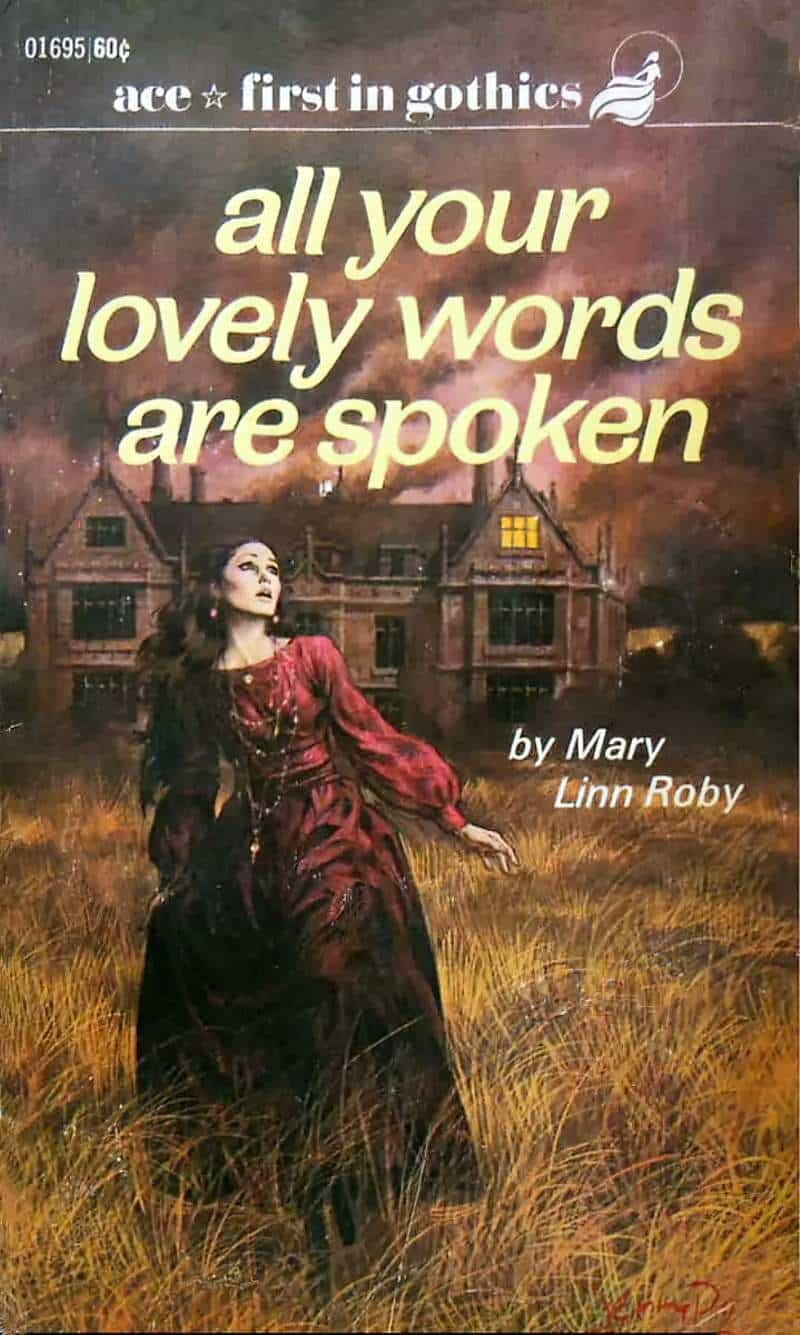
FURTHER READING
HEROINES, HARPIES, AND HOUSEWIVES
Today we are joined by Martha Moffitt Peacock, Professor of Art History at Brigham Young University about her new book, Heroines, Harpies, and Housewives: Imaging Women of Consequence in the Dutch Golden Age, out in 2020 with Brill.
In Heroines, Harpies, and Housewives, Peacock provides a novel interpretive approach to the artistic practice of imaging women of consequence in the Dutch Golden Age. From the beginnings of the new Republic, visual celebrations of famous heroines who crossed gender boundaries by fighting in the Revolt against Spain or by distinguishing themselves in arts and letters became an essential and significant cultural tradition that reverberated throughout the long seventeenth century. This collective memory of consequential heroines who equalled, or outshone, men is frequently reflected in empowering representations of other female archetypes: authoritative harpies and noble housewives. Such enabling imagery helped in the structuring of gender norms that positively advanced a powerful female identity in Dutch society.
New Books Network
